
Speaking , Skills

35 ESL Speaking Activities: Engage with Fun for Better Fluency
September 1, 2023
A H M Ohidujjaman

Have you ever found yourself, as an English teacher, scratching your head, trying to come up with new and engaging ESL speaking activities to get your students talking? You’re not alone. Speaking can be a tough skill to master for ESL learners, but if you can choose the right activities , you can turn this challenge into a fun and interactive learning experience for them.
In this article, you’ll discover 35 popular ESL speaking activities that really work. These activities are designed to get your students talking , whether they’re young learners or adults. They cover a range of scenarios, from casual chit-chat to formal presentations and everything in between. You can customize these activities based on your teaching methods to engage your specific learners.
So, if you’re on the hunt for fresh ideas to liven up your speaking class and help your students gain confidence in their spoken English, you’re in the right place. Let’s dive in and explore these activities together. Your next great class activity could be just a scroll away!
Table of Contents
Show and tell: engaging young minds.
Show and Tell is a classic activity that’s always a hit with young learners . It provides a platform for students to talk about something they’re passionate about, helping them practice their spoken English in a fun, personal way.
Materials Needed: The only materials required for this activity are the items that students choose to bring from home. These could be anything from a favorite toy to a cherished book or a family photo. The key is that the item should hold some significance to the student, giving them plenty to talk about.
Conducting the Activity:
- Let students know about the upcoming Show and Tell session well in advance so they have time to select their item and prepare what they want to say.
- On the day of the activity, each student takes turns presenting their item to the class.
- Students should describe their item, explaining what it is and why it’s important to them. They can also share any interesting stories or facts related to the item.
- To help students structure their presentations, you can provide sentence starters such as “This is my…”, “It’s special because…”, or “I feel… when I…”.
- After each presentation, encourage the rest of the class to ask questions. This promotes active listening and interaction.
Benefits of the Activity: Show and Tell offers numerous benefits for ESL learners. It:
- Helps students practice their descriptive language skills.
- Builds confidence in public speaking.
- Fosters a sense of community as students learn more about each other.
- Develops active listening skills as students engage with their peers’ presentations.
- Encourages curiosity and deeper understanding as students learn to ask relevant questions.
Incorporating Show and Tell into your ESL classroom can provide a fun, low-pressure way for students to practice their speaking skills while sharing a bit of their world with their classmates.
Role Play: The Power of Pretend in ESL
Role Play is a dynamic and versatile activity that can be tailored to suit any age group or proficiency level. It involves students acting out different scenarios, which can range from everyday situations like ordering food at a restaurant , to more complex interactions such as job interviews or debates.
Materials Needed: Materials for this activity can vary depending on the scenario you choose. You might need props to set the scene or role cards with character descriptions and objectives. For more complex role plays you might also provide conversation scripts for ordering food.
- Choose a scenario that is relevant to your students’ learning objectives and level of proficiency.
- Explain the scenario to the students and assign roles. If necessary, provide props, role cards, or scripts.
- Give students time to prepare for their roles. They might need to practice certain phrases, plan their dialogue, or think about their character’s motivations.
- Have the students act out the scenario in front of the class. Encourage them to stay in character and use English to the best of their ability.
- After the role-play, facilitate a class discussion. Ask students about the outcome of the scenario, the language used, and how they could apply what they’ve learned in real-life situations.
Benefits of the Activity: Role Play is a powerful tool in the ESL classroom. It:
- Provides a practical context for language use, helping students understand how to use English in real-life situations.
- Encourages creativity and improvisation, which can make speaking practice more engaging and fun.
- Helps students develop their problem-solving skills as they navigate through the scenario.
- Builds confidence as students get comfortable with speaking English in front of others.
- Allows for the practice of specific language functions, such as making requests, giving advice, or expressing disagreement, in a controlled environment.
By incorporating Role Play into your lessons, you can provide your students with a safe and supportive space to practice their English speaking skills, while also preparing them for real-world interactions.
Storytelling: Creating Narratives for Language Development
Storytelling is a universal form of communication that can captivate learners of all ages. In the ESL classroom, storytelling activities can help students practice narrative tenses, descriptive language, and sequencing, all while sparking their creativity.
Materials Needed: Materials can vary based on how you choose to conduct the activity. You might need story prompts, picture cards for visual aid, or even digital tools if you’re incorporating multimedia elements.
- Depending on your students’ proficiency level, you can provide a story prompt or let them come up with their own ideas.
- Give students time to plan their stories. They should think about the characters, setting, and plot. For lower-level students, you can provide a story structure to guide them.
- Students then tell their stories to the class. Encourage them to use descriptive language and narrative tenses where appropriate.
- After each story, facilitate a brief discussion. Ask the class about the story’s sequence of events, the characters, and the overall narrative. This can reinforce comprehension and narrative skills.
Benefits of the Activity: Storytelling offers numerous benefits for ESL learners. It:
- Encourages creativity and imagination, making the learning process more engaging.
- Helps students practice narrative tenses and descriptive language in a meaningful context.
- Enhances students’ ability to sequence ideas logically.
- Builds confidence in speaking as students share their unique stories.
- Fosters listening skills as students listen to and discuss each other’s stories.
Incorporating storytelling into your ESL lessons can provide a creative outlet for students while offering ample opportunities for language practice. Whether they’re telling tales of far-off adventures or recounting personal experiences, students will be developing their English skills every step of the way.
Picture Descriptions: Painting with Words
Picture Descriptions is an activity that can be adapted for learners of all ages and proficiency levels. It involves students describing a picture in detail, which can help them practice their descriptive language skills and expand their vocabulary.
Materials Needed: For this activity, you’ll need a variety of pictures. These could be photographs, illustrations, or even comic strips. The pictures should be rich in detail to give students plenty to talk about.
- Distribute a picture to each student or pair of students. You can also project a picture on the board for the whole class to describe.
- Give students time to look at their picture and think about how they will describe it.
- Students then take turns describing their picture to the class. Encourage them to be as detailed as possible, describing not only the main elements but also the colors, shapes, and any actions or emotions they perceive.
- After each description, you can facilitate a brief discussion. Ask the class about the details they remember, or have them guess what’s happening in the picture based on the description.
Benefits of the Activity: Picture Descriptions offers several benefits for ESL learners. It:
- Helps students practice their descriptive language skills in a focused context.
- Expands students’ vocabulary as they learn to describe various elements and scenes.
- Enhances students’ observational skills as they learn to notice and describe details.
- Builds confidence in speaking as students share their descriptions with the class.
- Fosters listening skills as students listen to and discuss each other’s descriptions.
By incorporating Picture Descriptions into your ESL lessons, you can provide a visual context for language practice, making the learning process more engaging and memorable for your students.
Interviews: Peer-to-Peer Learning

Interviews are a great way to get students to talk and listen to each other. This activity can be adapted to any topic, making it versatile for different lessons and proficiency levels. It’s an excellent way for students to practice question formation, active listening, and conversational skills.
Materials Needed: You’ll need a list of interview questions for this activity. These can be prepared in advance by the teacher, or you can have students come up with their own questions. The questions should be open-ended to encourage more than just yes/no answers.
- Pair up the students and give each pair a list of interview questions. If students are creating their own questions, give them time to prepare.
- One student in each pair takes on the role of the interviewer, while the other is the interviewee.
- The interviewer asks the questions, and the interviewee responds. Encourage students to expand on their answers and provide as much detail as possible.
- After a set amount of time, have the students switch roles.
- Once all interviews are complete, facilitate a class discussion. Students can share interesting things they learned about their partner or discuss any challenges they faced during the activity.
Benefits of the Activity: Conducting interviews in the ESL classroom offers several benefits. It:
- Provides a practical context for students to practice question formation and response.
- Enhances active listening skills as students engage in one-on-one conversations.
- Encourages students to express their thoughts and opinions in English.
- Builds confidence in speaking as students interact directly with their peers.
Incorporating interviews into your ESL lessons can provide a real-world context for language practice, helping students improve their conversational skills and build stronger connections with their peers.
Debates: The Art of Argument for Adult ESL Learners

Debates are a powerful tool for advanced language learning, particularly suited to adult learners. They provide a platform for students to practice persuasive language, critical thinking, and active listening, all within the context of a structured argument.
Materials Needed: For a debate, you’ll need a list of debatable topics that are appropriate and engaging for your students. You may also want to prepare some resources or reading materials for students to research their arguments.
- Divide the class into pairs or small groups and assign a debate topic to each. Make sure each group is clear on which side of the argument they are on.
- Give students time to research their topic and prepare their arguments. They should consider both their points and potential counterarguments.
- When it’s time for the debate, each group presents their arguments, alternating between the ‘for’ and ‘against’ sides. Encourage students to rebut and respond to each other’s points.
- After the debate, facilitate a class discussion. Ask students to reflect on the arguments presented and the language used.
Benefits of the Activity: Debates offer numerous benefits for ESL learners. They:
- Provide a practical context for students to practice persuasive language and argumentation.
- Enhance critical thinking skills as students have to construct and deconstruct arguments.
- Develop active listening skills as students need to respond to each other’s points.
- Build confidence in speaking as students present and defend their arguments.
- Encourage students to explore different perspectives on a topic, promoting empathy and understanding.
Incorporating debates into your ESL lessons can provide a dynamic and engaging way for students to practice their English speaking skills. Not only will they be learning to express their ideas more effectively, but they’ll also be developing valuable skills in critical thinking and active listening.
Information Gap Activities: Bridging the Gap
Information Gap activities are a staple in the communicative approach to language teaching. These activities involve students having different pieces of information that they need to share with each other to complete a task. It’s a great way for students to practice asking and answering questions, giving and following directions, and explaining ideas.
Materials Needed: The materials for this activity depend on the specific task. You might need task sheets with different information, maps with missing details, or incomplete diagrams. The key is that each student or pair of students has a piece of the puzzle, and they need to communicate effectively to put it all together.
- Divide the class into pairs or small groups and give each a different set of information.
- The task is for students to fill in the gaps in their information by communicating with their peers. They should ask questions, give answers, and clarify information as needed.
- Once students believe they have completed the task, check their work. If there are any mistakes or missing information, they should go back and continue the activity.
- After the activity, facilitate a class discussion. Reflect on the communication strategies used and the language practiced during the activity.
Benefits of the Activity: Information Gap activities offer several benefits for ESL learners. They:
- Provide a practical context for students to practice specific language functions, such as asking and answering questions.
- Encourage cooperative learning as students work together to complete the task.
- Enhance problem-solving and critical thinking skills as students figure out how to obtain the information they need.
- Build confidence in speaking as students interact directly with their peers.
- Foster active listening skills as students need to understand their peers’ information.
Incorporating Information Gap activities into your ESL lessons can provide a fun and interactive way for students to practice their English speaking skills. They’ll be learning to communicate more effectively while also developing valuable skills in problem-solving and cooperation.
Presentations: Public Speaking in ESL
Presentations are an excellent way for students to practice their public speaking skills in English. They can present on a topic of their choice or one assigned by the teacher, providing an opportunity to practice organizing and expressing their thoughts in a structured format.
Materials Needed: Students will need time to prepare their presentations. They may also need access to resources for research, and materials or technology for visual aids, such as PowerPoint slides or posters.
- Assign a topic or let students choose their own. The topic should be appropriate for their proficiency level and relevant to their interests or course content.
- Give students time to prepare their presentations. They should think about how to structure their talk, what information to include, and how to make their points clear and engaging.
- Students then deliver their presentations to the class. Encourage them to speak clearly, maintain eye contact with the audience, and use their visual aids effectively.
- After each presentation, allow time for questions and feedback from the class.
Benefits of the Activity: Presentations offer numerous benefits for ESL learners. They:
- Help students practice organizing and expressing their thoughts in English.
- Build confidence in public speaking.
- Enhance research and planning skills.
- Provide an opportunity for students to delve deeper into a topic of interest.
- Foster active listening skills as students listen to and discuss each other’s presentations.
Guessing Games: Fun with Descriptions for Young Learners
Guessing Games are a fun and interactive way for young learners to practice their descriptive language skills. In this activity, students describe a person, place, or thing without naming it, and the rest of the class tries to guess what it is.
Materials Needed: You’ll need a set of cards or pictures with different people, places, or things for the students to describe.
- Give a card or picture to a student, making sure the rest of the class can’t see it.
- The student describes the person, place, or thing on the card without saying its name.
- The rest of the class tries to guess what the student is describing.
- The game continues with different students taking turns to describe and guess.
Benefits of the Activity: Guessing Games offer several benefits for young ESL learners. They:
- Provide a fun and interactive way for students to practice their descriptive language skills.
- Encourage creativity as students think of different ways to describe the same thing.
- Foster active listening skills as students listen to the descriptions and try to guess the answers.
- Build confidence in speaking as students take turns describing and guessing.
News Report: Current Affairs in ESL
Creating a News Report is a dynamic activity that can help students practice formal language and reporting skills. It involves students researching a current event and presenting it as a news report, either individually or in groups. This enables learners to engage in conversations about the news in their daily lives.
Materials Needed: Students will need access to news resources for research. They may also need materials to create their news report, such as paper and pens for a written report, or a camera and microphone for a video report.
- Assign a current event or let students choose their own. The event should be appropriate for their proficiency level and relevant to their interests.
- Give students time to research the event and prepare their news report. They should think about the key facts of the event, the different perspectives involved, and how to present the information clearly and objectively.
- Students then present their news reports to the class. Encourage them to speak clearly, use formal language, and present the information in a balanced way.
- After each report, facilitate a class discussion about the event and the language used in the report.
Benefits of the Activity: Creating a News Report offers numerous benefits for ESL learners. They:
- Provide a practical context for students to practice formal language and reporting skills.
- Enhance research and critical thinking skills as students delve into a current event.
- Foster media literacy as students learn to analyze and present news information.
- Foster active listening skills as students listen to and discuss each other’s reports.
Problem-Solving : Collaborative Learning in ESL
Problem-Solving activities are a great way to get students working together and communicating in English. These activities involve presenting students with a problem or challenge that they need to solve collaboratively.
Materials Needed: The materials for this activity will depend on the problem you set. You might need puzzle pieces, task cards with the problem scenario, or physical materials for a building challenge.
- Divide the class into small groups and present each group with the same problem or challenge. This could be a riddle to solve, a mystery to unravel, or a structure to build.
- Students work together to solve the problem, discussing their ideas and strategies in English.
- Once the groups have completed the task, have them present their solutions to the class. Encourage them to explain their thought process and the steps they took to solve the problem.
- Facilitate a class discussion about the different solutions and the language used during the activity.
Benefits of the Activity: Problem-Solving activities offer several benefits for ESL learners. They:
- Encourage collaborative learning as students work together to solve a problem.
- Provide a practical context for students to practice their English speaking skills.
- Enhance critical thinking and problem-solving skills.
- Build confidence in speaking as students interact with their peers and present their solutions.
- Foster active listening skills as students listen to and discuss each other’s solutions.
The Mystery Bag: Sensory Language Practice
The Mystery Bag is a fun and interactive activity for practicing sensory language and descriptive skills. It involves students feeling an object in a bag and describing it to the rest of the class, who then try to guess what it is.
Materials Needed: For this activity, you’ll need a bag and a variety of objects with different shapes, sizes, and textures.
- Place an object in the bag without showing it to the class.
- Have a student feel the object in the bag without looking. The student then describes the object to the class, focusing on its size, shape, texture, weight, and any other sensory details.
- The rest of the class listens to the description and tries to guess what the object is.
- The game continues with different students and objects.
Benefits of the Activity: The Mystery Bag offers several benefits for ESL learners. It:
- Provides a fun and interactive way for students to practice their descriptive language skills.
- Encourages creativity as students think of different ways to describe the same object.
- Fosters active listening skills as students listen to the descriptions and try to guess the answers.
- Builds confidence in speaking as students take turns describing and guessing.
Playing 20 Questions: Inquisitive Minds at Play
Playing 20 Questions is a classic game that’s perfect for practicing question formation and critical thinking skills. In this game, one student thinks of a person, place, or thing, and the rest of the class asks up to 20 yes/no questions to figure out what it is.
Materials Needed: No specific materials are needed for this activity, although you might choose to use picture cards or word cards to provide ideas for the students.
- One student thinks of a person, place, or thing, or chooses one from a card if you’re using them.
- The rest of the class takes turns asking yes/no questions to figure out what the student is thinking of. They can ask up to 20 questions.
- The game continues until the class guesses correctly or they run out of questions.
Benefits of the Activity: Playing 20 Questions offers several benefits for ESL learners. It:
- Provides a practical context for students to practice question formation.
- Enhances critical thinking skills as students have to think strategically about their questions.
- Fosters active listening skills as students listen to the answers and adjust their guesses accordingly.
Speeches: Formal Language Practice
Giving speeches is a valuable activity for more advanced ESL students. It provides an opportunity to practice formal language, public speaking, and the organization of ideas. Speech topics can range from personal experiences to persuasive arguments on current issues.
Materials Needed: Students will need time and resources to prepare their speeches. Depending on the topic, they may need to conduct research. They may also need notecards for their speaking notes or technology for any visual aids they want to use.
- Give students time to prepare their speeches. They should think about how to structure their speech, what points they want to make, and how to support their ideas.
- Students then deliver their speeches to the class. Encourage them to speak clearly, maintain eye contact with the audience, and use their visual aids effectively.
- After each speech, allow time for questions and feedback from the class.
Benefits of the Activity: Giving speeches offers numerous benefits for ESL learners. It:
- Provides a practical context for students to practice formal language and public speaking.
- Enhances research and planning skills.
- Builds confidence in speaking in front of others.
- Fosters active listening skills as students listen to and discuss each other’s speeches.
Dialogue Journals: Interactive Learning
Dialogue Journals are written conversations between the teacher and student. While not a speaking activity per se, they can help students develop their conversational skills, grammar, and vocabulary in a low-pressure environment.
Materials Needed: Each student will need a journal for this activity. This could be a physical notebook or a digital document, depending on your preference.
- Each student starts by writing an entry in their journal. They can write about their day, ask questions, or respond to a prompt that you give them.
- You then read each student’s entry and write a response. Your response should model correct language use and may include comments, answers to questions, or further questions to keep the conversation going.
- The activity continues back and forth like this over time, creating an ongoing written dialogue.
Benefits of the Activity: Dialogue Journals offer several benefits for ESL learners. They:
- Provide a low-pressure environment for students to practice their English.
- Allow for individualized instruction as you can tailor your responses to each student’s needs.
- Enhance writing and reading skills alongside conversational skills.
- Foster a sense of connection between you and the student.
Charades: Non-Verbal Communication for Young Learners
Charades is a fun and interactive game that can help young learners practice their English vocabulary and sentence structure. In this game, students act out a word or phrase without speaking, and the rest of the class tries to guess what it is.
Materials Needed: You’ll need a set of cards with words or phrases for the students to act out. These could be verbs (like “jump” or “eat”), animals (like “cat” or “elephant”), or even simple sentences (like “I brush my teeth”).
- One student chooses a card and acts out the word or phrase without speaking or making any sound.
- The rest of the class watches and tries to guess the word or phrase. They should guess by making full sentences (like “Are you jumping?” or “Is it a cat?”).
- The game continues with different students taking turns to act and guess.
Benefits of the Activity: Charades offers several benefits for young ESL learners. It:
- Provides a fun and interactive way for students to practice their English vocabulary and sentence structure.
- Encourages creativity and physical movement, which can help keep young learners engaged.
- Fosters active listening skills as students listen to the guesses and adjust their acting accordingly.
- Builds confidence in speaking as students take turns guessing in full sentences.
Listening and Drawing: Visualizing Language
Listening and Drawing is an engaging activity that helps students practice their listening comprehension and following instructions in English. In this activity, students listen to a description or a set of instructions and draw what they hear.
Materials Needed: Students will need paper and drawing materials for this activity. You’ll need a script or a set of instructions to read out.
- Students start with a blank piece of paper. You read out a description or a set of instructions for something to draw.
- Students listen carefully and draw what they hear. They should not ask questions or confirm their understanding during the activity.
- Once the drawing is complete, students can compare their drawings and discuss any differences. You can also reveal the original image or intended result for comparison.
Benefits of the Activity: Listening and Drawing offers several benefits for ESL learners. It:
- Provides a fun and interactive way for students to practice their listening comprehension.
- Helps students practice following instructions in English.
- Encourages creativity and visual thinking.
- Fosters active listening skills as students need to pay close attention to the details.
- Builds confidence as students see the results of their listening skills.
Story Retelling: Reinforcing Narrative Skills
Story Retelling is a powerful activity to reinforce narrative skills, comprehension, and memory. In this activity, students listen to a story and then retell it in their own words.
Materials Needed: You’ll need a story for this activity. This could be a short story, a chapter from a book, or a story that you tell orally. The story should be appropriate for the students’ proficiency level.
- Read the story to the class or have them read it individually.
- Once they’ve heard or read the story, students take turns retelling it in their own words. They should try to include the main events and characters, but they can also add their own interpretations or details.
- After each retelling, facilitate a class discussion about the story and the different ways it was retold.
Benefits of the Activity: Story Retelling offers several benefits for ESL learners. It:
- Helps students practice narrative skills and comprehension.
- Enhances memory and recall as students have to remember and retell the story.
- Encourages creativity as students add their own interpretations or details.
- Fosters active listening skills as students listen to and discuss each other’s retellings.
- Builds confidence in speaking as students share their retellings with the class.
Find Someone Who: Interactive Icebreaker
Find Someone Who is a popular icebreaker activity that gets students up and moving. It involves students finding classmates who match certain criteria, providing a fun and interactive way for students to practice their question-asking and answering skills.
Materials Needed: You’ll need a worksheet with a list of criteria for this activity. The criteria could be things like “Find someone who has a pet” or “Find someone who has been to another country”.
- Give each student a worksheet and explain the activity. Students will walk around the room and ask their classmates questions to find someone who matches each criterion.
- Students interact with each other, asking questions and responding in English. They should try to find a different person for each criterion.
- Once students have found someone who matches each criterion, they can sit down. You can then facilitate a class discussion about what they learned about their classmates.
Benefits of the Activity: Find Someone Who offers several benefits for ESL learners. It:
- Provides a fun and interactive way for students to practice their question-asking and answering skills.
- Helps students get to know each other, fostering a sense of community in the class.
- Encourages movement and active learning.
- Fosters active listening skills as students need to listen to and understand their classmates’ responses.
Discussion Circles: Group Conversations in ESL
Discussion Circles are a great way to get students talking about a topic in depth. In this activity, students sit in a circle and discuss a topic, question, or text, providing a structured yet flexible way to practice conversational English.
Materials Needed: You’ll need a discussion topic or question for this activity. This could be a controversial statement, a thought-provoking question, or a text that students have read.
- Arrange the students in a circle and present the discussion topic or question.
- Students take turns speaking, giving their opinions, responding to each other, and asking follow-up questions. Encourage them to use appropriate discussion language and to listen actively when they’re not speaking.
- As the teacher, you can participate in the discussion, but try to let the students do most of the talking. You can also guide the discussion by asking probing questions or bringing up new points.
- After the discussion, facilitate a class reflection. Reflect on the content of the discussion as well as the language used.
Benefits of the Activity: Discussion Circles offer several benefits for ESL learners. They:
- Provide a structured yet flexible context for students to practice conversational English.
- Enhance critical thinking skills as students discuss a topic in depth.
- Foster active listening skills as students respond to each other’s points.
- Build confidence in speaking as students express their opinions and ideas.
- Encourage respect for different perspectives as students hear a variety of viewpoints.
Book Club: Literature in ESL
A Book Club can be a wonderful way for students to engage with English literature and practice their speaking skills. Students read a book (or a chapter of a book) and then discuss it in class, providing an opportunity to explore themes, characters, plot, and language in depth.
Materials Needed: You’ll need copies of the book for each student. Choose a book that is appropriate for your students’ proficiency level and interests.
- Assign a book or a chapter for students to read before the class.
- In class, facilitate a discussion about the book. Ask open-ended questions about the plot, characters, themes, and language. Encourage students to share their opinions and respond to each other’s comments.
- After the discussion, you can focus on specific language points from the book, such as vocabulary, grammar structures, or literary devices.
Benefits of the Activity: A Book Club offers several benefits for ESL learners. It:
- Provides a context for students to explore English literature and culture.
- Enhances reading comprehension and critical thinking skills.
- Fosters active listening skills as students respond to each other’s comments.
- Builds confidence in speaking as students express their opinions and ideas.
- Encourages a love of reading in English.
Dictation: Listening and Repeating
Dictation is a classic language learning activity that can help students practice their listening comprehension, spelling, and grammar. In this activity, you read a sentence or a short paragraph aloud, and students write down exactly what they hear.
Materials Needed: You’ll need a script for this activity. This could be a sentence, a paragraph, or a short text, depending on your students’ proficiency level.
- Choose a script that is appropriate for your students’ proficiency level and relevant to your lesson content.
- Read the script aloud at a normal pace. Students listen and write down what they hear.
- Repeat the script a few times, allowing students to fill in any gaps or correct any mistakes.
- Once the dictation is complete, reveal the written script. Students can then check their work and discuss any difficulties or challenges they faced.
Benefits of the Activity: Dictation offers several benefits for ESL learners. It:
- Helps students practice their listening comprehension in a focused way.
- Enhances spelling and grammar skills as students have to write down exactly what they hear.
- Provides a quiet, focused activity that can balance out more interactive or noisy activities.
Travel Agency Activity: Planning and Persuasion
The Travel Agency activity is a fun and interactive way for students to practice their persuasive language skills. In this activity, students work in pairs or small groups to plan a trip and then try to persuade the rest of the class to join their tour.
Materials Needed: You’ll need resources for students to research their trip, such as travel brochures, internet access, or travel books. You might also want to provide poster paper and markers for students to create their travel advertisements.
- Divide the class into pairs or small groups and assign each a destination. The destination could be a city, a country, or a type of trip (like a beach vacation or a cultural tour).
- Students research their destination and plan a trip, including the itinerary, accommodations, and attractions.
- Students then create a travel advertisement for their trip and present it to the class, trying to persuade their classmates to join their tour.
- After all the presentations, the class votes on which trip they would most like to join.
Benefits of the Activity: The Travel Agency activity offers several benefits for ESL learners. It:
- Provides a practical context for students to practice persuasive language.
- Builds confidence in speaking as students present their trip to the class.
- Fosters active listening skills as students listen to and evaluate each other’s presentations.
- Encourages creativity and teamwork as students work together to plan their trip and create their advertisement.
Job Interview Role-Plays: Preparing for the Real World
Job Interview Role-Plays are a valuable activity for more advanced ESL students. They provide an opportunity to practice formal language, answer common interview questions, and discuss career-related topics.
Materials Needed: You’ll need role-play cards for this activity. These should include a job description and a list of common interview questions.
- Divide the class into pairs and give each a role-play card. One student will be the interviewer and the other will be the job applicant.
- Students prepare for their roles, with the applicant thinking about how to answer the interview questions and the interviewer thinking about what they’re looking for in a candidate.
- Students then act out their role-play. After each role-play, facilitate a class discussion about the interview, the language used, and how to prepare for a job interview in English.
Benefits of the Activity: Job Interview Role-Plays offer several benefits for ESL learners. They:
- Provide a practical context for students to practice formal language and job interview skills.
- Enhance students’ understanding of job interviews and career-related topics.
- Build confidence in speaking as students act out different roles.
- Foster active listening skills as students respond to each other in the role-play.
- Prepare students for real-world situations, such as job interviews in English.
Story Cubes: Narrative Skills for Young Learners
Story Cubes are a fun and creative way for young learners to practice their narrative skills. In this activity, students roll dice with pictures on each face and then create a story based on the pictures that come up.
Materials Needed: You’ll need a set of story cubes for this activity. These are dice with different pictures on each face. If you don’t have story cubes, you can make your own with regular dice and a list of pictures corresponding to each number.
- One student rolls the story cubes and looks at the pictures that come up.
- The student then creates a story that includes all of the pictures. They can make the story as imaginative and creative as they like.
- The game continues with different students rolling the cubes and telling their stories.
Benefits of the Activity: Story Cubes offer several benefits for young ESL learners. They:
- Provide a fun and creative way for students to practice their narrative skills.
- Enhance creativity and imagination as students create their own stories.
- Build confidence in speaking as students tell their stories to the class.
- Foster active listening skills as students listen to and respond to each other’s stories.
Discussion Circles: The Power of Group Discussion
Podcast creation: modern learning for adult learners.
Creating a podcast is a modern and engaging way for adult learners to practice their English skills. In this activity, students work in pairs or small groups to create a podcast episode on a topic of their choice.
Materials Needed: Students will need a recording device for this activity. This could be a smartphone, a computer with a microphone, or a dedicated audio recorder. They’ll also need a topic for their podcast episode.
- Divide the class into pairs or small groups and assign each a topic for their podcast episode. The topic should be something they’re interested in and can research.
- Students research their topic and plan their podcast episode. They should think about what points they want to make, who will say what, and how to engage their listeners.
- Students then record their podcast episode. They can do this in one take or edit together multiple takes for a more polished result.
- Once the podcasts are complete, have a listening party where you play each podcast and discuss them as a class.
Benefits of the Activity: Creating a podcast offers several benefits for adult ESL learners. It:
- Provides a modern and engaging context for students to practice their English skills.
- Builds confidence in speaking as students record their podcast episodes.
- Fosters active listening skills as students listen to and discuss each other’s podcasts.
- Encourages digital literacy skills as students record and edit their podcasts.
Picture Story Activity: Sequential Storytelling
The Picture Story activity is a fun and creative way for students to practice their narrative skills and sequential language. In this activity, students arrange pictures to create a story and then tell the story to the class.
Materials Needed: You’ll need a set of pictures for this activity. The pictures should be able to be arranged in different ways to create different stories. I’ve written a complete guide on creating story sequencing pictures with ChatGPT and given away all the necessary prompts you use with little effort.
- Divide the class into pairs or small groups and give each a set of pictures.
- Students arrange the pictures to create a story. They should think about the sequence of events, the characters, and the plot.
- Students then tell their story to the class, using the pictures as a guide.
- After each story, facilitate a class discussion about the story and the language used.
Benefits of the Activity: The Picture Story activity offers several benefits for ESL learners. It:
- Provides a fun and creative way for students to practice their narrative skills and sequential language.
- Enhances creativity and imagination as students create their own stories.
- Builds confidence in speaking as students tell their stories to the class.
- Fosters active listening skills as students listen to and respond to each other’s stories.
Surveys: Data Collection and Discussion
Conducting surveys is a practical way for students to practice their question-asking and data-interpretation skills. In this activity, students create a survey, collect data from their classmates, and then discuss the results.
Materials Needed: Students will need paper and pens for this activity. They might also need resources to research their survey topic.
- Divide the class into pairs or small groups and assign each a survey topic. The topic should be something they can collect data on from their classmates.
- Students create a survey with a variety of question types, such as yes/no questions, multiple-choice questions, and open-ended questions.
- Students then conduct their survey, asking their classmates the questions and recording their answers.
- Once the surveys are complete, students analyze the data and present their findings to the class.
Benefits of the Activity: Conducting surveys offers several benefits for ESL learners. It:
- Provides a practical context for students to practice their question-asking and data-interpretation skills.
- Enhances research and analytical skills.
- Builds confidence in speaking as students conduct their surveys and present their findings.
- Fosters active listening skills as students respond to the survey questions and listen to the presentations.
Movie Reviews: Critical Thinking in Action
Writing and discussing movie reviews is a fun way for students to practice their critical thinking and persuasive language skills. In this activity, students watch a movie, write a review, and then discuss their reviews in class.
Materials Needed: You’ll need a movie for this activity. Choose a movie that is appropriate for your students’ proficiency level and interests. Students will also need paper and pens to write their reviews.
- Assign a movie for students to watch before the class. This could be for homework or you could watch the movie together in class if time allows.
- After watching the movie, students write a review. They should include a summary of the movie, their opinion of it, and reasons to support their opinion.
- In class, students share their reviews and discuss the movie. Facilitate a discussion about the different opinions and the language used in the reviews.
- You can use conversation questions to facilitate the discussions.
Benefits of the Activity: Writing and discussing movie reviews offers several benefits for ESL learners. It:
- Provides a fun context for students to practice their critical thinking and persuasive language skills.
- Enhances writing skills as students write their reviews.
- Builds confidence in speaking as students share their reviews and discuss the movie.
- Fosters active listening skills as students listen to and respond to each other’s reviews.
I Spy: Observation and Description
I Spy is a classic game that can be adapted for the ESL classroom to practice observation and descriptive language. In this activity, one student describes something they can see, and the other students guess what it is.
Materials Needed: This activity doesn’t require any specific materials. You can play it in the classroom using the objects and people that are present.
- One student chooses something in the room and says “I spy with my little eye something that…” and then gives a description. The description could be about the color, size, shape, or function of the object.
- The other students take turns guessing what the object is. The student who guesses correctly gets to describe the next object.
Benefits of the Activity: I Spy offers several benefits for ESL learners. It:
- Provides a fun and interactive way for students to practice their observation and descriptive language skills.
- Enhances vocabulary as students describe and guess different objects.
- Builds confidence in speaking as students describe objects and guess what others are describing.
- Fosters active listening skills as students listen to the descriptions and guesses.
Mock Trial Activity: Legal Language in Practice
A Mock Trial is a dynamic activity for more advanced ESL students to practice legal language and persuasive speaking. In this activity, students take on the roles of lawyers, witnesses, and jurors in a simulated trial.
Materials Needed: You’ll need a case for the trial. This could be a real case, a fictional case, or a simplified version of a complex case. You’ll also need role cards with character descriptions and information about the case.
- Divide the class into roles and give each student a role card. The roles could include lawyers, witnesses, jurors, and a judge.
- Students prepare for the trial, with the lawyers preparing their arguments and questions, the witnesses preparing their testimonies, and the jurors preparing to listen and make a decision.
- Conduct the trial, with the lawyers presenting their cases, the witnesses giving their testimonies, and the jurors listening and making a decision.
- After the trial, facilitate a class discussion about the trial, the language used, and the legal concepts involved.
Benefits of the Activity: A Mock Trial offers several benefits for ESL learners. It:
- Provides a practical context for students to practice legal language and persuasive speaking.
- Enhances students’ understanding of legal concepts and courtroom procedures.
- Builds confidence in speaking as students take on different roles.
- Fosters active listening skills as students respond to each other in the trial.
- Encourages critical thinking as students prepare their roles and make decisions during the trial.
Describing a Process: Sequential Language Practice
Describing a Process is a useful activity for students to practice sequential language and technical vocabulary. In this activity, students describe a process, such as cooking a recipe, assembling a piece of furniture, or conducting a science experiment.
Materials Needed: You’ll need a process for students to describe. This could be a recipe, assembly instructions, a science experiment procedure, or any other process that involves a sequence of steps.
- Assign a process for students to describe. This could be for homework or you could describe the process together in class.
- Students describe the process, using sequential language and the appropriate technical vocabulary. They should try to make their description as clear and detailed as possible.
- After the descriptions are complete, facilitate a class discussion about the process, the language used, and any difficulties or challenges in describing the process.
Benefits of the Activity: Describing a Process offers several benefits for ESL learners. It:
- Provides a practical context for students to practice sequential language and technical vocabulary.
- Enhances students’ understanding of process and procedure.
- Builds confidence in speaking as students describe a process in detail.
- Fosters active listening skills as students listen to and discuss the process descriptions.
Board Games: Learning through Play in ESL
Board Games are a fun and interactive way for students to practice English in a relaxed setting. In this activity, students play a board game, using English to discuss the game, make decisions, and interact with each other.
Materials Needed: You’ll need a board game for this activity. Choose a game that involves some level of language use, such as Scrabble, Pictionary, or a trivia game.
- Divide the class into small groups and give each a board game.
- Students play the game, using English to discuss the game, make decisions, and interact with each other.
- After the game, facilitate a class discussion about the game, the language used, and any new vocabulary or phrases that were learned.
Benefits of the Activity: Playing Board Games offers several benefits for ESL learners. It:
- Provides a fun and relaxed context for students to practice English.
- Enhances a variety of language skills, depending on the game.
- Encourages cooperative learning as students play together.
- Builds confidence in speaking as students interact in a low-pressure setting.
- Fosters active listening skills as students respond to each other during the game.
Cultural Exchange: Broadening Horizons in ESL
Activity Description: The Cultural Exchange activity is a fantastic way for students to learn about different cultures and practice their speaking skills. In this activity, students research a specific culture and present their findings to the class. This could be their own culture, the culture of an English-speaking country, or any other culture that interests them.
Materials Needed: Students will need resources to research their chosen culture. This could be books, internet access, or even interviews with people from that culture.
- Assign each student (or pair/group of students) a culture to research. This could be assigned by you, or students could choose their own.
- Students research their chosen culture, focusing on aspects such as traditions, customs, food, language, history, and more.
- Students prepare a presentation about their chosen culture. This could be a spoken presentation, a poster, a slideshow, or even a demonstration of a cultural activity.
- Students present their findings to the class. Encourage the class to ask questions and engage in a discussion about each culture.
Benefits of the Activity: The Cultural Exchange activity offers several benefits for ESL learners. It:
- Provides a meaningful context for students to practice their research and speaking skills.
- Enhances students’ global awareness and understanding of different cultures.
- Builds confidence in speaking as students present their findings to the class.
- Fosters active listening skills as students listen to and discuss each other’s presentations.
- Encourages respect for diversity and an appreciation for different cultures.
Conclusion: Choosing the Right ESL Speaking Activities for Your ESL Class
Choosing the right ESL speaking activities for your ESL class can make a big difference in your students’ engagement and progress. Consider your students’ proficiency level, interests, and learning goals when choosing activities. Remember that variety is key – a mix of quiet and noisy activities, individual and group work, and different types of language practice will keep your classes interesting and effective. Happy teaching!
1 thought on “35 ESL Speaking Activities: Engage with Fun for Better Fluency”
- Pingback: How to Choose the Right Speaking Activities for ESL Classes - ESL Info
Comments are closed.
FREE E-Book


Making English Fun
15 Of The Best ESL Speaking Games And Activities.
For English language learners speaking is probably one of the most important and most feared language skills they have to learn . They may be shy, in both languages, or they may be afraid of making a mistake in front of their friends or classmates.
One of the best ways to overcome this is to use English games and activities , introduce some fun into the lessons and these fears suddenly become less important.
We have been teaching English for a lot of years and here are 15 of the best English Speaking games and activities we have researched and trialed in our classrooms. They have been massively useful to us over the years, so we hope they are for you as well.
We have researched English Speaking Games for all levels, backgrounds and ages of students. Activities like the ”Yes/No game. Call My Bluff, On Call” can all be scaled to address student needs. Utilizing speaking games for students is a proven way of maximizing participation and retention of language.
It is important to try to over come students initial fears of speaking, No one likes to make mistakes or look foolish so creating a risk free and non judgmental environment in your classroom is vitally important.
I often try to speak in the students first language to show them that of course people make mistakes, and that is perfectly acceptable , of course some times funny, and nothing NOTHING to worry about!
This is a more difficult task with adult learners, but still achievable highlighting their motivations for learning the language and how it can benefit them at the beginning of sessions helps with this, especially if you go on to highlight how speaking is going to be the most important skill in the vas majority of these situations. In careers, social occasions and travel.
Speaking is the most important skill they will learn. One thing both younger and older students have in common? We all like to have fun. These speaking games below can all be adapted to suit either a Kindergarten classroom, ESL or otherwise, or a boardroom training session. There is something for every classroom situation.
Also where we have them on our site we will link to the files for you to download to make it more convenient for you. If you want to jump to a specific game just click on the list below .
Just before we jump into these 17 ESL Reading Games and Activities we have the four skills covered on the site. Speaking, Reading, Writing and Listening.
You can access the pages from the links below or click on the image to download them all in one PDF file for $2.99 or the price of a coffee ( a good one we admit! )
The Best ESL Games and Activities – 4 Booklets in 1
- The Best ESL Listening Games and Activities.
- The Best ESL Speaking Games and Activities.
- The Best ESL Writing Games and Activities.
- The Best ESL Reading Games and Activities.
English Speaking Games and Activities
- 30 Second Speech
- Logic Game – Downing Street
- ESL Directions Game
- Speaking Activities – Expressions
- Speaking Activities – Responses
- Mallets Mallet – Word Association Speaking Game
- Make a Wish – Speaking Game
- YES / NO Speaking Game.
- Pictionary – English Speaking Game
- Call My Bluff / Would I lie to you
- Show and Tell

1. 30 Second Speech
This English speaking activity is both fun and useful. The aim is to get students to speak for 30 seconds about topics that may or may not be out of their comfort zone. We have a list of topics here for you to choose from, and of course you can think of your own.
There are two ways to approach this, you can introduce the task by asking them to work individually first, or move straight onto the game below.
- Introduce the idea to the group and say that we will be focusing more and more on their speaking and presenting skills and that this lesson will be a bit of fun and good practice.
- Ask how long 30 seconds is…. Is it a long time? (Relative of course!)
- Say that they are going to be talking for 30 seconds about something they know about and that they have only 1 minute to prepare.
- You can work your way around the class, or split your class into teams to do this depending on
- Work your way round they class giving people a go at trying to speak for 30 seconds.
The 30 Second Speech game
As they practice the task above write the rules on the board and split class in half
- 1) Pick a subject
- 2) Talk for 30 seconds
- 3) No hesitation or repetition ( although of course they are learning so be lenient with this!)
- 4) If you can’t talk for 30 seconds the other team will get a chance to finish your time.
- 5) If they can finish the time they will get the points instead.
Adaptations:
- You can change the amount of time depending on the age and abilities of your students.
- You can choose topics that will appeal to your students, if professional students you can choose topics from their careers for example.
- To do this with varying abilities it is possible to change all aspects. From length of time speaking to the topics chosen.
- you can work as teams and make it competitive or run it as a whole class activity.
2. Logic Speaking Lesson – Downing Street
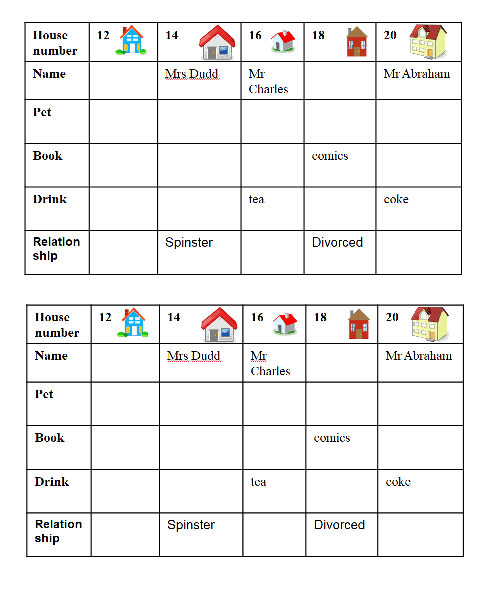
These type of activities used to be in puzzle magazines all the time. There sis a fair deal of explaining required to them but basically it s a logical fill in the blanks. It is better suited to higher level students, but its a great English Speaking game when adapted properly.
We have a separate page for the full details, and it is in this speaking exercise book ( free download ) but will highlight the basics here to see if it is something that fits your teaching needs.
The aim is to fill in the table with all the information so you know everything about the residents of Downing street. However you have to walk around and ask the rest of the class for that information, only once you have spoken to everyone will you be able to work it out . This is a great English speaking game that gets the whole class taking to each other, and forgetting about the language they are doing that in!
You will need the table worksheet for students to fill in and the list of information and clues both on the links includes here
- Pass out one clue and a table worksheet to fill in to each Student.
- If you have fewer than 20 participants, give each person more than one clue until you run out.
- If you have more than 20 students, cut up more than one copy of each and pass out duplicates to the group
- Do not let participants read each other’s clues.
- As they get the information they can start to fill in their table.
- They must speak and listen to identify, as a group, what they learn from each clue.
- The teachers role is to make sure they are speaking English and to point in the right direction if it gets a little confusing.
Once your students have the answers then it can be gone through together on the board or white board and it adds another speaking element to the lesson. This is a great speaking game for ESL students and other. It really encourages them to speak to each other. As an added bonus for teachers we get to act as facilitator rather than be stuck at the front of the classroom.
Adaptations: It is possible to add clues (carefully to make sure they fit the answers) doing this makes it much easier. The aim is to get the students speaking to each other not just the logic side of the activity.
3. Giving Directions Lesson plan
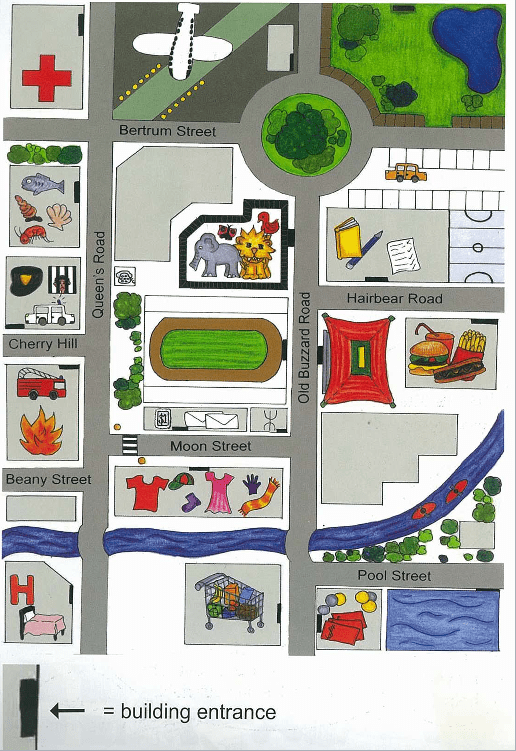
Ask and respond activities give students the comfort of a script to follow, which means those who are a little self conscious have some scaffolding to work from. It also means these activities are suitable for lower level students who need that extra help
Resources •A copy of a town map, or any town map printable from google for groups of students, a list of place names for students to pick from. We have one designed for younger learners here.
The activity.
- Chose a student from each team (make three teams if you can.) who will come to the front and pick a place to start from the bag and then will pick a place to finish.
- The students mentions the start building and then has to give directions to their team.
- His/her team has to follow as they describe the directions (obviously they cant say the name of the place or the building that they are supposed to go.) If the team has it right they get points.
- You can pre teach turn left, straight on, turn right as needed of course.
- Offer points as you see fit for each team
- Make sure as many get a chance to come to the front and speak as possible.
It is possible to actually have the directions already prewritten for students. This means they can practice reading, speaking and listening in one activity.
Also it is possible to have your class spend a lesson coming up with the directions themselves and then putting them all in a box or bag at the front for the whole class to use. This means you add writing and they are actually using their own work to prepare a lesson.
4. Speaking lessons – Expressions
One of the main problems when teacher oral English speaking lessons is that the class invariably turns into robots. This is not intentional, so much effort goes into speaking in another language that putting emotion and expression into what they are saying comes way , WAY down the list.
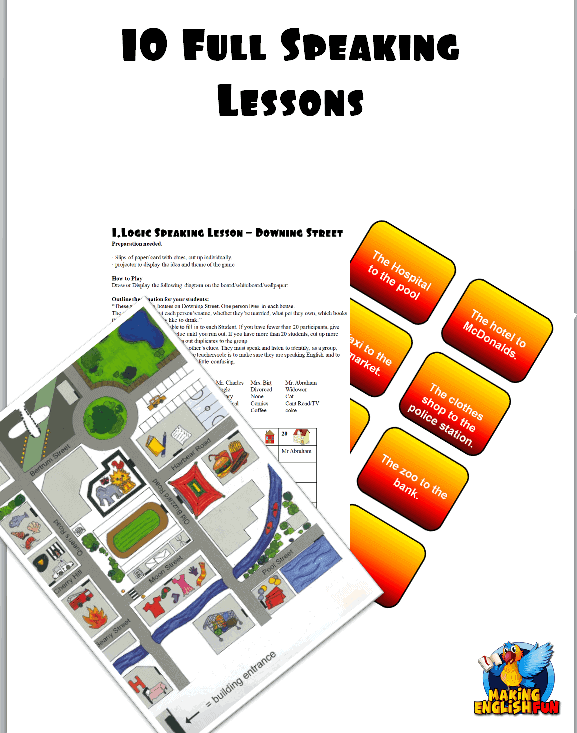
So sometimes a little nudge in the right direction is all they need. We have designed an ESL speaking game and lesson to do just that.
- We have a worksheet we have prepared for you with some sentences that will require a lot of expression.
- Write the word expression on the board and ask what is says and what it means
- Explain that although this word can mean making your voice have feeling or emotion, it is also your facial expressions.
- Show them what a voice without expression sounds like (you tube most boring voice in the world or something) or demonstrate yourself.. Let them know intonation and expression are SO important in English that they should try to think about them more.
- Give out the work sheet with examples of sentences on and see let them work out how they should say each sentence to make it more natural.
- Father TED Video here is a reasonable example of boring and dramatic voice. ( there is a bra in it in the first 5 seconds so set it up first if it is likely to cause problems )
- Remind them to try to use not only expression in their voice but in their face as well. Demonstrate how difficult it is to sound sad when you look happy and that by using facial expression it actually makes speaking English easier!
- Have the group work through the sayings and ask them to perform them together.
- As a fun activity write something random on the board (I like peas, where is my pen, I have won the lottery) and have emotions and feelings written on the board. Choose a student number and have them say a phrase normally and then point at a different emotion and see if they can say it like that. If you want to make it a competition see if the rest of the class can work out what emotion they are trying to act out.
- E.g.: Sad but won the lottery, happy but lost their pen etc.
Adding expression to their speech is a large step towards sounding natural and developing English fluency.
5. Responses Lesson
In English to sound more natural we have a set of almost automatic set of responses on hearing good, bad or surprising news. It doesn’t take much to teach these in ESL Speaking lessons and for ESL Students in particular it is a definite confidence builder for them.
- Greet the class and walk around offering compliments to people, you look nice; I like your hair, nice shirt…etc. See what responses you get from this.
- Write RESPONSES on the board and see if they have seen the word and if they can tell you what it means. Write up congratulations on the board and ask when they would say this. Illicit ideas from the group.
- Repeat but with my cute little rabbit died yesterday and see what they think the correct response should be.
- Give out the worksheet and ask them to work in pairs to see if they can write the correct response to the appropriate sentence. Give them a couple of minutes to do this. Longer if needed. Then choose a student to say one and another student / group to try to give the answer. Work through them all.
- Give life to the responses and let them know if they say sorry their voice has to mean it otherwise it might sound sarcastic. Same with congratulations etc. So expression is very important in English to make sure the correct meaning is conveyed!
- There are two spaces at the bottom for two sentences for them to write a sentence and then the appropriate response.
As a game you can then repeat the same sort or exercise as the activity above. Have a selection of sentences than usually require a response and then ask for the incorrect response. No one expects you to say congratulations when you tell them your little rabbits died yesterday!!!

6. Word Association Speaking Game
This English Speaking game, together with the YES/NO game below are tied for my favorite game to play with any age student ESL or other wise. They can, and have been, played with second language kindergarten students all the way up to native speaking business people with the same amount of fun. The language from the business people was perhaps a little ruder than the kindergarten children but only a little!
It is a superb English speaking game for ESL students and native speakers. It gets really REALLY competitive. you will need an inflatable hammer they have packs of 12 on amazon for about 12 dollars and that’s it!
This game is based on a old TV show from the UK called Wacaday. In it they had a rather colorful character called Timmy Mallet who, among other things, played a game called mallets mallet. In this game the players, always children, had to think of a word associated with whatever Timmy said. There was no hesitation, repetition, or ummm or errrrrs allowed or they got a bonk on the head. (softly of course) the winner was the one who didn’t get hit!
This is easier to show you than explain so here is a video of it! ( it was the 1980s so excuse the poor quality of the video, and of course the hair styles!)
Two students at a time come to the front and the teacher/helper gives them a word. They have to say a word related to the previous word in 3 seconds or less. They can not repeat, pause or say something unrelated.
If they get it wrong they get a ‘bonk’ on the head and 3 times bonked and a new pair or students comes up or you could even play winner stays on. For fun they can play against the teacher as well.
Here are some ideas.
- MacDonald’s
Water, drink, tea, coffee, sugar, sweet, sour …..
You can make this much slower than the video if you are working with second language or ESL students, and if you don’t want a hammer you can use a rolled up piece of paper or just play it as a point game without the hammer. (its more fun with one of course!)
7. Wish Speaking and Writing lesson.
This is a take on the TV Show Call my Bluff, where contestants have to guess who is lying. In this version students have to guess who wishes / wants what. They can do this by picking and reading a wish out of the bag and then trying to guess who it belongs to. They hav to give a reason why they think that.
Note: I have done this, or a version of this, many times without issue. However there was one time when a student wrote that they wished their parents would get back together which was pretty heartbreaking. Although it is superb to share, in front of a class of other students may not be the time or place. I did of course talk to her after and sought some help from others in the school. It may be worth while including instructions to keep it light.
- I do this by telling the class that i am not their teacher now, I am the genie from Aladdin and that I am going to give them three wishes, but one has to be to make the world a better place, one has to be for their family or friends and the last one can be for them. (And it can’t be I will have x more wishes)
- Give out some scrap paper and let them have a few mins to think about it then they have to write the wishes down but no names.
- Once completed say that we are going to have an activity. The class will have to guess whose wishes are whose.
- You will have three people at the front and need to mix up the pieces of paper. then hand them back to the students. Maybe they are mixed maybe they are not.
- One student at a time will read one of the lists of wishes and the rest of the class have to guess who they think the wishes belong to.
- You can continue till all the students have had a try.
Adaptations: This is also great as an Icebreaker activity for students and teacher to get to know each other. You can keep the activity as wishes or ask them to write three things about themselves. You can even change it to two things true and one lie to add some fun and creativity. ( and to create another English Speaking game called ”would I lie to you” or Call my Bluff.
8. Yes – No Game – Speaking Lesson
When I said that The Word Association game above and this game were tied as my favorite English Speaking game I lied. This is my number one game. It is just perfect for all levels of English learner. It can be made easier for younger and ESL students and learners and more difficult for higher levels. No matter what level of learner is in the class you can use this game.
Now watch the video to see someone very VERY good at asking the questions in action. (these are native speakers so of course he tries very hard to catch them out and speaks very quickly)
It is better to teacher this to students with at least a basic abilty, but it doesnt have to be high level as you can level the wuestion you ask.
Write up questions on the board and say that today we are going to look at question that are answered with yes/no. .
- The yes no game is from a TV show around the world, people have to come out and answer the questions the teacher (at first) asks. These will nearly all be yes or no questions.
- The student must not answer with yes or no, or nod their head or shake their head, or say uh huh etc etc.
- It sounds easy, but it isn’t!
- They will get carried away with this so take time to calm them down between students, and it is excellent practice for adding language to answers.
- Once they have the hang of it students can also be brought up to ask the questions. The activity then becomes student led and the teacher can observe and advise.
Tips: Ask questions starting with do you, can you , will you etc usually catch students out. Also you can repeat the students answer and add yes, or no to the end and it might catch them out to nod or repeat you.
It is simply awesome to play this and as I said earlier even 5 and 6 year olds quickly grasp this English speaking game. Once i have played it with my students it is the most requested speaking game every lesson following that.
9. Pictionary – English Speaking Game.
Allowing your students to communicate with each other takes off some of the pressure of a whole class environment and allows them to risk take with their English speaking in a less public arena
In this game, each student in the pair draws a picture, keeping their paper shielded from the eyes of their partner. Ideally, pictures should be fairly simple. Once the picture is complete, they explain to their partner, using words only, how to replicate the image this can be done at a desk or as a whispers type activity across school halls if you want a more physical speaking game.
For example, if a student has drawn the stereotypical square house with a triangle roof, he might say: “draw a house, with a red roof and blue door. He may miss out how many windows, the family in front of it or all manner of details.
This allows the teacher to compare the two drawings with the students and ask what language they could have added to get more details into the picture. This really enables students to start to think about expanding and adding to the phrases they say.
The goal of this game is for each partner to replicate the other’s drawing by listening and understanding these spoken directions. The difference in drawings is often pretty funny as well.

10. Guess who
Although you can use the Guess Who board game if you have it, its about 15 USD on Amazon if you have a need! It is probably easier and more adaptable for the culture or location you are teaching in to make a simple version with famous people from your area.
Students simpley draw the name of a famous person and photo if needed out of a hat (you’ll need to prepare these slips in advance!) and their partner or the rest of the class tries to guess who is on the paper by asking a series of yes/no questions.
it is a fun and engaging English speaking game that tests questioning knowledge.
11. Call My Bluff / Two Truths and A Lie
This is a similar game to the Make a Wish game above, but Call My Bluff is a more difficult and fun game which is perfect at the start of term as a ‘getting to know you’ kind of game. It is also a brilliant ice breaker between students if you teach classes who do not know one another — and especially essential if you are teaching a small class size .
The game is excellent for practicing English speaking skills , though make sure you save some time for after the game to comment on any mistakes students may have made during the game. (I generally like to reserve this for after the game, so you don’t disrupt their fluency by correcting them as they speak).
With older groups you can have some real fun and you might be surprised what you’ll learn about some of your students when playing this particular EFL game.
- Why use it? Ice-breaker; Speaking skills
- Who it’s best for: Appropriate for all levels and ages but best with older groups
How to play:
- Write 3 statements about yourself on the board, two of which should be lies and one which should be true.
- Allow your students to ask you questions about each statement and then guess which one is the truth. You might want to practice your poker face before starting this game!
- If they guess correctly then they win.
- Extension: Give students time to write their own two truths and one lie.
- Pair them up and have them play again, this time with their list, with their new partner. If you want to really extend the game and give students even more time to practice their speaking/listening skills, rotate partners or run as a whole class activity.
- Bring the whole class back together and have students announce one new thing they learned about another student as a recap
12. Doctors In

Actually this stems for a party (or drinking) game at universities and can be adapted to what ever vocabulary or topic you are teaching at the time. In the university version we all stick a post it to our foreheads and have to guess the famous person we are. Similar to the Guess who game above. In ESL or Classroom use we can do this with Jobs , animals, furniture, absolutely anything all you need are some post its or similar to stick to peoples heads or backs – anywhere they can not read it. It is a great ESL speaking game for classrooms with limited resources.
- Write the terms, problems or vocabulary you want on to Post It Notes and stick to the students back.
- The Students must walk about asking questions of their students on the word, yes and no questions work better, but longer ones can be used.
- Hopefully Students will be able to get enough information to guess what their word is.
- This game can be adapted for old or young students, or even university students 😉
13. Show and Tell
This classic classroom activity still has a place in modern classrooms. Students simply bring in something they would like to Show and Tell to their classmates. It practices students speaking ability, and their ability to prepare short written scripts that they will have to read. For those not talking it practices their listening ability, especially if you add a could of quiz questions at the end of each show and tell part.
You can change this by having a mystery box and they have to describe the item with out looking to their classmates and have them try to guess ( or the student of course) what it is.
Maybe its because i am writing this just a couple of days after Christmas, but I notice there are a lot of party games in this list. It might be that, but it might also be because they just work. Everyone, young and old, likes to have fun and these games provide that in abundance. Taboo is no exception.
It is simply a deck of cards, you can make your own or pick up a glossy set on Amazon for not much. On the card they have one target word and four words underneath. The player, in one minute or what ever time limit you decide to set has to try to explain what the target word is with out mentioning it, or the four related words underneath.
The beauty of this game is that you can adapt it to whichever topic you have been studying and make it easier or more difficult depending on the age and abilities of your students. It works in ESL and native speaking classrooms.

15. Think Fast
This is a nice physical game for warm up or for end of class consolidation. You just need a bean bag and some ideas.
It is similar to the Mallets Mallet Word assocation game above but involves the who class rather than pairs at the front.
- First have your students stand facing each other in a circle, or as much of one as you can make if you are in a classroom.
- Then explain that you are going to say a topic, maybe animals, or colors anything.
- When you do you are going to throw the ben bag or ball at a student ( to catch not hurt!) and when they catch they have to then say something in that topic,
- Then throw the ball on to another student in the circle.
- That student has to do the same, but it has to be a different word. If they get it wrong, pause or repeat they have to sit down and wait fo the next round.
This is great fun and students of ALL ages get into it very quickly. You can also allow then to pick their own subjects after a few goes.
The simple fact is that students of all ages learn better when they are having fun. If you can try to incorporate some of these English Speaking games and activities into your lessons then you will find that more and more your students are willing to engage and practice the language you are teaching them. There are hundreds more activities, but these are our favorites. We have a booklet of ten of them for free download if you want an idea of some of the resources behind them, but we will also be putting them up on the site as time goes by so you can take them individually as you need.
Hope these helped you as much as they have helped us!

Hi I’m Marc. A teacher of over 15 years, English, General Studies and Outdoor Education. Thought it was about time to sharing both what I have learnt during that time and the resources I have put together. On this site we aim to teach the theory and share our thoughts, but also go that one step further and give you access to the hard resources you need for your class or for you children
Share this:
- Click to share on Twitter (Opens in new window)
- Click to share on Facebook (Opens in new window)
- Click to share on Pinterest (Opens in new window)
- Click to share on WhatsApp (Opens in new window)
- Click to email a link to a friend (Opens in new window)
Making English Fun!
I have been a teacher of English for over 15 years, in that time i made hundreds and thousands of resources and learnt so much i think its worth sharing. Hopefully to help teachers and parents around the world.
Similar Posts
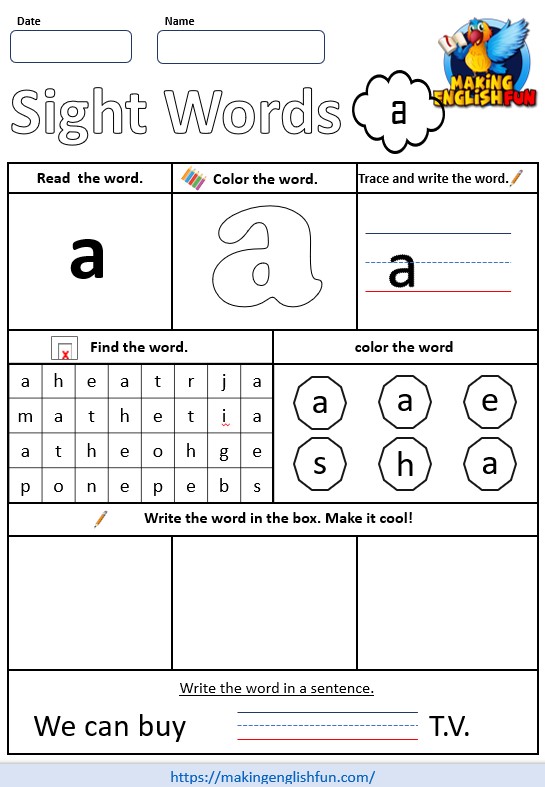
FREE Dolch Sight Word Worksheets – ‘a’
The sight word “a” is one of the first and most fundamental words young learners encounter – aside from their names! It serves as an indefinite article that precedes a noun to indicate a singular, non-specific entity. Designed for educators, ESL instructors, and parents, this resource includes a printable sight word worksheet to help children…

Teach Your Monster to Read Mini-games Instructions
An introduction to the Minigames on teach your monster to read website. All these are free to access and really useful for self directed as well as classroom use!
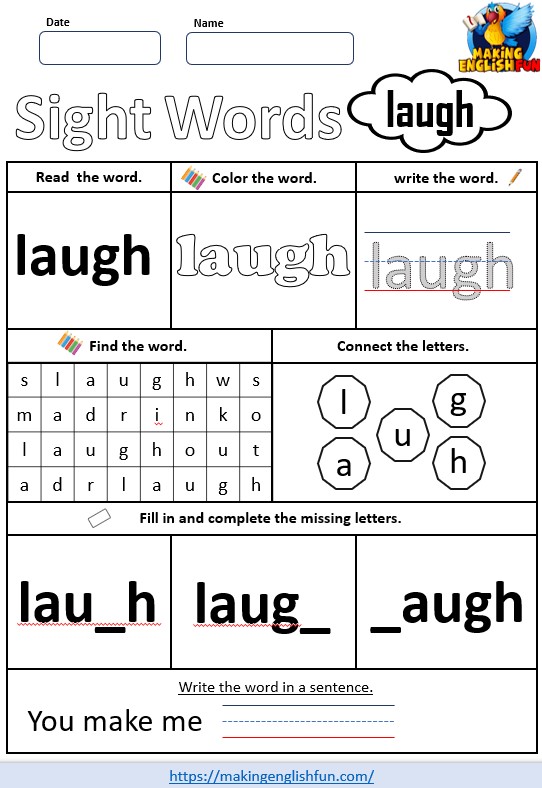
FREE Printable Grade 3 Dolch Sight Word Worksheet – “Laugh”
The sight word “laugh” introduces Grade 3 students to expressions of joy, humor, and happiness, making it a crucial term for their emotional and social development. .This guide, tailored for educators, ESL instructors, and parents, includes a printable worksheet designed to help children master “laugh,” enhancing their ability to discuss and share moments of joy…

Making English Fun has an Online Store!
The resources are increasing on the site by quite a rate now and they take a serious amount of time to put together. I am of course still offering them for free in both the teaching resources section and in the new store. However over the course of the next month i will be changing some to PDF from PowerPoint so if you want to download the editbale ones for free now is the time!

Where Are ESL Teachers In Demand In The USA?
Globally there is a shortage of ESL teachers, but even closer to home, in the USA, it is becoming increasingly difficult to find and recruit good, well qualified English as a Second Language teachers. As immigration continues to increase, and populations expand this is becoming more of an issue for many states in the USA….
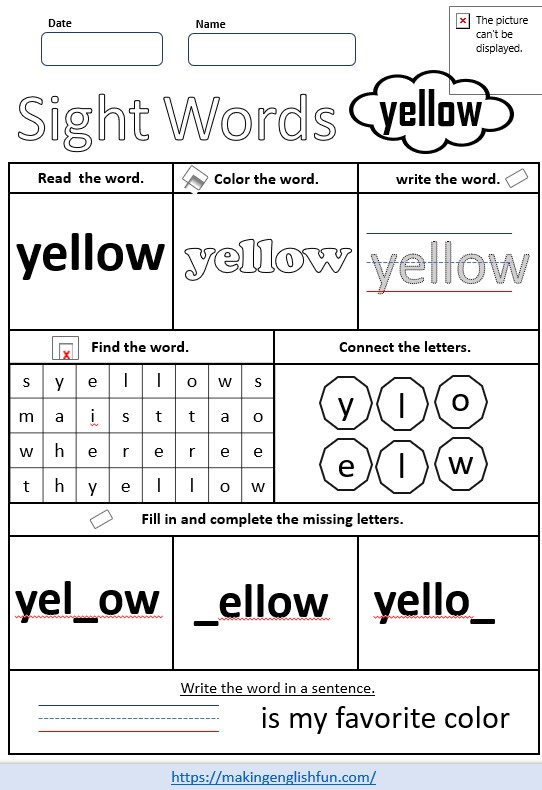
FREE Pre – K Dolch Sight Word Worksheets – ‘yellow’
The sight word “yellow” brings a splash of color to the world of early literacy, introducing young learners to one of the primary colors and enriching their descriptive vocabulary. Tailored for educators, ESL instructors, and parents, this guide features a printable worksheet designed to help children master the sight word “yellow,” enhancing their ability to…
- Pingback: How to Make English Lessons More Fun - Making English Fun
- Pingback: Why is English Hard for Russian Speakers? (And Teaching Tips) - Making English Fun
- Pingback: Is Teaching ESL Hard? A Teaching Abroad Survival Guide. - Making English Fun
- Pingback: How To Teach Pronunciation To Grade 1 - Making English Fun
Always welcome thoughts and comments, new blogs can be lonely!! Cancel reply
Check out our Premium Products in the shop today Dismiss
Discover more from Making English Fun
Subscribe now to keep reading and get access to the full archive.
Continue reading
You must be logged in to post a comment.


15 Speaking Projects And Activities For ESL Students
I don’t think I am sticking my neck out too much by saying that most ESL students enjoy speaking activities more than typical reading, writing and listening activities. Tending to be more dynamic, true to life and fun, a good speaking activity can really enhance an ESL student’s fluency and confidence.
Here, I am going to offer you a series of ESL speaking projects that you can adapt and use for your ESL students. Let’s go:
Infomercial Activities
This is one of my favorite speaking projects by far. Show students some typical adverts from a shopping channel; I like to show some of the funnier products just for giggles and to encourage students minds to wander, take a look at this compilation to see what I mean.
Next, I ask students usually in pairs to come up with their own completely original product to sell on an infomercial. If students struggle to come up with a completely new product you can suggest they add a new twist to arnold product, or make a new product based on a combination of two or more others.
For example, in the past I have had: microwave televisions, hair dryers that double as vacuum cleaners and laptops that double as portable stoves.
I tend to also do a language lesson based around the language of selling and persuasion so that when students make their infomercial they will send realistic and they often like to know some of the sales phrases, tactics and strategies that are used in real life.
Just for fun, you can tell students that they have a certain amount of money to spend and after they have seen all the infomercials they get to spend it. Sales can be recorded and you can see which idea/pair has made the most money and are the winner!
Presentations
Give students a presentation of a topic of your choosing, perhaps your own hobby and model the format and language that you want the students to use.
I tend to share slides with the student with the title of each slide already inserted. Students then have to fill the space with suitable information for that slide.
So, for example, if I wanted my students to present their own hobbies then I would probably have six slides titled with questions:
What is my favorite hobby? Why did I start this hobby? What have I achieved doing this hobby? Who do I do this hobby with? What will I do next in this hobby? Other interesting info about my hobby.
Students then fill the slides full of pictures that relate to the question and then they talk about these to the group and answer questions.
Some students always want to write out a script for a presentation which I let them do on the understanding that they can’t actually read it when they present. I allow them to write it out just so they can build up some confidence in what they are going to say and check the language accuracy of it.
I do usually place sentence starters and linking words on posters behind the audience so that the presenter always has some support if needs be.
Of course, this could also be done as a recorded video task. I sometimes ask students to record a voice over on top of the slides. This can then be converted into a video format for sharing later.
A few other simple presentation topic titles for ESL students that could be used are: My Best Friend, Who Am I?, My Pets, My Future Career, My Family, The Last Celebration I want to, Why I am a fan of __________ (insert name of whatever they are a fan of).
At this point you might also want to read one of my popular article about how to make your students speak English , here
Hot Seat ing
Become an expert – As it sounds. Students spent a certain amount of time researching a topic that either they choose or that is given to them. They are then to become that character and the rest of the group has to ask them questions to find out as much as they can about them in a set amount of time.
You can award points for correct questions being asked and for grammatically correct sentences in response. Personally I like to do this at the beginning of a new topic and direct students to research different famous people.
For example, if we are going to be covering the topic of Travel as in the IGCSE ESL then I have students research characters, such as: Dr Livingstone, Joe Simpson, Ernest Shackleton, Amelia Earhart, Ranulf Fiennes, and so on.
I often have students create a mini glossary for their characters as well which other students can refer to as they are quizzing the character.
This activity is best for intermediate level and above students and even then you may need to provide texts at a suitable level for students to be able to access, otherwise students end up on Wikipedia reading very difficult text.
You can have the group make notes and write summaries of each character for homework if you also wish to work on summary writing skills.
Recommended reading: 15 Research Projects For ESL Students
The Detective Game
For this activity you make up a crime that occurred in a given location, the more gruesome the better and if you can personalise it to your location and environment more the better.
Divide the group into smaller groups of three or four people and then ask them to create their alibis for the morning, afternoon, or evening in question. These people are the suspects.
One group, however, is assigned as being the investigators and they individually quiz different suspects one to one to try and find inconsistencies in their group’s stories. This forces each group to consider exactly what they were doing, where and with whom very carefully and in great detail.
After interviewing as many members of each group and making notes about inconsistencies between group members the investigators then confer with each other to decide upon which group’ alibi is the most inconsistent. This group are then sent to jail.
Whilst the investigators are discussing this, the suspects discuss which investigator was the best at questioning them and finding out the inconsistencies. The suspects will then announce who this person is, and they earn a promotion. Finally, the investigators announce the losing group which will go to prison.
This ‘game’ has got real legs and could go in so many different directions, so don’t be afraid to improvise and have fun with this one.
Drama Activities
Acting out a chapter of a book. Pretty much as it sounds. Read through a chapter of a book with students or have them read it for homework before letting groups act out the chapter, or a scene from it.
This works well even if they all act out the same scene as each group will learn from the last and the acting/performance and language should get increasingly better throughout. Alternatively arrange it so that each group acts out the following scene to the last group and so the full story is told.
Storyboard and act out the student’s own story. Rather than act out a book, you could have students plan out a story, or at least part of a story on a storyboard. This can give a greater sense of ownership, achievement and ‘buy in’ from the students.
What happened next. Read the opening of a book and as a ‘cliffhanger is reached’ pause and have students work together to act out the ending of the story or the next scene at least.
This also works well with videos from YouTube, crime videos work well as do Walt Disney cartoons – even with adult learners for some reason!
You might also be interested in reading my helpful article on how to get your students speaking fluently , here.
Mind Map ping
Vocabulary relationships. Engage students in a subject which contains lots of relationships of cause and effect. Basically, you need to pick a topic and analyse what the different factors were that affected the main decision or characters involved.
In the centre of your mind map place the decision or a character that was made and then arrange influencing factors around this.
The larger the circle each factor is in and the closer it is to the centre of the paper the stronger the influence is. Students then need to explain their mind map and the relationships to the group. Others can question and agree/ disagree with them.
Topics can range from serious issues from history through to celebrity scandals, or even plots in a movie, such as, why did celebrity couple X and Y get divorced, or why did actor x decide to y in the movie xyz. Obviously, you can let the students self select these issues for greater interest.
Backs To The Board
A timeless classic not so much a speaking project but this can be developed into a full lesson’s worth of speaking and it works for groups of all sizes. It is excellent for reviewing vocabulary at the end of a project or to see what students know at the beginning of a topic.
Simply split the group into teams of no more than five and have one member of the group come to the front and sit with their back to the board.
The other members of the group form a ‘u’ shape around the person, or, rather than being sat literally against the board groups can be sat at tables with just one student having their back to the board.
All you then need to do is to write a word on the board and the students facing the board have to get the person not facing the board to say the word without literally telling them the word. They should be encouraged to use definitions, synonyms and examples of the word where possible.
Depending on numbers, students can just shout out when they think they have the answer, or with large groups I make the students raise their hand if they think they have the answer.
The danger with debates is that to the teacher they may seem boring, or at least they do to me but have to remind myself that just because I have done the debates dozens of times, they haven’t and even the most overdone/boring sounding debates may go down like fireworks with some groups.
With that in mind here are a few of the more traditional/boring debates for your students to get their teeth into:
Which is better, country life or city life?
Should animal testing be allowed?
Should school uniforms be gotten rid of
Are cats better than dogs?
Should women be paid as much as men?
Online learning is better than classroom learning
Does money equal success in life?
I also like to see if there is something going on in the students view of the world that is worth debating. For example, in Thailand the debate over whether Korean pop music is better than Thai pop music is a popular one.
I have had colleagues dive into debates about serious political topics with higher level students which have worked really well.
However, some topics are just too hot to handle and you don’t know who you are upsetting so be careful what topics you do debate, you never know who is listening, or who is going to offense at any of your personal views that you may let slip!
Here is a good resource for more ESL debate ideas .
Book And Movie Review s
This is pretty much as it sounds. I like to set a reading task for students over a holiday break and when they return they have to submit a video review of the book or movie they watched/read.
I usually show them a good movie review for ideas and ask them to follow the same format. Something like this review of Kung Fu Panda . This goes along the lines of: background information, main characters, plot explanation, favorite moments, final recommendation.
I’ve also done this with higher level groups for documentaries but with enough support and speaking frames pre intermediate students can engage well with this activity.
Conversation Question s
Don’t underestimate the value of pure lists of conversation questions. Students are often happy to just ‘have a chat’ and use the English that they do know.
It is great for their confidence and fluency, as well as requiring zero lesson prep, which is always a nice thing. Just be sure to rotate speaking partners to avoid students getting bored with the same partners and used to different accents.
Sometimes, depending on ability and interest levels I will teach three or four idioms at the beginning of the lesson and set the task of trying to naturally drop them into conversation later on.
There are lot of good sources of conversation questions, here are a couple: eslconversationquestions.com and esldiscussions.com .
ESL Exam Preparation Material
Some students are hugely motivated by doing well in exams such as the IELTS test, and IGCSE ESL speaking tests. Exam boards for tests such as these produce a plethora of practise material that is often available for free online and ready to be use.
My students particularly enjoy the IELTS speaking part 2 task where they are required to speak about a given topic and are given three bullet points to talk about. They are given one minute to prepare their ideas before they have to speak on their own for two minutes.
If you think your students might enjoy this then here are some good sources of free IELTS style questions: IELTS IDP and ielts-exam.net , and for IGCSE ESL speaking questions check out the role play paper here.
The added bonus of these activities is that there is always a grading criteria ready to be used so you can grade students and give them real reasons why they scored a certain level and what they need to do to score higher in the future.
Here are the IELTS speaking criteria for example which clearly spells out what is expected of students at different levels.
Finger Puppet Shows
One really good way to get shy students speaking I have found to introduce sock puppets. As silly as it sounds, there is something about using a puppet that takes away the pressure on the speaker and frees them up to speak.
Whether it is the element of hilarity of speaking sock or the fact that people are generally looking at the sock rather than the person it seems to work well.
Depending on the ability level I will either give pairs of students scripts to act out with puppets. They can introduce their own props as well to make it even more funny. Alternatively, I will do this as an improv.
I will read out a situation, for example, one of you has lost their passport at the airport. Then the students have to act out this scenes as best as they can.
Switch partners and introduce more situations and watch the energy level of the room pick up!
By the end of the lesson you may well notice previously shy students speaking confidently with other students having been drawn into the magic of sock puppets! A great little speaking project.
Role Plays With Idioms
I use this lesson pattern quite regularly and it works well. I start off with student matching idioms to meanings and then to example sentences with the idioms missing.
After going through these answers and doing any teaching necessary to aid understanding I will then hand out a dialogue but with all the sentences jumbled up.
Students then have to unjumble the conversation which contains one or more of the idioms being used in a natural way. Next, they read the dialogue through taking different roles each and then doing the dialogue again without looking at the words.
Next, students are given the task of creating their own dialogues using at least one of the idioms in an appropriate way. Students write out the dialogues, rehearse them and then act them out for the group.
You can also do this with phrasal verbs but either way it works out well and the routine can be used again when you are a bit short of material or are having a hangover day!
Barrier Activities
One favourite of mine that never fails to stimulate plenty of language use is to simply create your own barrier exercise. I like to get a nice chunky newspaper article related to what we are learning and then go through each paragraph and remove key details, such as: names, dates, place names, times, location etcetera…
I create two versions of this, the first one will have words missing from odd number paragraphs and the second copy will have words missing from even number paragraphs.
This prevents it from becoming confusing and make sure to keep one master version with no details missing and if you have time highlight the missing words in red so it is easy for students to check later.
Once the missing word copies are ready you can divide the class into two halves distributing sheet A to one half and sheet B to the other half. Allow them to work in groups at this point to work out what questions they need to ask the other half of the group in order to get the missing details filled in.
If you think this will be too difficult for them you can provide the questions in a jumbled up format so they have to rearrange them to make the questions,, or even give them the questions but they have to work out the order in which to ask them to correspond to the paragraph order.
After this preparation period students can then pair up with someone from the opposite half of the group to take turns asking and answering each other’s questions.
Make sure that students do not show each other their articles and simply just sit and copy the answers, clearly this simply defeats the whale point of the exercise.
Before starting this I also pre teach any tricky vocabulary that I know is going to come up in the article just to make sure the final questions and answer session goes without too much stopping and starting to ask about vocabulary.
After students have got the answers then you can either display the answers on an overhead projector, or send students back to their original half of the group to see if they have all gotten the same answers.
Jigsaw Reading
This is another easy way to get students involved in the language and speaking. Select a relevant article related to the topic you are studying and chop it up into paragraphs. Hand out A4 paper with a simple one column table with as many boxes as there are paragraphs.
Hand out the paragraphs to the students considering which paragraphs are more difficult and should go to the higher level learners and which are slightly easier and can go to the lower ability students.
Individually, students now summarise in their own words as far as possible their paragraphs and write the summary in a box in the table. Following this students pair up with students who had a different paragraph and they then read out their summaries whilst the other students make notes of it.
Rotate partners so that everyone can get every paragraph and after the first couple of times students have read their summaries, force students to turn over their paper and explain their paragraph from memory.
After the first couple of goes they should be able to do this and by the time they have explained to everyone in the group they should be reeling off their summary very comfortably.
A Word On Differentiation …
There is a lot of fun to be had for the students in the above activities but it is important to not forget that some students will require more support than others. Just asking students to do a role play with no support may be too much for some.
Always consider using speaking frames, having sentence starters placed around the room, ‘useful language’ handouts, and always show a clear model of what it is you are expecting the students to produce.
If you can tick those boxes then your speaking lesson will go that bit more smoothly.
All the best with your ESL speaking projects!
Recent Posts
Can I Teach IELTS Without a Certificate or Qualifications?
The IELTS test is a key part of many non-native speakers' journey into entering a university in a native English-speaking country, such as the UK, or Canada. Teaching IELTS is a great way to gain...
How Bad Grammar Can Change Meaning (Real Examples)
Many people dismiss grammar as being unimportant. They claim that grammar adds little meaning to communication and is an unnecessary complication. Although grammar may change over time, it is still a...


Effective ESL Speaking Activities for Students of All Levels
These ESL speaking activities have the simple aim of encouraging students to speak openly and freely, with minimal support, in order to achieve their communicative goals. Only in these situations can we really gauge a student’s progress and discover their strengths and weaknesses. On this page, you will find suggestions for speaking games and activities that range from simpler, more controlled interactions to wide-ranging free-speaking activities.
ESL Conversation Starters
Explore hundreds of discussion questions , organized into themed cards for easy printing and cutting out. If you find this resource valuable, consider our photocopiable conversation classes book , featuring questions across 50 topics, along with supplementary exercises to introduce relevant vocabulary and idioms that enrich discussions.
Discussion and Presentation Style Speaking Activities
Expressing opinions.
Expressing Opinions: Ideal for first classes with advanced students, this mingling activity encourages learners to exchange opinions and cards with classmates.
Question Time
Question Time: In this easy-to-set-up group discussion activity , students take turns selecting a topic and moderating the conversation.
Old School vs New School
Students compare school life today with the past in this thought-provoking discussion exercise.
The World in 20 Years: Future Predictions
Using the simple future tense , students speculate about developments across various fields.
Show and Tell
Learners bring in objects with personal significance to share their stories.
Ask the Expert
Resembling a speed-dating activity, students interview each other about their hobbies and interests.
Questionnaires and Surveys
Students create surveys and questionnaires , using them to interview their peers and foster interaction.
Other Activities
Outdoor activities.
Escape the hot, stuffy classroom and reinvigorate your students with outdoor activities they’ll enjoy.
Lying Games
Encourage laughter and fun in the classroom with speaking games that challenge students to keep a straight face.
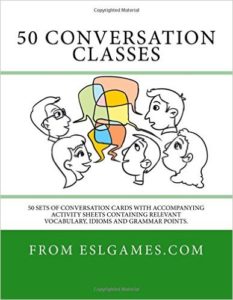
Boost Your Students’ Fluency with Our Photocopiable Conversation Cards
Looking for an engaging way to help your students practice their English speaking skills? Our ESL Conversation Questions section has hundreds of discussion questions grouped into themed cards for printing and cutting out. But if you’re serious about improving your students’ fluency, you need our A4-sized book of photocopiable conversation cards!
With questions covering 50 topics, our book is perfect for teachers who want to provide their students with meaningful opportunities to practice speaking English. Each card is designed to encourage natural conversation, boost your students’ confidence, and improve their fluency. But that’s not all – our book also includes additional exercises presenting relevant vocabulary and idioms to support the discussions.
Don’t just take our word for it – here’s what some of our satisfied teacher customers have to say:
“ My TEFL students love this book!! I quite often use it with them, to introduce the next part of the lesson. Thumbs up from me!! ” – Sarah T.
“ I love to use this in my classes so much because I always get such a surprise reaction from my students as they relate to the questions on a personal level and bring into the total discussion such rich experiences. ” – Juan M.
Ready to get started? Purchase our 50 ESL Conversation Classes book now.
4 thoughts on “ effective esl speaking activities for students of all levels ”.
Love this book! I will be taking an ESL teacher training course in a few months. In my present volunteer job, I’ve been asked to teach some English to the staff. They are all beginner to intermediate level. We are in a rural area of a poor country, so there aren’t many resources available, except what I can print out. Your book will help me do some fun conversation classes with them. Thanks for the great ideas!
This conversation class book is brilliant! I’m very happy both with the sample, which I got first, and the purchase of the whole book. I’ll be using it for years!
I`ve been using “50 conversation classes” since I started working with adult people and It`s great! We love them! thanks a lot!
Se ve muy interesante. Podría obtener una prueba gratuita?
Leave a Comment Cancel reply
Your email address will not be published. Required fields are marked *
This site uses Akismet to reduce spam. Learn how your comment data is processed .

English Current
ESL Lesson Plans, Tests, & Ideas
- North American Idioms
- Business Idioms
- Idioms Quiz
- Idiom Requests
- Proverbs Quiz & List
- Phrasal Verbs Quiz
- Basic Phrasal Verbs
- North American Idioms App
- A(n)/The: Help Understanding Articles
- The First & Second Conditional
- The Difference between 'So' & 'Too'
- The Difference between 'a few/few/a little/little'
- The Difference between "Other" & "Another"
- Check Your Level
- English Vocabulary
- Verb Tenses (Intermediate)
- Articles (A, An, The) Exercises
- Prepositions Exercises
- Irregular Verb Exercises
- Gerunds & Infinitives Exercises
- Discussion Questions
- Speech Topics
- Argumentative Essay Topics
- Top-rated Lessons
- Intermediate
- Upper-Intermediate
- Reading Lessons
- View Topic List
- Expressions for Everyday Situations
- Travel Agency Activity
- Present Progressive with Mr. Bean
- Work-related Idioms
- Adjectives to Describe Employees
- Writing for Tone, Tact, and Diplomacy
- Speaking Tactfully
- Advice on Monetizing an ESL Website
- Teaching your First Conversation Class
- How to Teach English Conversation
- Teaching Different Levels
- Teaching Grammar in Conversation Class
- Members' Home
- Update Billing Info.
- Cancel Subscription
- North American Proverbs Quiz & List
- North American Idioms Quiz
- Idioms App (Android)
- 'Be used to'" / 'Use to' / 'Get used to'
- Ergative Verbs and the Passive Voice
- Keywords & Verb Tense Exercises
- Irregular Verb List & Exercises
- Non-Progressive (State) Verbs
- Present Perfect vs. Past Simple
- Present Simple vs. Present Progressive
- Past Perfect vs. Past Simple
- Subject Verb Agreement
- The Passive Voice
- Subject & Object Relative Pronouns
- Relative Pronouns Where/When/Whose
- Commas in Adjective Clauses
- A/An and Word Sounds
- 'The' with Names of Places
- Understanding English Articles
- Article Exercises (All Levels)
- Yes/No Questions
- Wh-Questions
- How far vs. How long
- Affect vs. Effect
- A few vs. few / a little vs. little
- Boring vs. Bored
- Compliment vs. Complement
- Die vs. Dead vs. Death
- Expect vs. Suspect
- Experiences vs. Experience
- Go home vs. Go to home
- Had better vs. have to/must
- Have to vs. Have got to
- I.e. vs. E.g.
- In accordance with vs. According to
- Lay vs. Lie
- Make vs. Do
- In the meantime vs. Meanwhile
- Need vs. Require
- Notice vs. Note
- 'Other' vs 'Another'
- Pain vs. Painful vs. In Pain
- Raise vs. Rise
- So vs. Such
- So vs. So that
- Some vs. Some of / Most vs. Most of
- Sometimes vs. Sometime
- Too vs. Either vs. Neither
- Weary vs. Wary
- Who vs. Whom
- While vs. During
- While vs. When
- Wish vs. Hope
- 10 Common Writing Mistakes
- 34 Common English Mistakes
- First & Second Conditionals
- Comparative & Superlative Adjectives
- Determiners: This/That/These/Those
- Check Your English Level
- Grammar Quiz (Advanced)
- Vocabulary Test - Multiple Questions
- Vocabulary Quiz - Choose the Word
- Verb Tense Review (Intermediate)
- Verb Tense Exercises (All Levels)
- Conjunction Exercises
- List of Topics
- Business English
- Games for the ESL Classroom
- Pronunciation
- Teaching Your First Conversation Class
- How to Teach English Conversation Class
ESL Activities for Speaking Practice
Causative speaking warm-up (pair-work), speaking activity: mafia game (esl/eap), family issues & family meeting speaking activity (general esl), health problems: describing symptoms & giving advice (speaking activity), vocabulary review: crossword activity (jigsaw pair-work), yes/no & tag question bingo game (intermediate esl), speaking activity: making plans for the weekend (be going to), speaking activity: giving advice (guess the problem), speaking: 'use to / be used to / get used to' pair-work activity (esl), speaking activity: asking questions (pair-work/intermediate esl), discussion topics for agreeing & disagreeing (esl), reported speech: clarifying questions (esl), articles review: find the mistake (speaking pair work), speaking: what do you say in these situations (general esl), eavesdropping in esl class for speaking and listening, corrupt a wish (esl speaking activity), causative: family meeting (esl speaking activity), speaking activity: five high fives (so, too, neither, not either), so do i / me too / neither do i / i don't either (speaking activity), mr. bean: a fun way to teach present continuous (present progressive), pairwork: question review activity (intermediate esl), speaking activity: find the grammar mistakes (intermediate esl), reported speech bingo - speaking activity (esl/efl), speaking activity: it must have been written by ... (past modals), comparatives & superlatives: discussion questions activity (esl), superlatives: class awards speaking activity (esl/efl), wh-questions: speaking activity (beginner esl), job posting template for job interview practice (esl), speaking activity: entrepreneurs' conference (passive causative), icebreaker: two truths and a lie (speaking activity) esl, activity: what do you have in common (pre-intermediate esl), telephone dialog: ordering food from a restaurant menu (esl/efl), kids camp: english activities & ideas (esl), true or false guessing game for children (esl/efl activity), classroom activity: shopping for school supplies role-play (esl/efl), sheet: action cards for teaching verbs & gesture game (beginner esl), english scavenger hunt esl activity, the tale of the bamboo cutter (taketori monogatari) english script, travel agency: class role-play activity (jr. high/high school), classroom activity: speaking marathon (warm-up), speaking activity: meeting of ministers (esl/efl), speaking activity: giving advice (esl), warm-up: exaggeration story (telephone) activity, simple idiom/phrasal verb speaking activity, warm-up: picture story using key vocabulary.
11 Essential Speaking Activities for ESL Classes
Speaking activities are essential for English language speaking classes (obviously!). However, designing the right speaking activity for a topic is not always an easy task. Teachers need to be aware of the students’ abilities and personalities as well as the language and grammar they will be presenting. It’s good to be able to run through or think through a list of teaching possibilities before preparing a class. Below I offer some essential speaking activities that have helped make seemingly difficult teaching challenges a lot of fun.
- The Art of Prompting Artificial Intelligence for ESL Teachers
1 Conversation and dialogue exercises: routines and daily activities example
Write-a- conversation exercises work really well for many topics including routines and daily activities. I always get the students to perform just for me …not in front of the class..as they are more relaxed and I get a close up and personal look at their performance. Also, I can ask them to repeat the conversation easily if it is not fluent enough.

Routines and daily activities (PDF)
(YouTube video gap fill version)
Subscribe to Eslflow
Subscribe to get full access to the latest and best resources from eslflow.com . There are no ads in the newsletter and you will receive entertaining, high quality, and up-to-date teaching resources regularly. And, if you subscribe, you will get access to the latest advancements in artificial intelligence and prompt engineering, that will enable you become a master of the English as a second language universe! In addition, you will get access to the latest exercises, with a wider variety of exercises and activities.
2 Conversation and dialogue exercises : food conversation example
Dialogues are a great way to get students talking. Students just need to be presented with an easy example or model that they can practice Once they have mastered the model they can alter it with their own ideas.

Food conversation (PDF)
(see the exercise on YouTube)
3 Questionnaires: Present Perfect Questionnaire example
This is a present perfect exercise and worksheet for English language learners. Students answer the questions with their own ideas and using appropriate tenses. For the last two items, they write both questions and answers.
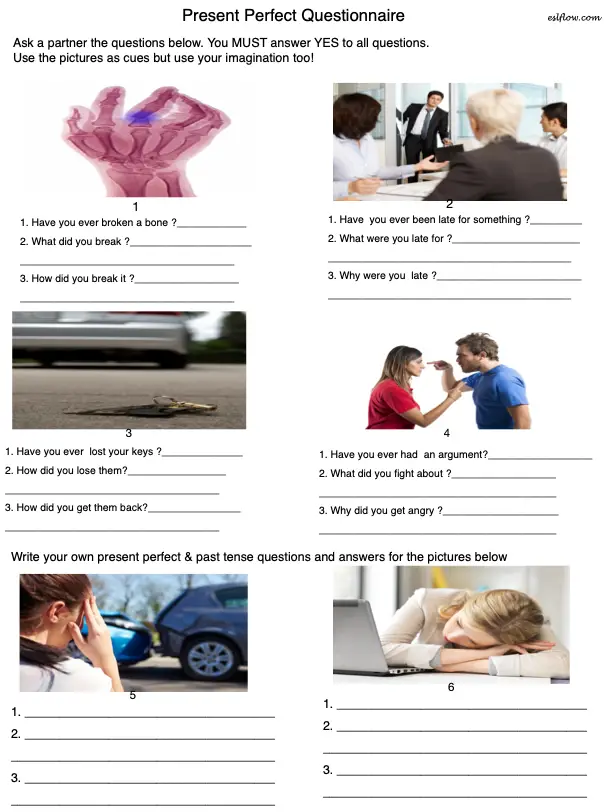
Present perfect questionnaire (PDF)
(see the YouTube video)
4 Vocabulary and discussion questions: artificial intelligence apps
Artificial intelligence is now a part of everyday life. This is a vocabulary/listening/speaking exploring ideas about AI apps that people use everyday.
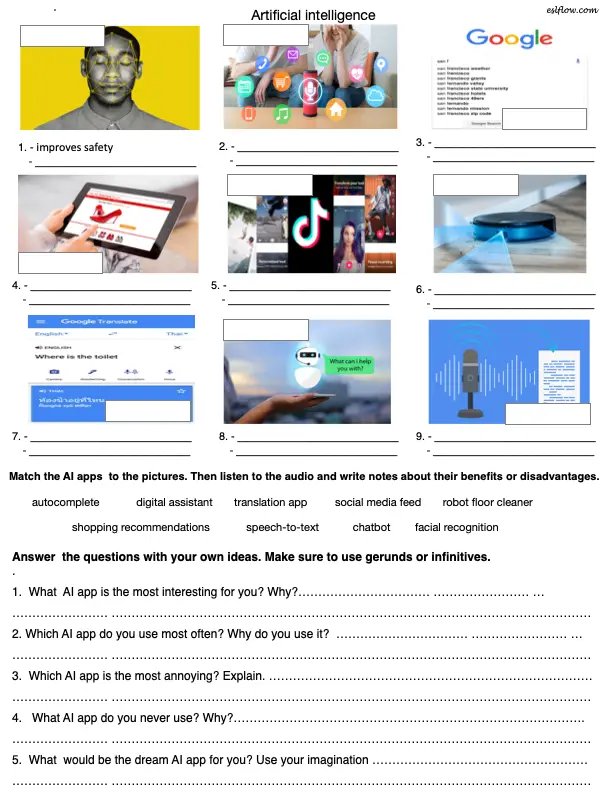
(download PDF)
(see the video of this exercise on YouTube)
5 Questionnaires with pictures: talking about shopping example
This is an elementary ESL speaking activity for practicing language useful for talking about shopping. Shopping is a great topic for English language students as it is universally accessible. Using pictures with the questions gives context. The vocabulary at the bottom of the page can be matched to the pictures as an icebreaker. Students can discuss and answer the questions in groups or in pairs.

Talking about shopping (PDF)
Related Speaking Skills Resources:
14 Write a Conversation Exercises
Socializing Speaking Lessons Home
10 Role Play Speaking Activities
11 Classroom Debate and Discussion Language Activities
5 Cracking Complaints and Annoyances Language and Speaking Exercises
12 Brilliant Business English Speaking Skills Activities
Listening exercises for all levels
6 Role plays: Bad vacation example
This is a role play about a bad vacation
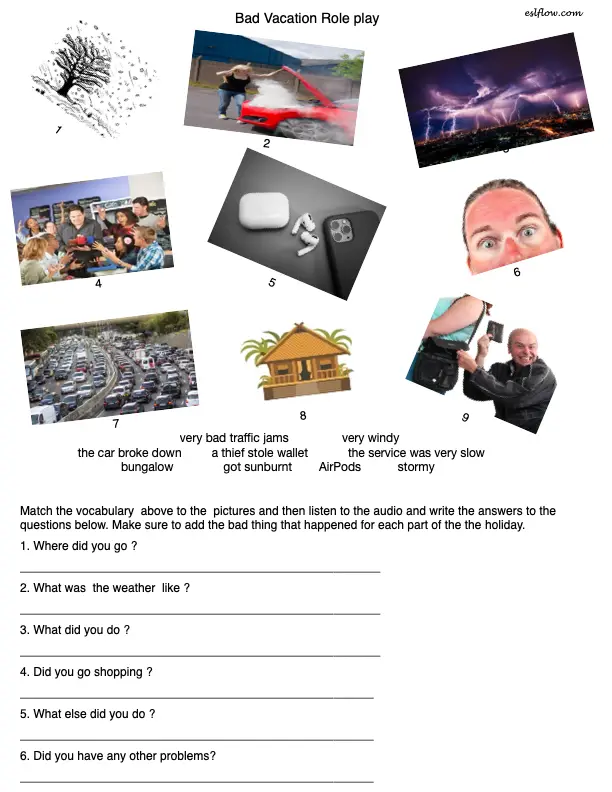
Bad vacation(PDF)
(see the “Bad vacation” role play on Youtube)
7 Role plays : celebrity interview role play example
Role plays can be really good speaking activities. However, students really need to be able to identify with and be interested in the characters they are playing. The easiest and most successful role play I have encountered is the celebrity role play. It is also the most popular role play idea on my website by miles. This is a fun communicative exercise that allows students to to be creative and to improvise.
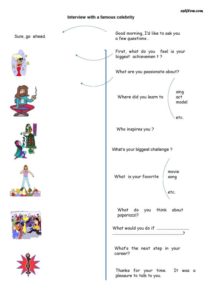
Celebrity role play (PDF )
8 Surveys: fashion choices survey example
This is an ESL speaking and writing lesson for talking about clothes, accessories and fashion choices. Fashion is a great classroom topic as it easily engages students. In this exercise, students have to write their own questions, survey their classmates and write a short report about their findings. This is a fun communicative exercise that allows students to mix freely.

Fashion choices survey (PDF)
9 Expressing opinions
This is an ESL or English language exercise for practicing conversational English. Brainstorm collocations for the verbs and then create short conversations using the model on the hand out as an example.

Circle of determiners (PDF)
10 Socializing speaking activities : eternal mingle example
In socializing activities, students write one of more questions on a piece of paper and then walk around the classroom speaking to as many people as possible. This is an excellent all-purpose communicative activity for big ESL classes. It’s effective because it just about ensures a high level of student participation. It also lowers inhibition levels, encourages student centered correction and frees the teacher to observe and field questions from students. The possible variations are endless. It can be used as an icebreaker, for drills, or as an initiator of free conversation.

Eternal Mingle (PDF)
Related Resources
9 Super Elementary Speaking Exercises
5 Elementary Conversational Expressions Exercises
5 First Day Activities for an ESL Class
10 Really! Elementary ESL classroom icebreakers
7 Essential Speaking Activities for ESL Classes
12 Great Icebreakers to Start a Class
8 Invitation and Request Dialogues for Everyday Scenarios
11 Interviews: personality interview example
One-on-one interviews also work well in ESL classes. Several good options are the job interview, the personality interview and the “getting to know you” interview.

Personality interview (PDF)
12 Discussions: cities-good or bad example
Discussion activities on topics which students encounter in their everyday lives are also generally successful. Getting students to provide both sides of an argument helps them to develop their critical thinking and speaking skills. Discussion topics like this example can be done in pairs, groups or as a class.

Cities- good or bad? (PDF)

8 Replies to “Essential Speaking Activities for ESL Classes”
Great worksheets to use at all levels…open-ended, with many channels to follow…thank you very much.
amazing! thanks for great work!
Thank you so much!!!
Absolutely great, thank you so very much!
Great stuff!
They are excellent and easy to understand.
Thanks!! Useful amazing worksheets?
Thanks a lot. the lessons are really practical.
Leave a Reply Cancel reply
Your email address will not be published. Required fields are marked *
Save my name, email, and website in this browser for the next time I comment.
This site uses Akismet to reduce spam. Learn how your comment data is processed .
RECENT ESL EXERCISES
- Essential listening exercises for ESL classes
- Daily routines and schedules
- Sentence starters
- Writing topic sentences
- Shopping online listening, speaking and vocabulary
- Import/export, logistics and supply chain exercises
- Create a conversation
- Using comparative adjectives
- Gerunds and Infinitives Grammar, Speaking and Listening Activities
Five no-prep speaking fluency activities for ESL students
When asked why they study English, most students will say it’s because they want to communicate. They might also want to find a better job, pass an exam or simply be better at English, but oral communication is what students usually put very high on their priority list . What is more, many foreign language students admit that the fact that they can speak a language they couldn’t speak, say, a year earlier, makes them feel extremely satisfied and keeps them motivated. Whether you teach low-level or advanced learners, use these five speaking fluency activities for ESL students to help them communicate better in English. You can use the activities as warm-ups, fillers, and whenever you feel that your students (and you!) need them.
1. Small talk

Used every day by people all over the world, small talk or a quick chat is a great way to practise fluency, revise and make students feel more confident about speaking English. It can be used with students on all levels and repeated regularly in different forms. You can simply ask your students how their weekend was, or how they’ve been, but you could also choose a couple of questions from the list below to make the classroom small talk more varied. Ask follow-up questions and encourage other students to do so, too.
- Do you like the weather today? / Is it too cold or too hot for you? / Do you think it’ll rain?
- What were three things you did before the lesson? / Did you have to rush to get here on time?
- What time did you get up this morning? / What time do you think you’ll go to bed tonight?
- What have you eaten today? / Who have you talked to today?
- What’s the most exciting thing you have done today? / How has your day been so far?
- What’s the most boring thing you need to do this week? / What are you looking forward to this week?
- What have you heard on the news lately?
- Have you seen any good films recently? / Have you seen any funny videos on YouTube?
- Have you spoken, watched or read anything in English since our last lesson?
- What five words or phrases can you remember from our last lesson? What do they mean or when do we use them?
If you want your students to practise small talk more, check out our lesson plan on small talk .

Visual aids are not only a great prompt for speaking, but they also make the lesson more interactive and engaging. Regardless of the students’ level, they are a valuable tool for practising speaking. There are numerous websites where you can generate random pictures (like here or here ) and use them to make your students talk. Apart from the obvious ‘describe the picture’ part, use the set of questions below to make the task more interesting or more appropriate for high-level students. The questions work with any picture, and develop not only speaking fluency, but also the ability to think critically in English.
- Why was the photo taken/the picture made?
- Where would you expect to see it?
- Would you set it as the wallpaper on your computer?
- What feelings does it evoke in you?
- Would you change anything in it to make it more interesting?
- Have you ever taken a similar photo/made a similar picture?
Do you think your students could benefit from such speaking fluency activities? In this lesson for lower-level students you will find tasks to help with picture description, and at the end of this lesson for advanced students you will find sets of photos with extra questions.
3. Would you rather…?

An oldie but a goodie. Everybody likes talking about their preferences, and as teachers we can use this fact to get our students talking. The rule here is that students must explain why they prefer something over something else, because that is when production happens. Use the examples below, and once your students get the gist of the activity, ask them to prepare more of the ‘Would you rather’ questions in pairs. Give them a theme: holidays, work, lifestyle, possessions, extremes, etc. They can then answer other students’ questions.
Would you rather…?
- visit the Sahara or Antarctica
- spend a week without your phone or sleeping on the floor
- be the richest person in the world or the most beautiful person in the world
- study physics or literature
- be a shop assistant or a doctor
- live by the beach or in the mountains
- celebrate your birthday every week or never celebrate it again
- live right next to a stadium or an airport
- be too busy or be bored
- be able to breathe underwater or fly
4. Don’t stop talking

This is one of the best speaking fluency activities for ESL students to use if your lower-level learners still don’t feel comfortable speaking English. The purpose is to let them have a simple conversation with a partner, without worrying about accuracy, and enjoy the fact that they are able to communicate in a foreign language . Put your students in pairs and tell them they will talk about a topic you give them for two minutes. Tell them the point is to keep the conversation going, and that they can say whatever comes into their mind. That means they can share their own opinions and experience, but also ask their partner questions. You, the teacher, want to hear them speak English and that’s all you ask.
Some possible topics for the two-minute conversations include: weekends, food, films, pets, birthdays, shopping, family, cities, travelling, school. If you want to make it more interesting, choose some of these less obvious topics: carrots, socks, dolphins, dentists, headphones, windows, jars, islands, queues, coffee.
5. Is it something we have in common?

This simple activity creates lots of opportunities for students to ask questions. The following are some examples of what you might say to your students about yourself. You can obviously adapt the sentences so that they are true for you.
- I always listen to classical music in the car.
- I have four pairs of trousers.
- There is a lamp in the corner of my bedroom.
- I’ve had two cups of tea today.
- I finish work at 7 on Thursdays.
- I went abroad twice last year.
- I can make lasagne and sushi.
- I was at a friend’s birthday party last weekend.
After hearing or reading one of your sentences, students talk in pairs or groups to establish if it is something you and they have in common. It probably isn’t, so they will get one minute to modify the statement so that it is true for the three of them. This will require either asking their partners questions (e.g. Where do you listen to music? Do you listen to classical music? Do you always listen to something in the car?), or talking about their own experience, e.g. of listening to music and going places by car, until the other students decide that it is also true for them. (There might be students who, once they realize a sentence is untrue for all of them, will simply turn it into a negative, or change the beginning to ‘My English teacher…’. Make sure they know that is not what the activity is about.)
If you want your students to practise asking questions more, have a look at this lesson plan .Fluent speaking is arguably the most desirable skill for English learners. At ESL Brains , we always try to give it priority in the lessons we design, but it ultimately depends on you, the teacher, how much speaking practice your students are given. How do you create speaking opportunities in the lesson? Which of the no-prep speaking fluency activities for ESL students will you use to help your students communicate better in English?
Read other teaching tips posts

ESL Brains Critical Reading Club

My tips for teaching English to seniors (60+)

How to use interactive videos for teaching English

Six no- and low-prep vocabulary revision exercises which make students think in English

5 websites that will take your ESL lessons to the next level

How to make the most of group activities in one-to-one classes

How teaching with authentic materials benefits your students

Making teaching English online easier with ESL Brains

How to apply flipped classroom for teaching English with ESL Brains lesson plans
Leave a reply cancel reply.
You must be logged in to post a comment.
Great tips! I often use them during my classes!
Me too 🙂 It’s amazing to see how quickly simple activities like these give students confidence in speaking.
Thanks for the inspiration! It’s always nice to have a few fresh ideas, or even just a reminder to dust off some classic, well-loved activities too. 🙂
I know. We sometimes do so much lesson prep that we forget that some simple ideas can be really effective.
I have a student who really struggles with any kind of conversation about herself. We often use photos of individuals and groups, and I ask leading questions about them. She has opened up tremendously, and I can now sneak in questions about her, as well. She’s really responding well to this.
I like the idea of asking her to talk about other people first, then about herself. Sounds like you’ve really helped her.
Thank you for these brilliant ideas!!! They ll boost my worming ups and some conversation courses too!!!
Thanks! I’m glad to hear it 🙂
Great tips! My students had lots of fun with them!
Thanks, Stephanie. It’s good to hear your students enjoyed them 🙂
Username or Email Address
Remember Me
150 ESL Conversation Starters and Questions (The Essential List)
Do you want your students to be excited to speak with you in English?
Do you want to make sure you always know where the conversation is going and what to say next?
You need engaging content, interesting conversation starters, and questions that really reel them in.
Join our mailing list to receive a free ESL teaching resource every week.
Click to Join
This list of 150 ESL conversation starters will give you everything you need to make sure you always have something interesting to talk about and never run out of things to say!
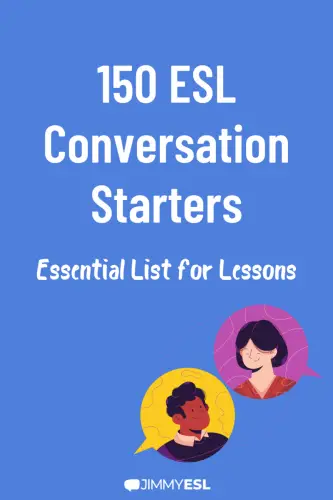
Why Every Teacher Needs a List of Starters
Conversation topics for adults and teens, conversation topics for kids, conversation topics for beginners, weird and funny conversation starters, controversial conversations topics, additional tips for your conversation lessons, final thoughts.
If you want to improve your student’s speaking ability you need to master the art of conversation. You need to know how to get your students speaking , move the conversation forward, provide feedback and make it all feel natural. You also need engaging topics and that is where this guide comes in.
One of the problems that can face a teacher is knowing what to talk about. What do you do when you’ve finished talking about work, the weather and then realise that only 5 minutes have passed!
This guide has everything you need to make sure you never run out of topics and most importantly you always have something interesting to say.
It is a good idea to pick a particular topic for a class (or even have your student pick if you want more engagement from them). Once you have that topic then move through the questions, trying to get as much from each one as possible.
Browse our ESL teacher resources section for more tips and printable lesson materials.
Adults and teens usually know more about advanced topics than children (politics, religion, etc.) That being said, knowing more on these topics doesn’t necessarily translate to being able to speak about these things easily so don’t assume they can do everything. Be aware of your student’s level and be prepared to reframe a question if they are struggling to understand.
- Where do you work?
- Do you enjoy your job?
- Do you use English for your job?
- Tell me about your last job.
- What do you think is the most difficult job in the world?
- What do you think is the easiest job in the world?
- Where would you work if you could pick any job?
- Would you still work if you won the lottery?
- Do you think robots will replace all of the jobs in the future?
- Which kind of job should have the highest salary?
In this post, you’ll get 20 topics and activities for Business English lessons.
- Do you listen to music?
- When did you start listening to music?
- Do you play a musical instrument?
- What do you think the future of music will be like?
- If you could meet any musician, who would it be?
- Why do people like music?
- If you could erase a musical genre, which would it be?
- Do you think musical success comes from working hard or luck?
- What was the first album you bought?
- Have you ever downloaded music illegally?
- What is a holiday?
- Do you often go on holiday?
- Where did you last go on holiday?
- Where would you like to go on holiday next?
- Do you prefer relaxing or having an adventure on your holiday?
- Is it weird to go on holiday by yourself?
- What is the best food you’ve eaten while on holiday?
- Can you imagine what holidays 500 years ago were like?
- Would you like to go on holiday to space?
- What do you think the future of the holidays will be like?
- What is technology?
- What do you think of when you hear the word ‘technology’?
- How has technology changed in the past?
- How has technology changed your life?
- Could you live without technology?
- Find the full list of technology questions here
In order to engage a child in conversation, you have to enter their world. What is fun for them? What do they like to do? Using words/phrases like “wow”, “That sounds tasty”, “Awesome” can show you are listening to them and make things more fun which will get them saying more!
- Do you have a pet?
- What do you think pets do in the day?
- What do pets eat?
- Are cats better or dogs?
- What is the best name for a pet?
- Would you like a pet spider?
- Would you like to be an animal? Which one?
- Why do we have pets?
- Do you prefer cute or fun pets?
- What is the best present for a pet?
- Do you like school?
- What is your favourite subject?
- What is your least favourite subject?
- Who is your favourite teacher?
- Why do people have to go to school?
- Do you like homework?
- What would you do if you were the headteacher?
- How could schools be more fun?
- How long are the summer holidays?
- Can you learn and have fun at the same time?
- What is your favourite movie?
- Who is your favourite character?
- Who is your least favourite character?
- Do you like disney movies?
- What was the last movie you saw at the cinema?
- How often do you watch movies?
- Do you wish you could live in a movie?
- Why do you watch movies?
- Do you prefer reading books or movies?
- Do you watch any movies in English?
Keeping the topics simple for beginners is a must at the start. Talking about their hobbies and family can help as these are areas they may have already experience in talking about. If a student is really struggling then giving them phrases to use such as “I like …” can help get the ball rolling.
- What do you like to do?
- Do you do any sports?
- What types of movie do you like?
- Do you play video games?
- What do you usually do with friends?
- Is learning English a hobby or work?
- Do you have any unusual hobbies?
- Do you have enough time for your hobbies?
- What is a common hobby?
- What do you think is a boring hobby?
- Do you live with your family?
- How many people are in your family?
- Are you close with your family?
- How often do you see your family?
- What do you do with your family when you see them?
- Is your family important to you?
- Which is more important, friends or family?
- Who is the weirdest person in your family?
- Are families less important nowadays than in the past?
- What would happen if we didn’t have families?
- Where do you live?
- What is there to do in your city?
- What is your place like?
- What is your neighbourhood like?
- Are there any parks near where you live?
- Have you ever lived elsewhere?
- How many rooms does your place have?
- If you moved, where would you like to live?
- Would you prefer to live in the city or country?
- Would you like to live abroad?
Use information gap activities to help your students practice speaking: read our guide.
Nobody wants to speak about the same mundane topics, especially if they’re an advanced student. Being able to mix it up is a great attribute to have as a teacher. Not only will you have memorable lessons with these conversation starters but it will really test the ability of the students to think about topics they aren’t used to (instead of rolling off easy answers about familiar topics.)
Zombie Apocalypse Plan
- What is your zombie apocalypse plan?
- Who would you take with you?
- What would be your weapon of choice?
- What would you do if a friend got bitten by a zombie?
- What would you do if you got bitten by a zombie?
- What food would you take with you?
- Do you think governments should have a zombie apocalypse plan?
- Do you think everyone should have a zombie apocalypse plan?
- Is a zombie outbreak a likely scenario?
- Why do you think there are so many movies and TV series based on zombies?

Superpowers
- If you could have a superpower, what would it be?
- What do you think is the weirdest superpower in comic books?
- Are some superpowers too powerful?
- Would you like a superpower where you could turn things into gold by touching them?
- What is the weakest superpower in a comic book?
- Have we already seen every kind of superpower possible in a comic book?
- Are there some people in the real world that have superpowers? (doctors etc)
- Would you like a superpower where you could turn things into chocolate?
- Would it be better to be super strong or super smart?
- Would you like the power to travel through time?
- If you were granted 3 wishes what would they be?
- Is wishing for more wishes cheating?
- Should there be any other rules for people granted wishes?
- Have you seen any movies with a magic lamp?
- Do you think there is a better object that could house a genie?
- Why are we interested in stories of people having wishes?
- Have any of your wishes come true in real life?
- Do you make a wish when you blow out the candles on a cake?
- Is it bad luck to tell someone what your wish is when blowing out the candles?
- What other ways do people make wishes?
These are topics that you need to be careful with and use your judgement based on the student’s background. You need to wait until you know a student to find out what material is appropriate for them. That being said, If used correctly, then these can be really interesting and get the student thinking about “real issues”.
Death Penalty
- What do you think about the death penalty?
- Do you know which countries still use the death penalty?
- Why do you think some countries use the death penalty?
- Do you know of any famous executions?
- Should the death penalty be outlawed?
- If we removed the death penalty then what punishment should replace it?
- What is the most humane form of execution?
- What would your “last meal” be?
- Does the fear of the death penalty reduce crime?
- How has execution changed over the years?
- What is abortion?
- Should abortion be legal?
- Why do you think some people are “pro choice”?
- Why do you think some people are “pro life”?
- What do you think of abortion in cases where the baby was conceived due to rape?
- What do you think of abortion in cases where the Mother’s life is in danger (due to being pregnant)?
- Should the father “get a say” in the matter of abortion?
- What advice would you give to a family member who was thinking of getting an abortion?
- Should people be allowed to protest against abortion?
- What do you think the future laws on abortion will be?
- What is corruption?
- Is there corruption in your country?
- Why does corruption exist?
- Would you consider taking a bribe?
- Would you consider offering a bribe?
- Are some types of corruption better than others?
- Which countries have the most corruption?
- Which countries have the least corruption?
- Are there any stories of corruption that you can remember?
- Is it possible to get rid of corruption entirely?
Get a list of 110 “Would you rather” questions for your conversation lessons.
Here are some additional tips to make sure your students are getting the most out of their conversation lessons and will be excited about coming back for more. Some of these will take time to internalize and get right but be aware of them and experiment to get them just right.
Don’t feel like you have to stick rigidly to the list of conversation starters. If a question takes you down a different conversational thread then go with it. The important thing is that the student is talking, you can always return to “the script” later.
Correcting a student immediately can often be useful, but in conversation, it can really kill the flow as well as a student’s confidence if done too often. A good idea is to make notes of any major problems and then mention them after a particular section instead. On top of this, try not to interrupt a student once they are speaking. For each answer, try to milk everything out of them that you can before you have “your turn to speak”.
As well as the frequency of correction, consider the amount being corrected. Don’t feel like you have to correct EVERYTHING. Especially if a student is starting out and is a bit nervous. Pick a few problems areas and focus on that, if you mention too many things at once it can be overwhelming and can really lower a student’s confidence.
Be strict when a student gives you short answers. If a student gives you an answer like “yes” then force more out of them with “yes… because” or “no… but”. The idea is to get them using the language more.
Try to inject some personality when using these ESL conversation topics. It should feel more like a conversation rather than a robot giving an interview.
Some students will struggle with certain subjects as they just don’t know enough about the topic. If it’s a bit of a challenge then push through but if they can’t even talk about a topic in their native language then it may be an idea to move on to another subject.
Allowing a student to pick a topic can be a great way of engaging them more. This also has the added benefit of helping a younger student (such as a teenager) feel more empowered as they can make their own decisions.
Get 18 statesman tips on giving great conversation for teens and adults in this post.
There you have it!
All you need to make sure you never run out of things to say. Get these printed out as your go-to cheat sheets and bookmark this page so you can easily come back to them for future classes.
Hopefully, these ESL conversation starters and questions will spark your own ideas for topics you can use in class. If you are teaching one-to-one, you could even write niche topics especially for that student’s interests (e.g skateboarding, knitting or chess).
Remember, match the topics to the student’s level, keep it fun and once they start talking don’t get in the way!
Share the love
Related posts.

Free ESL Noun Worksheets For Your Lessons
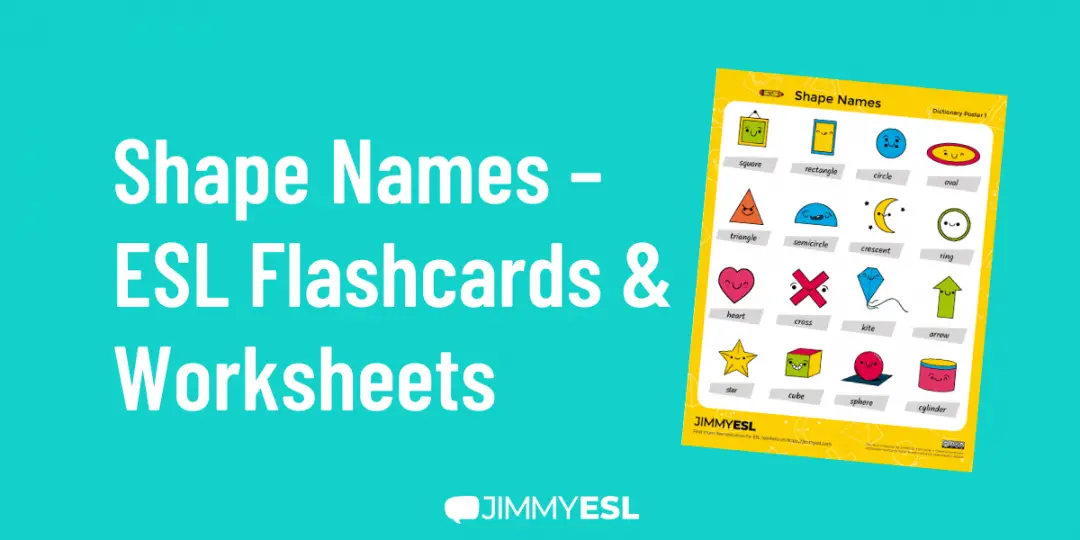
Shape Names – ESL Vocabulary Worksheets & Flashcards
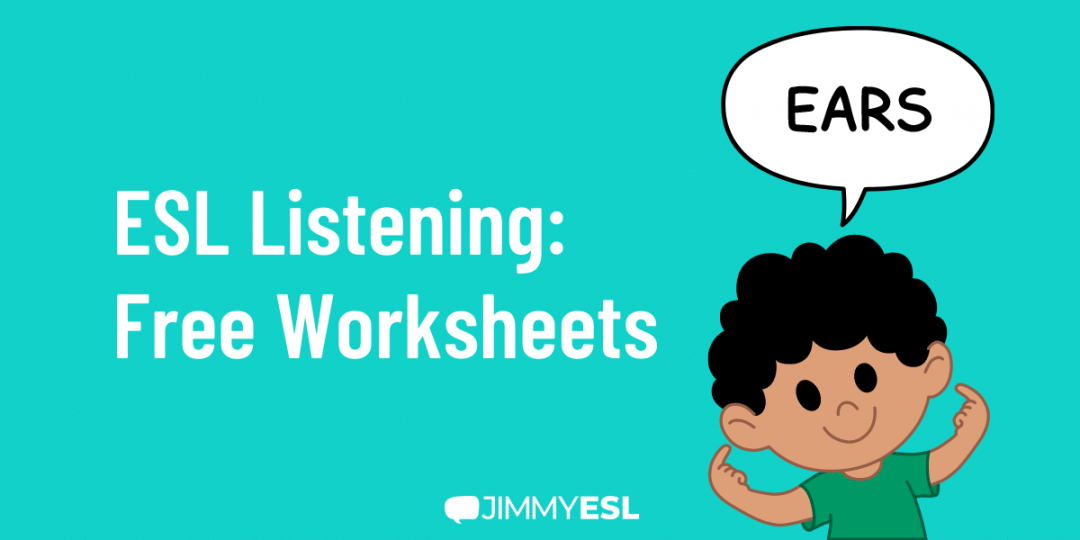
12 Great ESL Listening Activities & Games
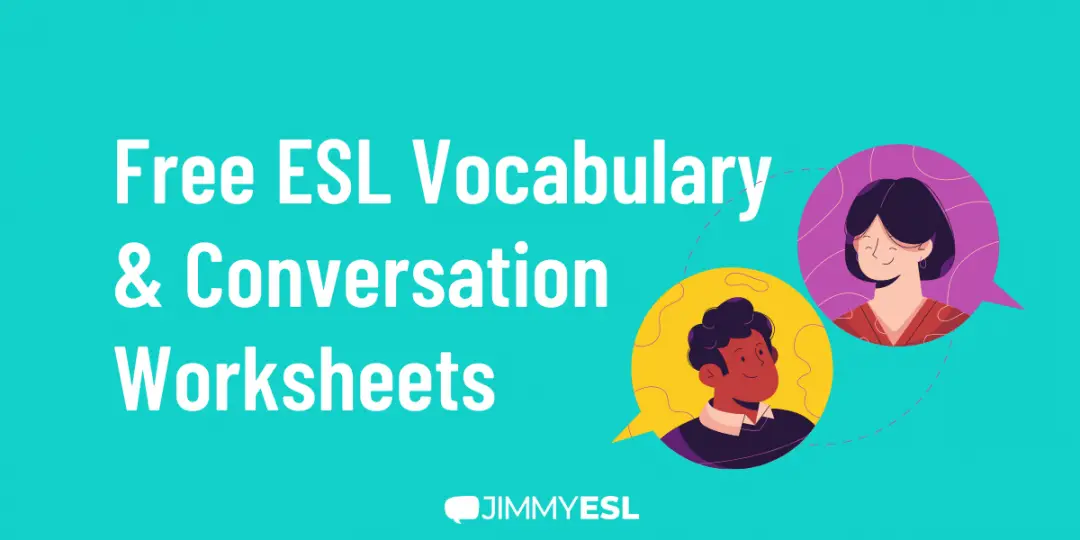
Free ESL Vocabulary & Conversation Worksheets
4 thoughts on “150 esl conversation starters and questions (the essential list)”.
Interesting amazing content Thanks heaps
Very interesting! Thank you.
This is very useful for our speaking club. Thank you.
Glad to hear, enjoy! :)
Leave a Comment Cancel Reply
Your email address will not be published. Required fields are marked *
Start typing and press enter to search


Explore More
Stay in our orbit.
Stay connected with industry news, resources for English teachers and job seekers, ELT events, and more.

Explore Topics
- Global Elt News
- Job Resources
- Industry Insights
- Teaching English Online
- Classroom Games / Activities
- Teaching English Abroad
- Professional Development
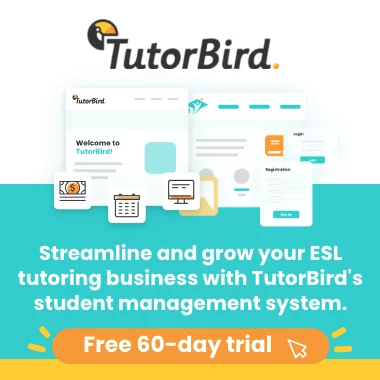
Popular Articles
- 5 Popular ESL Teaching Methods Every Teacher Should Know
- 10 Fun Ways to Use Realia in Your ESL Classroom
- How to Teach ESL Vocabulary: Top Methods for Introducing New Words
- Advice From an Expert: TEFL Interview Questions & How to Answer Them
- What Is TESOL? What Is TEFL? Which Certificate Is Better – TEFL or TESOL?

Give Your Students the Gift of Gab: 11 Fun TEFL Speaking Activities
Camille turner.
- May 15, 2021
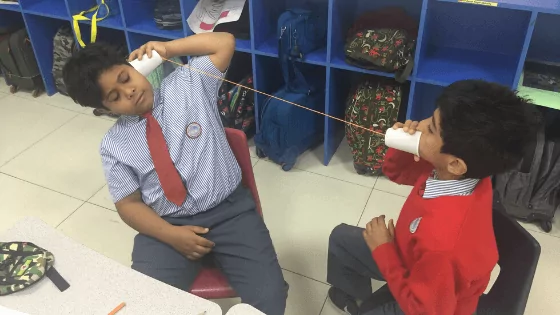
One of the most important skills for ESL students to develop, speaking can also be one of the most difficult aspects of the language for your class to master. This is because many students are hesitant to speak due to a fear of making mistakes or a lack of confidence. Thankfully, with the right TEFL speaking activities, you can encourage your students to speak up in class — and have fun while doing it!
If you’re new to teaching, you’ll want to get initial training and qualification with a TEFL certificate . You can explore our online TEFL courses to get started!
Table of Contents
How do you motivate students to speak in English class?
Before we jump into some great TEFL speaking activities, here are a few general tips to keep in mind:
- Cultivate a classroom culture where making mistakes is okay. The best way to make students more comfortable speaking English is to make sure they know it’s okay to make mistakes and that it’s the only way they’ll learn. You can do this by establishing class rules that ensure students are kind to one another and by thoughtfully approaching error correction in the EFL classroom .
- Encourage students to speak up and participate by offering plenty of positive feedback when they do. Whether you’re teaching young learners or adults, students should be praised for their speaking efforts. This does not mean that you can’t correct their pronunciation or grammatical mistakes but rather that you should emphasize trying rather than speaking perfectly.
- Make your classroom fun! By incorporating TEFL/TESOL speaking activities and relevant, interesting TEFL discussion questions , you’ll engage learners and take the pressure off of the actual talking. In other words, if students are more focused on a game or exciting topic, they’re less likely to be self-conscious and focused on speaking.
- Don’t interrupt when students are speaking. It can be tempting to jump in and finish their thoughts or help them recall a word too quickly, but sometimes students just need more time to formulate their ideas. By constantly interrupting them, you may end up actually making them less confident in their English speaking abilities.

Teacher Jhonny works with ESL students online.
What are some ESL speaking activities to get students talking (online or in-person)?
Now, let’s look at some great ESL speaking activities you can use in the virtual or physical classroom to develop this productive skill in your students.
Help students prepare themselves to think in English through speaking warm-up games or activities. It could be as simple as playing “Two Truths and a Lie” or an exciting word guessing game, or it could be a comprehensive but fun way to review the last class’ lesson, like by playing “20 Questions” or finishing incomplete phrases.
Get more warm-ups and icebreakers for all ages in this article: 13 Easy ESL Icebreakers.
Holding debates is a great way for students to speak a lot in class, as you only act as the facilitator or judge during the activity. You can announce the debate topic in advance or spontaneously, then divide students into “pros” and “cons” or “for” and “against” teams.
Make sure that the topics or the range of vocabulary to be used in the debate are appropriate for your students’ English level. Also, be careful of bringing up sensitive or taboo topics like religion or politics, unless you know that your students will be comfortable tackling them.
Aside from reinforcing and reviewing vocabulary and expressions that you taught in previous lessons, role-playing also helps prepare students for many real-life situations that require them to speak in English, such as traveling, eating out, and socializing. For Business English , role-play can simulate job interviews, business trips, and various work situations.
For role-play with beginner students, make sure to provide a dialogue as a guide. On the other hand, more advanced students can write their own scripts for the conversations.

A teacher does an ESL speaking activity with young learners.
Class poll activity
Get class conversations going by asking about your students’ opinions on various topics that they can relate to. Learners undoubtedly will have a lot to say about recurring themes like culture, food, or lifestyle topics — the sky’s the limit when it comes to what you can talk about!
You can also spark a class discussion and survey based on a news story. For instance, you could interview students on how they maintain a healthy lifestyle during a pandemic or how their country is acting on climate change. Very young learners and beginners can focus on topics like favorite colors, family members, or pets.
Meanwhile, instead of you asking the survey questions, why not let your students make the questionnaires and lead the discussions? You can even make this more fun in a group class by playing “Find Someone Who” as an icebreaker, where learners have to find a person in class who matches a certain description or can answer a question they have created.
Need to fill some lesson time in a pinch? Try these no-prep ESL activities!
Customized lesson fillers
While you may have a curriculum or syllabus to follow for your English course, you can deviate from the list of topics from time to time by creating a special, engaging lesson based on your students’ interests after you’ve taught or known them for some time. For example, you could show a video about tourist destinations in Europe to your student who loves traveling or share a story about a pop culture icon that your student loves. This should spark plenty of discussion!
Take a look at some other fun ESL games and activities for young learners and teens.
Presentations
An oral presentation activity, which can be given at the end of a lesson or as a course project, is great for boosting your students’ confidence, especially in public speaking. If you are teaching a group class, you can assign topics to individual students or have them work on a single presentation as a group.
Podcast-based activities
Whether it’s about famous musicians or tips for shopping abroad, you can find a plethora of podcasts on iTunes, Spotify, or other podcast providers. You can listen to a podcast in class and create a discussion about it afterward or have your ESL students listen to one as homework and report back what they’ve learned from the podcast in the next class.
- Pro Tip : Do a pre-listening activity to prepare students for the vocabulary they will hear in the podcast.
Learn how to use podcasts for engaging ESL learners through Bridge’s Micro-credential course in Teaching English Using Podcasts.

Teens practice speaking English in teacher Richard Allen’s class in Vietnam.
Time trials
This is an ESL speaking activity that works well with any group of students. Give your EFL students a prompt and perhaps a few minutes to collect their thoughts. The prompt should allow for enough speaking to fill up four minutes. Once they are ready, put the students in pairs and have them take turns sharing their four-minute stories with each other. Now, mix up the pairs and have them take turns telling the same story, only this time they only have three minutes. Once both partners have retold their stories, mix up the groups one more time. They now only have two minutes to talk.
Decreasing the amount of time they have to speak puts pressure on them to speak quickly while the repetition should allow for more rapid access to the language, i.e., increasing fluency.
- Pro Tip: If you’re teaching English online and the platform doesn’t allow for breakout groups, you can modify this activity by having each student share their story to the whole class twice — once with four minutes on the clock and once with two minutes.
Check out more team-based activities for the ESL classroom and online.
Listen to me
In this TEFL/TESOL speaking activity, English students choose whatever topic they want to speak about and then create and write a headline for their story. The teacher divides the class in half, and one half of the class holds up their headlines. The other half reviews the headlines and decides which story they want to hear. Once the selected student has shared their story, have the opposite half of the class hold up their headlines and let the other students choose a story they want to hear. Do as many rounds as you have time for. This activity is very easy to carry out in both the online and physical classroom!
Take 1, take 2
This TEFL speaking activity can be done during class time, but it works especially well as a homework assignment. Have students record a story or their thoughts on a specific topic that you’ve selected. After they have finished, have them listen and make notes on parts that they felt they could do better. Then, they record the story again. The students can go through this process a few times until they are satisfied with their recording. You can then have them submit their notes and recording to you, or else play it to the whole class or a partner. This activity is great for getting students to self-assess their speaking skills.
Finish the sentence
Have each student write down half of a sentence on a piece of paper. For example, they could write “Walking to school today…” or “Guacamole makes me…” or “If I could have any superpower…” Collect all of the sentences and mix them up in a bag or a bowl. Call one student to the front of the classroom and have them draw a slip of paper (this activity could be modified by splitting the class into groups if you have a large class). Give the student a few seconds to prepare what they will say, and then have the student read the sentence aloud, complete it, and continue speaking on the topic for one minute (you can shorten or lengthen this time depending on the level of the class).
- Pro Tip: If you’re teaching online, you can either create the first half of the sentences yourself or have students submit them via chat box. You can then choose one to say aloud to each student when it’s their turn to speak.
Speaking in class doesn’t have to be a chore or scary for students. With the right TEFL speaking activities, you can motivate your students to practice talking and create a fun, lively class!
Need more activities and ideas for the classroom? Check out these last-minute ESL lesson plans that can be adapted for any class!

Camille is a content marketing manager, specializing in the language industry. Her love for language and experiencing other cultures has taken her around the globe, and she has taught English abroad both in the classroom and online. When not working or traveling, she can be found spending time with her family or — when not chasing after her two young daughters — cozying up with a good book!
- Our Mission
12 Fun Speaking Games for Language Learners
Activities that will get students talking in a language they’re still learning.

When working with world language classes or English language learners, have you ever asked a question only to be answered with complete silence and blank stares? It’s a common issue—nearly every teacher has struggled with encouraging students to speak in a language they’re still learning.
A student may have a deep fear of making a mistake, or may be just plain shy, even in their native language. Whatever the reason, here is a list of a few fun activities to get your students to speak. This list is for more advanced students.
12 Ways to Get Language Learners Talking
1. Who’s Telling the Truth? Have each student write three facts about themselves that nobody in the class knows on a piece of paper. Make sure each student includes their name on the top of the page. Collect the sheets of paper and bring three students to the front of the room. Read aloud one of the facts that is true for one of these three students.
All three claim that the fact is theirs, and the class then proceeds to question them in an attempt to determine who is telling the truth and who is lying. Each student is allowed to ask one question to one of the three students. After a round of questioning, the students guess who is telling the truth.
2. Variations on the game Taboo: For variation 1, create a PowerPoint presentation with a noun on each slide. Have one student come to the front of the room and sit with their back to the PowerPoint. The rest of the students take turns describing the words on the slides, and the student at the front has to guess them.
For variation 2, separate the students into groups of four or five. Place a pile of cards with random nouns in the center of each group. Have students take turns describing a noun for their group members to guess. The group member who guesses correctly keeps the card, so there’s competition to see who has the most cards at the end of the game.
Variation 3 is for advanced speakers. Separate the class into two teams. Students are given a word to describe to their teammates, in addition to a list of words that they cannot use in their description. Each student should have two to three minutes to see how many words their teammates can guess.
3. Descriptive drawing activity: Pair up the students and give each student a picture, placing it face down so partners cannot see each other’s cards. They must describe the picture for their partner to draw.
4. Comic strip descriptions: Give each student a portion of a comic strip. Without showing their pictures to one another, the students should attempt to describe their image, and put the comic strip into the correct order. After about 10 minutes, the students can guess the order, show one another their portion, and see if they were correct.
5. Secret word: Students are given a random topic and a random word that is unrelated to the topic. The students must hide the word in a speech about the topic—they’re trying to make sure the other students can’t guess the secret word. The other students listen carefully to the speech and attempt to guess the secret word.
6. Debates: Give each student a piece of paper with “agree” written on one side and “disagree” on the other side. Read aloud a controversial statement, and have each student hold up their paper showing the agree or disagree side depending on their opinion. Choose one student from each side to explain their position and participate in a short debate.
7. Impromptu speaking: Prepare a list of topics that students will be able to talk about. Split the class into two teams, and have each student choose a number—that’s the order they will go in. Each student will respond to a statement without preparation. They must continue speaking for 45 seconds. As the student is speaking, the other team listens for moments of hesitation, grammatical mistakes, and vocabulary mistakes. If the other team can correctly identify an error, they get a point.
8. Desert island activity: Give each student a piece of paper and tell them to draw an item—any item. Collect the drawings and pass them out again; no student should receive their own drawing.
Next, tell the students that they’ve been stranded on a desert island, and only half of the class can survive and continue to inhabit the island. The only thing each student will have on the island is the item depicted in the drawing given to them, and their goal is to convince the class that they should survive based on that item.
9. Storytelling activity: Bring four students to the front of the classroom. Three of them should sit in a row, and one should stand behind them and act as a controller. Give the controller a stack of cards with nouns written on them.
The controller will hand a noun to one of the three students, who will start to tell a story. The student continues telling the story until the controller decides to hand another noun to another student, who will then take over the story.
10. Two Truths, One Lie : Each student should write three statements about themselves on a piece of paper. Two of them should be true, and one should be a lie. Students read their three statements, and their classmates question them to try to determine which statement is a lie.
11. True/false storytelling: Give each student a piece of paper with either “true” or “false” written on it. Each student should tell the class a story that is true or false, depending on which word they received, and the class must guess whether it’s true. To add to the activity, you can allow the other students to question the student telling the story.
12. I Have Never...: All students in the class should start this activity holding five fingers in the air (you can use less fingers to do this more quickly). The student who goes first tells the class one thing that they have never done. The students who have done that activity should put a finger down, and tell the class a story about this activity. A student is out of the game when all of their fingers are down.
This piece was originally submitted to our community forums by a reader. Due to audience interest, we’ve preserved it. The opinions expressed here are the writer’s own.
ESL Speaking
Games + Activities to Try Out Today!
in Activities for Adults · Activities for Kids
ESL Activities for Listening & Speaking | ELL Listening Activities & Games
Do you want to help your students get more practice with listening and speaking English in your classes? If yes, then you’re certainly in the right place. Keep reading for the top listening and speaking activities for ESL to help them do that!

ESL Listening and Speaking
Let’s get into the best ELL listening activities and games to consider trying out in your classes. Have some fun with these ESL listening games today.
If you want to learn about how to become an ESL teacher, give this article a read!
ESL Activities for Listening and Speaking
If you’re looking for some ESL activities for listening and speaking, you’ve come to the right place! We’re going to give a brief description of our favourite ESL activities that focus on two very important skills-listening and speaking. We’ll also include a link to more details about how to set up the ESL activity and use it in your classes.
#1: ESL Surveys, ELL Listening Activity
ESL surveys are one of my all-time favourite ESL Activities for listening and speaking. I love them for the following reasons:
- They get students up and out of their seats
- ESL surveys encourage interaction with a wide variety of students
- Surveys help students practice follow-up questions
- They’re fun!
- They can be used for kids, teenagers or adults and are ideal for a variety of levels (except total beginner)
- They cover all 4 skills (reading, writing, listening and speaking)
For more details about ESL Surveys and how I use them in my own classroom, you’ll need to check out this article:
ESL Surveys and Why I Love Them
#2: Agony Aunt Problem and Advice Activity
Try out Agony Aunt to mix things up a bit. Even lower-level ESL or EFL students can understand basic problems and then give some simple advice using the following structures:
“You/He/She should (n’t)….”
For more details about ELL listening activities, see this article:
Agony Aunt: An ESL Speaking and Listening Activity
#3: Board Games for ESL Students
Another one of my favourite speaking activities for ESL students is board games. They’re an excellent way to review for a test or to round out a unit. I like to bring the real world into the classroom and this is one way I do it (I personally love playing board games!). Plus, they work for any grade or level of students.
It’s a speaking activity because students have to say the correct answer in response to the question in order to remain in the square. And, the other students have to listen carefully to make sure the answer is correct.
You can learn more about how I board games in my classes here:
#4: Dictogloss — A Classic ESL Activity
Dictogloss is a challenging, yet easily adaptable ESL Speaking and Listening Activity that will quickly become one of your favourites. It can be used with just about any level, individually or in groups of up to four students.
Listening is necessary, but then you can choose to focus on either writing or speaking. It really is an extremely flexible ESL activity that your students will enjoy. The key is to adapt the text and your speaking speed to suit the level of your students.
For more details about one of my favourite ESL listening activities for adults, be sure to check out:
Dictogloss ESL Speaking and Listening Activity
#5: Conversation Starters
Conversation starters for ESL students are a fun way to get the class started off on the right foot. They’re a great warm-up activity because they’ll get your students thinking, talking and enjoying using English.
If you have a smaller class, then you may want to consider doing it all together as a group. But, remember that your students should be doing most of the talking. After all, you’ve probably already quite good at English and it’s your students who actually need the practice.
Here are some of my favourite conversation starters that are perfect for getting your students speaking in English:
Top 10 ESL Conversation Starters for Adults
Top 10 ESL Discussion Starters for Kids
#6: ESL Trivia

- Bolen, Jackie (Author)
- English (Publication Language)
- 60 Pages - 01/09/2016 (Publication Date) - CreateSpace Independent...
If you want to level up your ESL teaching game, then you’ll need to get some ESL trivia in your life! You can use them to focus on listening by reading the questions, instead of posting them on the PowerPoint. Then, have your students tell you the answers to focus on speaking.
If you teach kids, you’ll need to check out this book on Amazon. It’s ideal for ESL classes because the language of the questions are very simple and even beginners can understand it. Plus, the questions are general in nature and not focused on the USA or the UK like many of the other questions you’ll find online. This makes trivia one of the best listening activities for ESL.

ESL Speaking and Listening Activities
#7: Listening
If you want to focus on ESL speaking and listening, a great way to do this is through a dedicated lesson. Once you get the basics of it down with something like this ESL listening lesson plan template , then you can add in a bunch of other listening and speaking activities.
Check out how I expand this basic plan into a full class that includes speaking activities as well:
ESL Listening: How to Teach It

#8: English Central Videos

That’s why I like using English Central. There are so many good ones and not all of the junk. Plus, they’re organized by level and topic so it’ll be easy for you to find what you’re looking for.
Saving time when lesson planning? Love it! And I’m sure that you do too, right?
I generally start the class by getting students talking with a partner about the topic of the video. For example, if it’s about habits, I’ll get students to talk with a partner about this question, “What are your healthy and unhealthy habits?” More ideas here: ESL Health Activities .
Then, we’ll watch the video and students will have to answer questions about it. Finally, I’ll have students do a longer speaking activity related to the topic.
Find out why this is one of my favourite ELL listening activities: How I Use English Central Videos in my Classroom
#9: Running Dictation
Running dictation is another classic ESL Activity. This one is particularly good because it uses all 4 skills-speaking, listening, reading and writing. It’s challenging, easily adaptable to just about any age or level. It also gets students up and out of their seats and helps you get some energy back into your classroom.
Try it out for yourself and I’m confident that it’ll soon become one of your favourite ESL listening and speaking games. However, be sure that you use quite common words that the majority of the class will know quite easily or this game will be a bit of a struggle.
Check out: Running Dictation- A Classic ESL 4-Skills Activity
#10: Role-Plays for ESL Students
One of my favourite ways to finish off a unit for lower-level students is with a role-play. They’re fun, encourage a bit of creativity and can be easily adapted by adding, or removing the amount of mandatory text that students must use.
You can also use them for just about any topic you can imagine! Think beyond school and about what kinds of situations students may encounter in real life. Let this be your guide for topics.
If you ask your students, they’ll probably list “conversation” at what they want to work on most in your class. However, beginners often struggle with this. That’s why I like using ESL role-plays so much. They’re a kind of bridge between free-talking and not talking at all!
Check out: How I Use ESL Role-Plays in my Classroom

- Amazon Kindle Edition
- 85 Pages - 02/02/2020 (Publication Date)
#11: Infographic Presentations or Speech
If you have higher-level students and want to challenge them, try out this task-based learning activity. Students have to make an infographic presentation and then present it to the class. It involves all 4 skills and the results are always very interesting!
I thoroughly enjoy the class where students present their findings. The best part? The students are doing the hard work and the teacher can sit back and just enjoy watching what the students have done!

Speaking and listening activities
#12: Just a Minute ESL Warm-Up
If you’re looking for a quick warm-up activity that’ll help your students speak English fluently, then you’ll want to consider Just a Minute. Basically, students have to speak about a certain topic for one entire minute without stopping. One fun topic is future plans if you have vacation time coming up.
To make this into a listening activity, you can require the partner who is listening to ask 2-3 follow-up questions when the minute is up. You can help your students work on their fluency skills in a big way with this activity.
Learn more about Just a Minute, a top speaking and listening activity for ESL here:
#13: Social Issues English Conversation Lesson Plan
One of the best activities for speaking and listening is of course conversation. If you can get the students talking to each other, then they’ll be doing one of these important skills for the entire class! That’s some serious ESL teaching gold right there.
A nice way to do that is to use a lesson plan like this one. Social issues are relevant, engaging and everyone usually has an opinion about them. Have a look at the lesson here:
ESL Social Issues Lesson Plan.
#14: Directions ESL Activities and Games
If you think about it, directions are ALL about listening and speaking and questions and answers. There are some excellent activities that you can do with directions including information gap games as well as bumbling blindfold. You can see some of our top picks right here:
ESL Directions Speaking and Listening Activities .
#15: Small Group Discussions
If you want to get your listening and speaking on, then you should seriously consider having some small group discussion. But, if you don’t want them to flop and be met with dead silence around your classroom (it’s happened to me a number of times!), then take these tips seriously to do it the better way.
Check out all the details right here: ESL Discussion Tips and Tricks.
Did you enjoy our Top 15 ESL Listening and Speaking Activities? We hope so! Please leave a comment below and tell us your favourite listening and speaking activity for ESL or EFL students.
#16: Chain Spelling
A quick but fun game that covers listening and speaking as well as spelling and vocabulary is chain spelling. Basically, students have to spell out key words letter by letter and the last person remaining is the winner. It’s particularly good as a time filler because it requires absolutely nothing in way of preparation or materials.
Find out more here: Chain ESL Spelling Game .
#17: Hot Potato Speaking and Listening ESL Activity
A fun activity that works on both speaking and listening at the same time is Hot Potato. You may have played it as a kid but this one comes with a twist. When the music stops, the person holding the potato has to do something. The student may have to answer a question from the teacher or ask another student a question of their choosing.
Check it out: Hot Potato .
#18: English Listening and Speaking Practice
#19: Small Talk Activities
Small talk is all about listening and speaking. It’s also quite important in the English language but it’s not something that’s often practiced. Not in my classes though! I like to use some fun activities and games to get my students mastering small talk like pros. Here’s what I do:
ESL Small Talk Activities.
#20: ESL Speaking and Listening Bingo
Normally, Bingo doesn’t have a lot of educational value. However, by adding a speaking and listening element to it, it’s quite a useful activity. Learn how to do Bingo the better way:
ESL Speaking/Listening Bingo.
#21: Jigsaw Activities
#22: Technology English Conversation Lesson Plan
Conversation, by its very nature, involves both speaking and listening. Students have to talk as well as listen to what their partner is saying to fully engage in the conversation.
One of my favourite topics is technology because it’s relevant to almost all students. Here is a ready-made lesson plan on that topic that’s suitable for intermediate or advanced teens or adults. Have a look at it right here:
Technology English Conversation Lesson.

- 279 Pages - 07/12/2020 (Publication Date)
#23: The Expert Listening and Speaking Activity for ESL
If you teach intermediate to advanced level students, then you’ll want to try out this ESL listening and speaking activity in your classes. The way it works is that students have to think of a few things that they know a lot about. It could be their hobbies, something in the news, related to their education, etc.
Then, they choose the topics that they think will be most interesting to the other students in the class. After that, they have to have mini-conversations with at least one other student (the amount depends on the time you want to spend on this ESL activity). It’s ideal because it helps students get to know each other in an in-depth kind of way.
Check out the activity here: The Expert ESL Conversation Activity .
#24: Ordering Food in English
A nice speaking and listening activity is something like a roleplay where students practise ordering food in a restaurant and taking orders. It’s super practical and quite a useful exercise. Find out some of the best ideas:
ESL Ordering Food Activities .
#25: Describing ESL Activities and Games
In English, an important skill to master is being able to describe people, places or things with relative clauses or adjectives. There is plenty of fun listening/speaking activities and games that can be used for this. Here are some of the top picks:
Describe the Word Games .
#26: Spelling Game Word Challenge
#27: ESL Contractions Practice
An important part of speaking English fluently is the use of contractions. Without using them, speech sounds awkward and stilted. Check out some of the best ideas for teaching them:
Contractions ESL Games and Activities.

- 148 Pages - 03/09/2016 (Publication Date)
#27: Typhoon Game
This is a fun TEFL speaking and listening game that makes an ideal review activity. It’s really fun and whenever I use it in class, students talk about it for weeks afterwards and always ask if we can play it again! Try it out for yourself!
Typhoon TEFL Review Game .
#29: Basketball Challenge ESL Listening/Speaking Activity
This is one of the best listening and speaking activities for ESL and I’m sure your students will love it as much as mine do! It’s best for kids (elementary students) but I’ve used it with teenagers and university students as well. It’s perfect for reviewing any simple grammatical structure or vocabulary. Learn more about this ELL listening activity:
Basketball Challenge ESL Activity .
#30: Films and TV for Teaching English
If you’re looking for listening and speaking ESL activities, then some of the best ones to consider are those that use a TV show or film. There are lots of ELL listening activities that can be done with them. For more details about movies and ESL listening activities, have a look here:
Teaching English with Films .
#31: Use an ESL Warm-Up
#32: A Fun Debate Topic
A nice way to get students to speak and listen to each other is to have a friendly debate. The key is choosing an interesting thing that students want to talk about. Check out some ideas:
Interesting Debate Topics
Pointless Things to Debate .
#33: Online Quiz for Kids
#34: More Ideas for Teaching Listening/Speaking for ESL
#35: vocabulary sheets.
If you’re looking for a simple solution for speaking and listening classes, then consider picking up these vocabulary sheets. They’re easy to use, and your lesson planning will be done in minutes! Learn more here:
Vocabulary Sheets ESL
#36: Twenty Questions
#37: I’m Going on a Picnic Game
Try out this simple warmer game that focuses on speaking and listening.
How to Play, “I’m Going on a Picnic.”
#38: Me Too!
Try out this simple speaking/listening ESL activity. Students have to make a true statement about themselves. For example:
- I enjoy playing golf.
- My favourite food is pizza.
- I love to try new restaurants.
If the statement is true for other students in the class, they can stand up and say, “Me too!”
#39: Would You Rather Questions

- 81 Pages - 12/19/2022 (Publication Date)
ESL Listening and Speaking Activities FAQs
There are a number of important questions that people have about ESL listening and speaking. Here are the answers to some of the most common ones.
How Can ESL Students Improve Speaking and Listening Skills?
There are a number of ways ESL students can improve their speaking and listening skills:
- Take a conversation class
- Find a conversation partner
- Listen to podcasts or watch TV shows or movies
- Record conversation practice and refer back to it later
- Immerse yourself in English
- Find a private tutor
What is an ESL Communicative Activity?
Communicative activities for ESL are ideal to help English learners improve their speaking and listening skills. They require learners to communicate with each other through both speaking and listening, They can improve fluency, break down barriers and help students get to know each other.
What are Some of the Best Listening and Speaking Activities for ESL?
There are a number of ESL activities that can students improve their listening and speaking skills. Some of the best ones include the following:
- Discussions
- Board games
- Conversation starters
Did you Like these Listening/Speaking Activities for Adults?
If you liked this list of fun things to do in your classes, then you’re going to love this book: 101 ESL Activities for Teenagers and Adults.
The key to happy, engaged students who are improving their language skills is a variety of activities and games during your classes. It’s easier than ever to do that with this book.
The best part? It’s well-organized into sections: listening, speaking, warm-ups, review, 4-skills, etc. so you’ll be able to find what you need quickly and easily. It’s lesson planning made easy, guaranteed.
Keep a copy on the bookshelf in your office. Or, the digital version on your phone for planning your ESL lessons on the go. You can read the digital copy on any device by downloading the free Kindle reading app.
Where can I get this Book of ESL Activities?
Check out the book for yourself today on Amazon. But, only if you want a serious dose of ESL awesome in your life, okay?

Have your say about these ESOL Speaking and Listening Activities
What are your thoughts about these activities? Leave a comment below and let us know what you think. We’d love to hear from you.
Also be sure to give these teaching ideas a share on Facebook, Pinterest, or Twitter and give us a follow. It’ll help other teachers, like yourself find this useful teaching resource.

ELL listening and speaking activities
Last update on 2024-04-25 / Affiliate links / Images from Amazon Product Advertising API
About Jackie
Jackie Bolen has been teaching English for more than 15 years to students in South Korea and Canada. She's taught all ages, levels and kinds of TEFL classes. She holds an MA degree, along with the Celta and Delta English teaching certifications.
Jackie is the author of more than 100 books for English teachers and English learners, including 101 ESL Activities for Teenagers and Adults and 1001 English Expressions and Phrases . She loves to share her ESL games, activities, teaching tips, and more with other teachers throughout the world.
You can find her on social media at: YouTube Facebook TikTok Pinterest Instagram
Leave a Reply Cancel reply
Your email address will not be published. Required fields are marked *
Our Top-Seller

As an Amazon Associate, I earn from qualifying purchases.
More ESL Activities
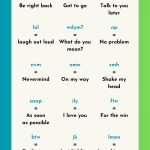
List of Text Slang, Definitions, and Examples | Chat Abbreviations

200+ List of Categories | Different Types of Categories

List of Common American Foods with Pictures

Animal Names: Animals that Start with the Letter A
About, contact, privacy policy.
Jackie Bolen has been talking ESL speaking since 2014 and the goal is to bring you the best recommendations for English conversation games, activities, lesson plans and more. It’s your go-to source for everything TEFL!
About and Contact for ESL Speaking .
Privacy Policy and Terms of Use .
Email: [email protected]
Address: 2436 Kelly Ave, Port Coquitlam, Canada


9 EFL/ESL Speaking Games & Activities Perfect for Beginners
Games are a huge part of teaching English. This is especially true for beginners, either children in their early stages of English education, or older students picking up the language for the first time.
Some established games and activities, however, rely on students having a wide vocabulary, or the ability to string sentences together. Beginners don’t have those tools. So here are 9 unique and entertaining games and activities perfectly suited for beginners, each with useful tips.
Some of these games and activities have been created by teachers across the world, while others are my own inventions. They are all suitable for small groups, big classes, and, in most cases, one-to-one tutoring.
- What’s Changed?
- Alphabet Race
- Packed Pictures
- Swat the Word
- Chain Comparisons
- Say and Draw
- Higher or Lower
- 21 (or 51 or 210 etc.)
- Monster Factory
Finding suitable games for beginners can be challenging. So beyond this list of 9, I’ve got a whole bunch more. 20, in fact. In my free ebook of 20 EFL/ESL games you have plenty to choose from, with guidance and tips for encouraging beginners and less confident students.
To get your hands on the ebook, sign up to the Enchanted ESL Newsletter . Not only will you get the ebook, but access to a treasure trove of lesson plans, role-play scenarios and game materials.
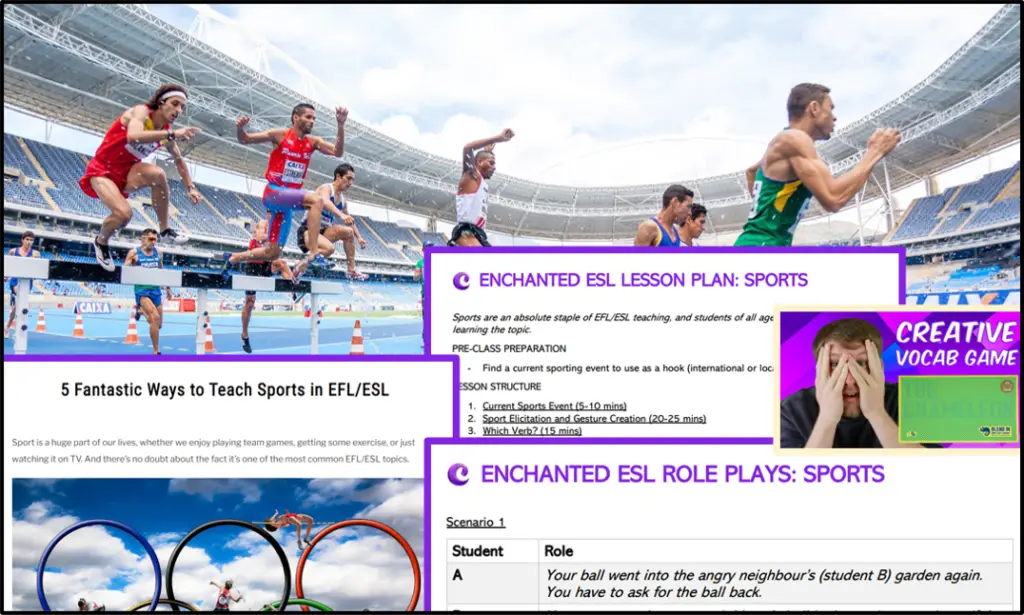
Enchanted ESL Resource Trove
- Lesson plans
- Role-play scenarios
- Printable game materials
- 20 ESL Games eBook
- Monthly newsletters with more free stuff!
Enchanted ESL Resources
Subscribe for access to my treasure trove of lesson plans, role-play scenarios and exciting resources!
I agree to receive your newsletters and accept the data privacy statement.
We use Brevo as our marketing platform. By clicking below to submit this form, you acknowledge that the information you provided will be transferred to Brevo for processing in accordance with their terms of use
A quick word on energy and vocabulary
Each of these games and activities requires a certain amount of energy. Some are exciting, physical and fast-paced, while others are calm and best done sitting at a table. Students have different amounts of energy in class. Each of the 9 games/activities presented has an associated energy level to help you choose the right one to fit your group best.

Vocabulary is crucial at beginner stages. Many of these games aim to consolidate or elicit vocabulary in a natural, relevant way. To ensure your students learn words quickly, read my article on the best method to improve vocabulary .
Now let’s get to the list!
1. What’s Changed?
Everyone knows how to play spot the difference. What’s Changed is a much more engaging alternative, in which things get mixed up in the classroom.
Estimated time: 5 minutes per round Energy level: 5/5 Materials: None
How to play One student (identifier) steps outside the room, while the others have one minute to change things inside (move tables, rearrange the pens, turn a chair upside-down, etc.). When the identifier returns to the classroom, they have to say what has changed.
For complete beginners, identifying can be as simple as pointing and saying the name of what has changed, e.g. “tables”. For slightly more confident groups, you could encourage them to say “tables moved”, or even “they moved the tables”.
- Safety and respect for people’s belongings is important – establish what is acceptable before the game and make clear everything has to go back exactly as it was at the start.
- Don’t change too much. Aim for about ten things per identifier. With a small group, each student in the classroom may change 2-3 things, while in a class of 30, have 3 students as identifiers, while the rest change one thing each.
- Make sure the identifier actually says something instead of just pointing.
- Write down what has changed and gather any new vocabulary.
- If the identifiers take too long, set a time limit.
2. Alphabet Race
This game works best in small groups, but can apply to whole classrooms or individuals. The idea is to get to the end of the alphabet as quickly as possible without making a mistake.

Estimated time: 2 minutes (although you can repeat it several times) Energy level: 4/5 Materials: Stopwatch
How to play Organise the students into a circle or line, so there is a clear order. Start the stopwatch. When you do, the first student in the order says “A”, the next “B”, then “C” etc. This continues until someone makes a mistake (start again), or you get to the end – stop the stopwatch.
This game only works once you’ve practiced the alphabet a little, otherwise you can’t get very far along the order before someone makes a mistake.
General TIPS:
- Join in yourself, acting as a model for some of the trickier letters.
- When someone makes a mistake, instead of starting from the beginning of the order, start with the student after the one who got it wrong.
- Make a note of your times and letters reached, so the group can see their progress.
- Keep the pressure low – don’t blame or criticise anyone for making a mistake, instead encourage them. Get the others students to follow your lead.
- If one student consistently struggles, put them somewhere in the order where they can get some easier letters.
- A variation is to say a word beginning with the letter instead of the letter itself.
- Take it to the next level of difficulty by going through the alphabet backwards.
Big class TIPS:
- If your class lines up to go to break/lunch, take a moment to do an alphabet race every day.
- If students get wise and start looking for positions in the order with easy letters, keep things varied – start from someone in the middle, or go in reverse order.
- If you have over 26 children, why not go around the alphabet twice?
3. Packed Pictures
This is an activity rather than a game, although there are ways to add game elements to it. It involves using a picture packed full of activity. The kind of thing you see in novelty jigsaws or those books in which you have to find a character, like Where’s Wally/Waldo.
Estimated time: 15-30 minutes Energy level: 2/5 Materials: Printed picture with lots of things happening, A4 dry-erase pockets (optional).
Not only are these pictures great fun to look at, but they provide stimulus for new vocabulary. Some of this can be targeted – you get the students to find specific things, or people doing certain actions – alternatively, it can be more student-led with them encouraged to find things that most interest them.
Here are some fun mini-games you can do:
- How many X can you find?
- Tell me five red things in the picture.
- Each student says something the others have to find (the harder to find, the better).
These pictures work really well if you have A4 dry-erase pockets. The students can draw and write all over the picture again and again, and you can re-use the pictures in later classes.
Pictures can be themed around the topic you’re studying, or a certain time of the year, like Halloween. As I don’t own any of the pictures, I can’t post them here, but searching Google Images will bring up plenty of options. I prefer the ones with a mix of both objects and people.
4. Swat the Word
An exciting, competitive listening and vocabulary game. Students have to react quickly to hit the correct word with their “fly swat”.
Estimated time: 15-20 minutes Energy level: 3/5 Materials: Fly swats OR rolled up sheets of paper, whiteboard/blackboard
If you have some fly swats, or can get them easily, students love it. If not, take some scrap paper, roll it vertically and squeeze one end to make a paper stick – easy to make and less likely to result in students “accidentally” swatting others in the class.

How to play Write at least 20 words on the board. Two students stand by the board. The teacher says a description of one of the words, and the students have to “swat” the word first. If they swat the correct word, they get a point. If they swat the wrong word, they aren’t allowed to try again, and the other student can take their time. Pushing, blocking, or any other physical contact is illegal.
The competitive aspect of this game can cause some issues, depending on your class. It can get a little too tense for some. However, if everyone knows the rules and the stakes aren’t too high, it’s great fun.
- In a large class, divide the students into two equal teams and have representatives from each team (this can get rowdy)
- Get the students to brainstorm the vocabulary first.
- Don’t remove the vocabulary even if someone has already swatted it.
- If you’re in a small class without a whiteboard, use a piece of paper as the board, and the end of a pen as the “swatter” – you could call it Word Jab instead of Word Swat.
- Word your descriptions carefully. Ideally, you’ll have related vocabulary in which one part of the description applies to many e.g. “It’s an animal with four legs…”, “it lives in the jungle”, “and it’s orange and black”. Each part of the description gives an extra clue and narrows it down. This means the students have to listen well.
It’s interesting to see how your students approach the game. Some are so eager to swat a word, they hardly listen to the description and just swat the first thing they see (usually wrong). Others wait for their opponent to mess up first. And some are so afraid of getting it wrong, they never swat anything!
Of course, the games on this list are just the start. I have many more to share with you in my eBook of 20 ESL Games. Many of them are ideal for beginners, or can be easily adapted. You can get it all for free by signing up to the Monthly Newsletter!
20 ESL Games by Enchanted ESL
- Detailed instructions & advice
- All ability levels
- In-person and online
- Individuals, small groups and large classes
Get the 20 Games PDF
Enjoy access to a trove of great resources as a newsletter subscriber.
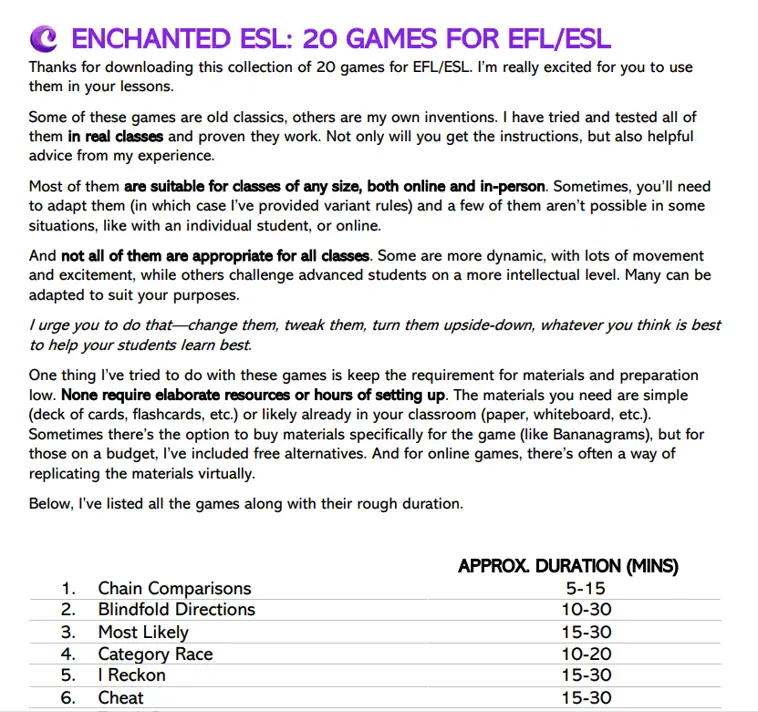
5. Chain Comparisons
This game practices vocabulary and introduces the idea of comparatives. This one is great for small groups and big classes, but doesn’t work too well with one-to-one classes.
Estimated time: 3 minutes (can be repeated) Energy level: 4/5 Materials: Timer
How to play Organise the class into a circle or line to show a clear order. Establish how things will be compared e.g. size: bigger/smaller. Start a timer for 2 minutes. Teacher starts with a word, for example: “car”. The first student in the order has to say something bigger than a car. They might say, “house”. The following student now has to say something smaller than a house, e.g. “cat”. Then the next says something bigger, then smaller, and so on. Repetition is not allowed. Count how many correct words they come up with before the 2 minute timer ends – that’s the class score.
There’s an element of competition in this game, but it’s the whole class working together. It can get quite stressful with the time pressure, so gauge your class and remove that element if it’s causing issues.
Other things you can compare with are cost: cheaper/more expensive; speed: slower/faster; age: younger/older and many more.
- Make a note of the score each time, and try to improve when you repeat the game (I found my students love trying to get a new high score).
- Vary the time limit depending on the class level. If they know very little vocab, reduce the timer to one minute, or 90 seconds. If you have a big class, extend the time limit so each student gets multiple goes.
- Encourage the students to think of a few answers before their turn, so they’re ready to say something. If they don’t, the pressure can make their minds go blank.
- If students shout out answers when it’s not their turn, you can deal with it by stopping the timer, deducting points from the class total, or removing them from the game. Alternatively, you might want to encourage them to help each other (as long as they allow the person whose turn it is to think first).
- Join in the order yourself to introduce some new vocabulary on your turn.
6. Say and Draw
Need a few minutes to calm down? Say and Draw is great for getting students to relax, practice their listening skills as well as speaking. There’s also an eyes-closed variation which is hilarious.
Estimated time: 2 minutes per turn (do as many turns as you like) Energy level: 1/5 Materials: Drawing equipment for each student (A4 dry-erase pockets are ideal)
This activity is remarkably simple, but gives an opportunity for practicing vocabulary, prepositions, and even some grammar forms. You can find out how to play in this video! (While you’re there, subscribe for many more brilliant game ideas).
One person describes what the others should draw. It’s best to start with the teacher describing, to indicate how fast to speak, and the kind of language they can use. For example:
First of all, draw a beach with the sea next to it. PAUSE. In the middle of the beach, there’s a palm tree with three coconuts. PAUSE. Under the palm tree, draw three baby turtles and their mum. PAUSE. It’s sunny, with two small clouds in the sky.

The students don’t need to understand everything you’ve said. In fact, it’s a good way to expose them to some more natural English, as long as you clearly say the specific things they need to draw.
When you’ve given them an example or two, let one of the students have a go at describing. While they’re speaking, gently ask them questions to elicit more details, like “where?”, or “how big?”
- It’s not an art competition – students should draw as quickly as possible to keep up with the person talking.
- Watch them draw and modulate the speed of your description to match – they should be in a slight rush, but not overwhelmed.
- Let them be creative with descriptions. Turtles on the beach are nice, but hamsters riding unicorn-dragons on the moon will have everyone laughing.
- To increase the fun a step further, have the drawers close their eyes. The descriptions need to be simpler, but the results are often hysterical, especially when they use their English to justify why the dog’s eyes and ears are on its back.
- Conversely, if you want to create a relaxed atmosphere, play some gentle music and slow the pace.
- It might be tempting to let the describer pick which drawing they like best. I avoid this as it turns into a popularity contest. Instead, you could reward students who have drawn the picture most accurately given the instructions.
Either as a fun game sitting down, or a gentle listening exercise, this is a great way to take a break from an exciting lesson, while letting your students express their imaginations.
7. Higher or Lower
Most card games require an intermediate/advanced level of English. Not this one. Higher or Lower is the card game you all know, just with an English focus. It’s possible to play this with a full class with a few modifications, but it works better with smaller groups.
Estimated time: 5 minutes Energy level: 3/5 Materials: A deck of standard playing cards
Before you play, make sure your students are familiar with the rankings of a standard deck of playing cards, because they might not know what the Jack, Queen or King represent.

How to play Shuffle the cards and flip over the top one. The first student (left of the teacher) says if the next card is higher or lower. Turn over the next card to see. If they’re correct, they continue. If they’re wrong, they keep all the visible cards except the last one flipped over, and the turn moves to the next student who does the same. If the card turned over has the same rank as the one before, continue onto the following card. When the deck is exhausted, the player with the most cards wins.
To make this an English-focused game rather than just a normal card game, change the words “higher” and “lower” to other comparatives (e.g. cheaper/more expensive), saying big objects or small objects, or separate vocabulary into two categories, for example team sports and individual sports and assign them to “higher” or “lower”.
There are a number of different ways you can adapt this game to your needs, so get creative and know your students. They will love it when they get a long run of correct answers.
- Avoid putting too much emphasis on the winner – it’s a game of luck, and sometimes a student loses through misfortune, not their English skills. Play a few games and their luck will probably balance out.
- In a large class, divide into groups. If you can’t, instead of students playing individually, put them in 2-4 teams and have them line up. The player at the front of the line gives one answer and goes to the back of the line. This way you rotate quickly and there’s more energy and anticipation for those waiting in line.
8. 21 (or 51, or 210, etc.)
This game practices numbers. I used to play it as a drinking game at university and had a great time, although there’s no alcohol involved in this version. Even so, the mathematical aspect of the game might make it unsuitable for very young children.
Estimated time: 5 minutes Energy level: 3/5 Materials: None
21 is the standard version of the game, for practicing numbers between 1 and 21, but if your students are beyond that point, you can change the numbers to range from 30 to 51, or going up in tens from 0 to 210. Maybe you’re learning thousands, go from 50,000 to 71,000. It doesn’t really matter which numbers you use, as long as there are 21 numbers in play.
How to play Players make a circle. The first player begins at 1 and play proceeds in a clockwise direction. Each player can say one, two, or three numbers. If they say one number (e.g. “one”), the turn passes to the next person. If they say two numbers (“one, two”), the direction of play changes and the turn passes to the next person (now in the other direction). If they say three numbers (“one, two, three”), the turn skips the next person and goes to the following. Play continues until someone is forced to say the number “twenty-one” (or whichever number your game ends at). That player then has to do a “punishment”, e.g. talk for 30 seconds about a topic. Suggested rules: If someone says two numbers (e.g. “five, six”), the next person can’t say two numbers – they have to say one number or three numbers. The same applies to saying three numbers. Extra fun rule: Each round, someone (could be the loser of the last round) creates a new rule. For example, instead of saying “five” you have to say a colour. Or, if you’re feeling really confident, the new rule could be to reverse the order of the numbers.
If you’re familiar with this game, the rules here should make sense. If not, and my brief description of the rules isn’t enough, here’s a link to the rules for the drinking game on wikipedia .
- Keep the “punishments” light and related to English. Making them talk about a topic for 30 seconds is a good choice, as long as your students won’t feel uncomfortable doing that. An alternative would be to say all the numbers in the game in reverse order.
- Mistakes during the game, like talking out of turn, or saying an incorrect number, shouldn’t be a problem. If they’re becoming too frequent, think up a minor “punishment”.
- If you’ve got adults who have quick minds, you can get really creative with the added rules. For example, on multiples of four, they have to stand up and do a dance and on multiples of five, they have to shout the number (see if they remember to do both on 20).
- If you’re playing in a full-sized class, you will want to either split them into groups, or extend the range of numbers, so each student gets a couple of turns. I’d suggest the first option. Groups of 5-8 are optimal.
9. Monster Factory
Practice numbers, body parts and more with this crazy activity of building the weirdest monster you’ve ever seen. Children and adults will love it in equal measure.

Estimated time: 5 minutes prep + 5 minutes per turn Energy level: 2/5 Materials: Drawing materials, paper, scissors
Before the activity, you need to set up two pots/hats/piles with folded pieces of paper inside. In one, the pieces of paper will have a number (1-8) and in the other, they’ll have parts of the body.
It’s a good idea to get your students to help. If they come up with the body parts and even write the words themselves, they’ll get some vocab review and spelling practice.
Ideally, the pieces of paper with the body parts should all have something different on.
How to play One student is in charge of the pots/hats/piles. They are the Monster Designer who reveals what’s on the pieces of paper during the game. First, the other students should draw a blank torso and head on a piece of paper (or A4 dry-erase pocket) to get them started. Next, the Monster Designer takes one piece of paper from each pot and reads them out loud. For example, “three” and “nose”. If they have the ability, they can make a full sentence of “draw three noses on your monster”. The students who are drawing should now draw three noses on their monster. This continues for five repetitions (or more, if you want). At the end, the students will have a ridiculous picture of a monster with all sorts of crazy body parts.
Some drawings I’ve seen from this game are beyond my wildest imagination, and have had the whole class roaring with laughter. This is a great opportunity to get some conversation going as each person talks about their picture.
- If you only have time for one round, have all the students drawing, and alternate who unfolds the pieces of paper
- You can do this with a full class, or in smaller groups. In a full class, consider switching who unfolds the pieces of paper each time so everyone speaks.
- Use A4 dry-erase pockets instead of paper and pens/pencils – it’s easy to rub out mistakes and doesn’t waste paper.
- If your students are struggling, simultaneously draw a monster of your own on the board.
- If your students have gone beyond vocab for parts of the body, you can introduce items of clothing and even have a pot for the monster’s feelings.
The randomness of this game makes it great. I would say it’s not the best game for getting students to speak, but it’s certainly a good listening and vocab exercise, both vital skills for beginners.
Adapt and innovate
When I research games and activities online, I rarely stick with the exact rules shown. It’s important to adapt. What I like about all 9 games here is their flexibility for different group sizes and abilities.
Ultimately, the point of these games is to learn English in a fun way. Whatever it takes to achieve that goal, you need to do it – and that includes changing the way you play, and innovating your own variations.
I hope these games help your students take their English up a level. And if you’re looking for more great games, sign up to the Enchanted ESL Newsletter to get your free copy of the 20 EFL/ESL Games ebook and take advantage of the monthly emails with role-play scenarios, lesson plans and more games!
If you’re looking for more games and activities, check out my other lists: 9 EFL/ESL Speaking Games & Activities Perfect for Beginners 9 EFL/ESL Games & Activities for Intermediate Learners 9 EFL/ESL Games and Activities for Advanced Learners 9 High Energy EFL/ESL Games for Boosting Vocabulary 9 Engaging Homework Ideas for EFL/ESL: No worksheets! 9 Exciting EFL/ESL Activities for Writing & Spelling 9 Fun EFL/ESL Games & Ideas With Standard Playing Cards 9 EFL/ESL Games With No Materials or Preparation Needed 9 EFL/ESL 5 Minute Games Every Teacher Needs to Know 9 Superb EFL/ESL Games & Activities Using Just Pen & Paper 9 Classy EFL/ESL Games & Activities for Adults (+ tips) 9 Confidence-Boosting EFL/ESL Speaking Games for All Levels 9 Exciting Flashcard Games for EFL/ESL Classes
I’m Will, a teacher, blogger, and fantasy author. I grew up in England, but now I live in Spain where I teach private English classes to dozens of wonderful students.
Similar Posts

9 Classy EFL/ESL Games & Activities for Adults (+ tips)
When thinking of EFL/ESL games, we often picture loud, energetic sessions with kids. They’re a lot of fun. But with adults, things are different. While some grown-ups…

5 Engaging Ways to Teach Shopping in EFL/ESL
Everybody goes shopping at some point, whether it’s to the local market or to a huge department store. That’s why it’s a big part of English teaching….

Actually Useful Ideas For Beginner Conversation in EFL/ESL
Teaching English conversation to beginners is a tricky business. If they can hardly speak the language, how on earth are you going to maintain an hour of…

5 Exciting Ways to Teach Celebrations & Festivals in EFL/ESL
Festivals and celebrations are a huge part of culture no matter where you are in the world. Whether it’s enjoying your students’ local traditions or sharing yours…

9 Confidence-Boosting EFL/ESL Speaking Games for All Levels
There’s no doubt that speaking English is one of the most highly sought after skills in global business, let alone how useful it is for travel and…

9 EFL/ESL Games and Activities for Advanced Learners
When English learners reach an advanced level, it’s tempting to think they’re beyond the type of games and fun activities we use with lower-level students. I think…

Distinguish parts of speech II
Loading ad...
TONO ENGLISH
- Google Classroom
- Microsoft Teams
- Download PDF


Keeping it Human: Four Things Every Teacher Should Consider When Using Technology

1. Promote Digital Literacies
2) develop digital wellbeing, 3. humanise the learning experience, 4. use data in positive ways, conclusion:, you may also like, 4 ways to teach multimodal literacy in the language classroom, multimodality and multimodal literacy: what are they and why are they important in elt, 5 things every language teacher should know about ai, leave a reply cancel reply, recent posts, how graded readers and engaging activities can ignite student interest in the magic of books, helping advanced students overcome the language learning plateau, ‘play is for children’: myths about learning through play, the big debate: ai and inclusivity, four more reasons you don’t need to feel worried about teaching english pronunciation., recent comments.
Copyright 2023 © Oxford University Press 2023
Read our Privacy Policy , Cookie Policy & Legal Notice .
This blog contains external links. OUP are not responsible for the content of external sites nor do we endorse any companies or organisations linked to. Any views or opinions expressed in the articles on these posts are those of the author(s).
Oxford University Press - ELT
For Others, With Others
Sophia’s Endeavor to Evolve
Directly Speaking with High School Students Interested in Japan to Turn the Yotsuya Campus into a Melting Pot

- # Vice President for Admission Affairs
- # For Prospective Students
- # For Guarantors
Shigeru Nishizawa Vice President for Admissions Affairs Professor, Department of Management, Faculty of Economics
- bookmark#toggle keyup.enter->bookmark#toggle onBookmarkItemUpdate@window->bookmark#handleUpdate">
Sophia University has launched two initiatives to bring even more diversity to the Yotsuya campus, which some call its own small international community. Shigeru Nishizawa, Vice President for Admissions Affairs, talks about the new approach the University is taking to communicate the essence of Sophia University to high school students outside of Japan.
Large International Attendance at the On Campus Information Session for English-taught Programs
One of Sophia University’s strengths is the internationality and diversity of its campus. University students come from every corner of the world, choosing Sophia as a destination for short- and long-term study abroad. Even one out of every six Sophia University faculty members is a foreign national.
Sophia offers many opportunities to study regions that may receive little attention or dedicated fields of study at other universities, such as Africa and Muslim countries. We believe the ability to respond to today’s unpredictable times and situations is developed through exposure to a variety of different values, which may show us the hints for surviving and thriving that hide in the shadows.
However, when I ask myself whether the current level of diversity we have achieved at Sophia University is the “ideal,” and whether we have done everything possible to improve campus diversity, I feel that we still have so much we can and should do.
The first On Campus Information Session for English-taught Programs was held in July 2023 to further diversify the campus. The main targets of this initiative are Japanese high school students living abroad who have returned to Japan for their summer holiday. We hypothesized that the more of these internationally experienced students we have on campus, the more opportunities there are for their fellow students to experience the different languages and cultures each of these students brings.
Many Japanese high school students who have lived abroad for a long time are not proficient in Japanese. If these students wish to enter a Japanese university and work in Japan, their education must offer the ability to earn graduation credits solely through English courses and offer a full range of Japanese language education.
Therefore, Sophia has adapted to offer multiple English degree programs across a wide variety of academic fields, with Japanese language courses for non-native speakers at different levels. Our On Campus Information Session for English-taught Programs is held so that prospective students can see first-hand how this campus environment is suited to their situation.
More than 500 high school students participated in the On Campus Information Session, vastly exceeding our expectations and demonstrating a clear need for in-person events even for those living overseas. Due to this high level of interest, we have also released English-language brochures for our three English-language degree programs, in addition to the existing university brochures.
We plan to continue holding these on-campus events during this academic year and beyond, and have high expectations for the number of foreign-raised Japanese students participating.
Visiting Local High Schools to Develop “Japan fans”
Overseas, there are not only those with roots in Japan, but there are also those who have no connection to Japan by family relation or upbringing, but are nonetheless interested in Japan and can be called “Japan fans.” We have begun to approach this previously untapped segment of high school students, inviting them to enroll not as short-term or long-term exchange students, but as full-time undergraduate students.
Take Thailand, for example. Many Japanese companies have established operations there, and Japanese goods and media are well-known and loved by the country’s many Japanophiles. Many Thai high school students are proficient in English, and if they attend Sophia University, a path to work in Japan as a trilingual speaker after graduation is opened.
Therefore, it became important to first visit local high schools in countries and regions with high degrees of interest in Japan and growth potential. We wanted to share more about Sophia University with students in these countries and also hear from them and their teachers about what is important for a university to offer.
As part of Sophia’s first such outreach effort, I will be traveling to Thailand and India, where I plan to visit 5 or 6 schools within a week. While Sophia University has nine overseas offices, as well as a global network of academic/international organizations, corporations, and alumni, I wanted to embark on this visit without relying on these connections and instead dive into these interactions with these high schools to get a true, local understanding.
Sophia University’s name recognition abroad as a “prospective school” remains unfortunately low at this point and there are probably very few of these high school students who know Sophia. To be honest, we cannot predict how many high school students are interested in Japan or how they will react to what we have to say, and what actions they take as a result.
However, without visiting the sources where our future international students hail from, we will fail to understand many things about their needs and aspirations. By understanding the size of the market, its needs, and if necessary, developing an entrance examination and curriculum more suitable to these students, we aim to increase the ratio of foreign students from the current level of less than 20%, to more than 25%.
The excellence of Japanese companies, which has long been overlooked, is now attracting attention from overseas as the Nikkei Stock Average reached an all-time high in late March. If Japan is found to offer opportunities for success, the number of foreign-raised Japanese people and non-Japanese youth who are “Japan fans” wanting to come to Japan will increase more than ever before.
We want to make the Yotsuya Campus into an environment where these high school students who aspire towards a future in Japan can take on new challenges. The diversification that this will bring about on campus will open up possibilities for all students, including for our Japanese students. Diverse environments are the source of innovation and the creativity fostered at the Yotsuya Campus will be a force that will further enhance Sophia University and Japan’s appeal.

- # Sophia’s Endeavor to Evolve
Official Social Media
Frequently Viewed Pages
- Sophia University Campus and Overseas Offices
- Facts & Figures
- The Spirit of Sophia University
- English-taught Programs
- For Prospective Students
- For Guarantors
- For Current Students, Faculty and Staff
- For General Public
- For Corporate Partners, Press and Media
Sophia School Corporation
- Sophia University
- Sophia University Junior College Division
- Eiko Gakuen Junior and Senior High School
- Rokko Junior and Senior High School
- Hiroshima Gakuin Junior and Senior High School
- Sophia Fukuoka Junior and Senior High School
- Website Policy
© Sophia University. All Rights Reserved.
- Scholarship
- Open Campuses
- Study Abroad Programs
- Extracurricular Activities
Privacy Overview
Florida State University
FSU | The Graduate School
Main navigation Pulldown
The graduate school.
- Prospective Students
International Admissions
We are now accepting Graduate applications for Fall 2024, and Spring 2025.* *Please contact your department for application open terms and deadlines.

Our community welcomes you
Each year, the university enrolls approximately 1,700 international students. We are proud to offer extensive support and services to our international population. International applicants should plan to apply early so they have ample time to obtain their immigration documents and make living arrangements in the U.S. Any F-1/J-1 students planning to obtain their I-20/DS-2019 should contact the Center for Global Engagement at [email protected] . Please check with your department regarding deadlines.
International Admissions Requirements
In addition to meeting graduate university admissions requirements, international applicants must also meet the following University requirements to be considered for admission.
English Language Proficiency Requirement
Official English Language Proficiency results are required of all international applicants whose native language is not English. The following are the minimum scores required for admission to the University, although some departments require higher scores at the graduate level:
Internet based TOEFL ( IBTOEFL ): 80
Paper based TOEFL ( TOEFL ): 550
International English Language Testing System ( Academic IELTS ): 6.5
Pearson Test of English ( PTE ): 55
Duolingo : 120 (Summer 2022 and Forward)
Cambridge C1 Advanced Level : 180 (Fall 2022 and Forward)
Michigan Language Assessment : 55 (Fall 2022 and Forward)
Although official scores are required, most departments will begin to review your application with self-reported scores, while they are waiting for the official scores to arrive. You can self-report your scores on your Online Status Page, after you submit your application.
The English Language Proficiency requirement can be waived, at the University-level, for applicants who have earned a minimum of a BA or higher in the US or in an English-Speaking Country. Please note, your department may still require proof of English-Language proficiency. *A variety of countries are exempt from the English language proficiency requirement.
Transcript and Credential Evaluation Requirements
All transcripts/academic records that are not in English must be accompanied by certified English translations.
To be considered "certified," documents should be true copies that are signed and dated by an educational official familiar with academic records. Any translated record should be literal and not an interpretive translation. Documents signed by a notary or other public official with no educational affiliation will not be accepted.
If the transcript/academic record does not indicate the degree earned and date the degree was awarded, separate proof of degree is required.
International applicants or degrees earned from international institutions must submit their official transcripts through the SpanTran pathway portal, or from another NACES approved evaluator. SpanTran has created a custom application for Florida State University that will make sure you select the right kind of evaluation at a discounted rate. Florida State University recommends SpanTran as our preferred credential evaluation because it offers an easy way to streamline the application process.
Please read more about our general transcript requirements on our Graduate Admissions page.
International Transfer Credit
International transfer credit is awarded for coursework completed at an accredited (recognized) institution of higher learning. No credit is awarded for technical, vocational, or below-college-level coursework, or courses completed with grades below "D-." An official course-by-course evaluation is required for all academic records from non-U.S. institutions. We recommend the evaluation be done by a member of the National Association of Credential Evaluation Services .

SUPPORT TO HELP YOU THROUGHOUT THE PROCESS.
The Center for Global Engagement (CGE) and its staff are here to serve international students and their families. They may advise you about:
- F and J visa requirements
- Cultural adjustment
- Employment matters
- Housing assistance
- Assistance with personal concerns
- Maintaining your visa status
Many academic programs only accept applications for a specific admit term. Contact your academic department to determine which admit term to apply. It is recommended that you submit your application as soon as the admit term opens. CGE also assists students throughout the New International Student Checklist and Process . You may learn more about what CGE has to offer by emailing [email protected] .

Center for Intensive English Studies
Need to improve your English skills? FSU’s Center for Intensive English Studies can help! At CIES, you will be given personalized instruction by highly qualified teachers in a safe, friendly environment.
Please note that admission to and completion of the CIES program does not necessarily guarantee admission to the University as a degree-seeking student.
CIES also offers:
- TEFL certification opportunities
- Credit-bearing courses and workshops to enhance your English speaking ability
Learn more about how the Center for Intensive English Studies can help you.
Florida State University is required by U.S. federal regulations to verify the financial resources of each applicant prior to issuing the Form I-20. If granted admission to the University, an email with instructions on how to complete the I-20 will be sent from the Center for Global Engagement (CGE). You will provide information verifying your financial support (bank statements, award letters, scholarships, etc.) through the I-20 application. FSU requires proof of financial support for the first year of study and demonstrated availability of funds for the length of your academic program
Estimated International Student Costs:
For more information on estimated costs of living and the I-20 process, please visit CGE’s website .
I-20 Application
Shortly after admission, students will receive an email with instructions for completing the online I-20 application to demonstrate proof of adequate funding. Florida State University is required by U.S. federal regulations to verify the financial resources of each applicant prior to issuing the Form I-20. Applicants must show proof of financial support for the first year of study and confirm availability of funds for the length of the academic program.
For more information, contact the Center for Global Engagement at [email protected] .
US Federal Grants and Loans are not Awarded to International Students
Graduate students may apply to their respective departments for assistantships or fellowships, although funds are very limited. For further information, please contact your academic department directly.
SPEAK (Speaking Proficiency English Assessment Kit) is a test for evaluating the English speaking ability of non-native speakers of English. At FSU, the SPEAK test is administered by the Center for Intensive English Studies to international students who have been appointed or will be appointed as teaching assistants in an academic department at Florida State University.
For more information, click here .
Explore Funding Opportunities
May the TOEFL be waived?
The TOEFL may only be waived as a test requirement if the student has received a bachelor's or master's degree from a U.S. institution.
Can you review my documents prior to applying?
Students must submit the application, application fee, and any required departmental materials for application materials to be reviewed.
Can the application fee be waived?
Unfortunately, the Office of Admissions is unable to waive the application fee payment for graduate applicants. In order to complete your application for review, you must submit the application fee payment by logging in to your Application Status Check , along with any other documents required by the department.
When will I receive a decision?
Applications are reviewed holistically by each graduate department. Please contact your department for information about decision timelines. Please note that the application must first be completed before it can be reviewed. Contact your department for more information.
Can the GRE be waived?
FSU is currently waiving the GRE requirement for most master’s and specialist programs through Fall 2026*. For more information on whether the requirement can be waived, please contact your graduate department.
* Excludes the College of Business
What if I don’t meet the English Language Proficiency score requirements?
The FSU Center of Intensive English Studies (CIES) offers comprehensive courses to help students improve their English skills. Students who complete the top-level of the CIES program will not have to take an English Language Proficiency test.
What is the F-1 visa/I-20 process?
- Students can learn more about the I-20 process here .
- Students can learn about the visa here .
Do you have funding available for International students?
- The Graduate School offers fellowship and grant opportunities for graduate students. For current FSU students, the Office of Graduate Fellowships and Awards assists in identifying and applying for external funding opportunities. In addition, here is some more information about additional funding opportunities for international students.
- There may also be additional funding opportunities through your department. Please contact your graduate representative for assistance. If you do not know who to contact, please email us at [email protected] for assistance.
Are there on-campus housing opportunities?
University housing costs are not included in the tuition and fees at Florida State University. If you want the option of living on campus, you can apply for housing online as soon as you are officially admitted to FSU. Housing at university-owned residence halls and apartments fill quickly. You can also find off-campus housing options by clicking here .
You are using an outdated browser. Please upgrade your browser or activate Google Chrome Frame to improve your experience.
13 Entertaining ESL Homework Ideas to Keep Your Students Engaged
Homework may not be many students’ favorite thing, but research says it’s truly an effective learning tool that teachers should use .
The trick is assigning great homework.
To help you do this with ease, we’ve compiled an awesome list of 13 homework assignments that will have your ESL students begging for more.
1. Read a Short Story
2. share a passion, 3. start a chat group, 4. listen to a podcast, 5. write a letter, 6. write an amazon review, 7. do a wikipedia edit, 8. write a short story or poem, 9. share their culture, 10. catch a movie, 11. meet new people, 12. analyze a song, 13. go on a photo scavenger hunt, what makes homework effective.
Download: This blog post is available as a convenient and portable PDF that you can take anywhere. Click here to get a copy. (Download)
Have students read a short story for homework and then ask them to tell the class about the story in the next session.
I would recommend giving students some suggestions on what short stories to read, depending on the level of your students.
Here are some suggestions of short story collections for each level of ESL learner:
- “The Very First Americans” by Cara Ashrose: This collection of short stories features Native American culture and history, written in simple language.
- “Oxford Bookworms Library: Starter Level” This series offers simplified versions of classic stories, such as fairy tales, adventure stories and more.
- “Classic Tales for ESL Students” by L.A. Hill: This collection of classic stories from literature is retold with easier vocabulary and sentence structure.
Intermediate
- “The Best American Short Stories” This series features contemporary short stories from a wide range of American writers, so there’s something for everyone here.
- “Short Stories in English for Intermediate Learners” by Olly Richards: This collection of engaging stories is designed specifically for intermediate ESL students.
- “Roald Dahl: The Collected Short Stories” This delightful collection of quirky and imaginative tales has become a favorite of many of my students.
- “Interpreter of Maladies” by Jhumpa Lahiri: This Pulitzer Prize-winning collection of short stories explores the immigrant experience, something which many ESL students can relate to.
- “Dubliners” by James Joyce: This classic collection of interconnected stories captures the essence of Dublin in 1914. But it still feels modern to many students.
- “Nine Stories” by J.D. Salinger: This classic collection of short stories is a class favorite when I’ve used it.
What do your students really care about? Give them a chance to talk about it in front of the class.
Have each person choose something they’re passionate about, something they might consider themselves an expert on.
Challenge students to think of a creative way to present five must-know facts about that subject. They might make a movie, create a poster or brochure, write a song or even put on a skit.
Have each person present their creative project to the class, and then give the class five minutes to ask questions of the presenter.
Set certain parameters like students must speak in complete sentences or require that every student ask at least two questions at some point during the presentations.
Students will love sharing about their passions, and they’ll get some great speaking, listening and discourse information in the process, as well as teach the rest of the class some interesting vocabulary.
Ask for class for a volunteer to start a class WhatsApp chat group. They can also decide to use another messaging app like Telegram, Viber, Voxer or any other app that has a group chat function.
Encourage them to send at least one message and to respond to a couple others for their homework.
This text group has the added advantage of students being able to make friends with one another, and a place to ask about missed homework assignments on days when they can’t make it to class.
Note that if a student doesn’t want to be included in the chat group, you should have a back up assignment prepared for them.
Listening is one of the ESL student’s most difficult skills to acquire, so listening to a short podcast episode is ideal homework.
You can ask students to write a little about the podcast to turn in to you, or you can ask them to briefly summarize what they heard for the class in the next session.
Here are some suggestions for well done podcasts:
The English We Speak : Produced by the BBC, this podcast focuses on teaching commonly used phrases and idioms in conversational English.
The Moth : A storytelling podcast where real people share their personal experiences and anecdotes in English.
Stuff You Should Know : Though not specifically designed for ESL students, this podcast covers a vast array of interesting topics, providing exposure to diverse vocabulary and subject matters.
Ask your students to write a letter . The letter can be written to a friend or family member (which they could then actually mail or email), or it could be a fan letter to a favorite musician or actor. They could even write a letter to Santa Claus or a historical figure.
For example, a student might choose to write a letter to Marie Antoinette, asking her what it was like to be the queen of France at such a young age.
You can also choose to have students write letters to one another. Then the next homework can be writing that letter writer back.
Ask you students to review a product on Amazon (or any other shopping website that has reviews). Ask them to select a product they have really used, so they have a genuine opinion on the quality of the product and whether it lived up to their expectations.
Then, in the next session, show the reviews on the overhead projector to the class and ask a student to read the review.
You can then go over any errors in vocabulary, grammar or sentence structure and revise the review together as a class.
Since anyone can edit a Wikipedia article, it’s a great place for ESL students to hone their writing and editing skills, and they’ll have a built-in readership, too!
Ask students to select a person that they know a lot about—a well-known figure from history, pop culture, music or film would all work. Then ask them to read the Wikipedia entry to see if they can add anything else to the article.
Perhaps the article on Ryan Gosling is missing a key detail about his recent Ken performance. If so, the student will revise and edit the article. They should take notes on what they changed, so they can explain it to you or the class the next day.
Ask your students to get creative. Have them write a short story or a poem . This can get them to use descriptive language that they don’t always have a chance to use.
One good activity to do before you assign this homework is an adjective bubble chart. For this, you start with one adjective. For example, write “moist” on the board, circle it and then draw 4-5 lines coming off of the”moist” bubble.
Ask your students to come up with other adjectives that are related to “moist” and so on. They may come up with “wet,” “watery,” “soaked” or “damp.” Then draw lines from each of those. This can lead to words that you never expected to come up.
Have your students select 3-4 adjectives from this introduction activity that they’ll use in their story or poem.
Ask your students to prepare a short presentation on an aspect of their home culture to tell the class about in the next session.
For example, a student from China may explain the Lunar New Year, a student from Vietnam may explain Tet or a student from El Salvador may tell the class about their quinceañera .
They can use photos, art, a PowerPoint presentation or they can just explain in their own words.
Then open the class up for questions.
Can you legitimately send students to the movies for homework? You can when you’re teaching ESL.
Your students don’t have to commit to a full-length movie. Instead, you can use the videos on FluentU to screen mini-lessons using clips from TV shows and movies, movie trailers, news segments, vlogs or music videos.
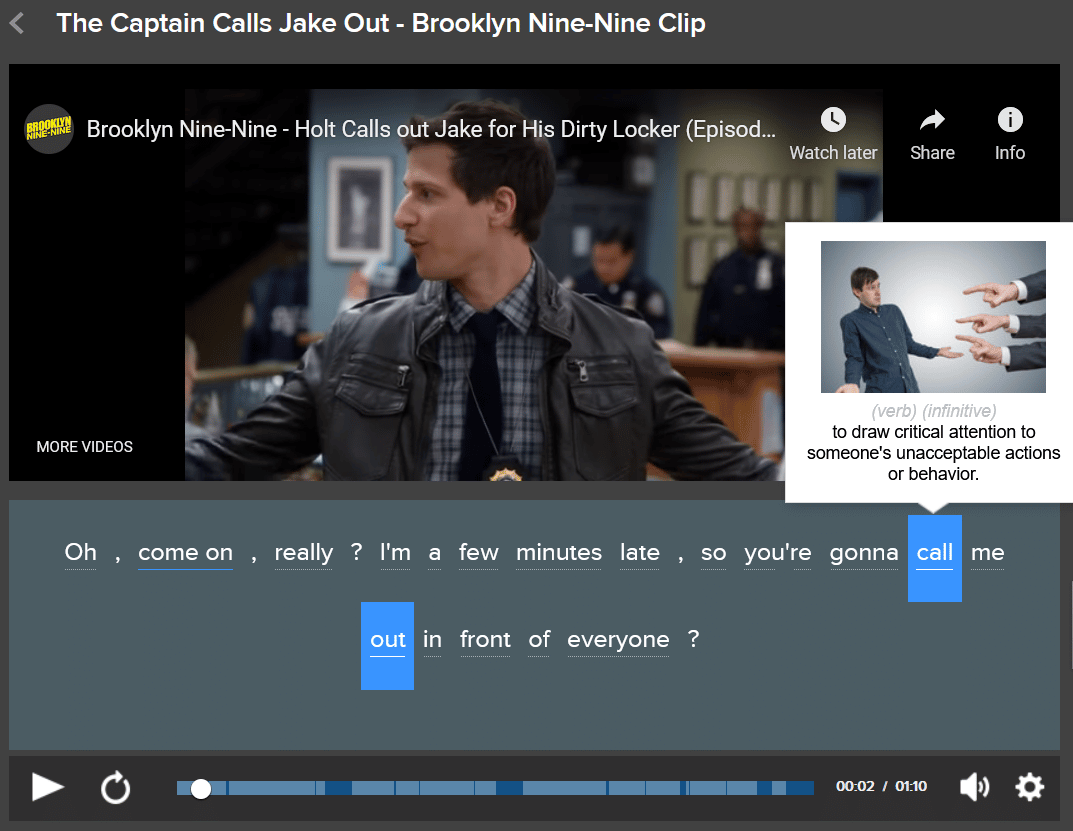
Use these videos in the classroom or assign homework to watch a few and complete the subsequent quizzes. You can also ask students to complete flashcard quizzes based on vocabulary words you want them to pay special attention to. These quizzes are adaptable so every student will have a unique experience catered to his learning level.
There are plenty of ways to use a movie for language development. And whether students watch a new release or catch an old Elvis flick on TV, they can do any of the following activities as homework:
- Summarize the plot.
- Describe a main character.
- Note new or interesting vocabulary (particularly slang) they hear while watching.
- Write an interview with one of the characters in the movie.
I’m sure you also have your favorite movie-related language activities and many work as homework assignments. So get creative with how you have students share about what they watched.
For the most part, people are willing to help someone in need, and that is doubly true for someone who needs to complete an assignment for school.
That’s why sending students out to interview native speakers on campus is such a fun homework assignment.
Start by helping your students write a list of questions they’ll use for their interviews. Students can choose a topic or you can assign one, like leisure activities or celebrity news.
Tell students to list five to ten questions they might ask on that topic that will elicit specific answers.
As a class, discuss how students might introduce themselves to a potential interviewee.
Then send students out to their interviews after class. They can share the answers they got in the next session.
Music is great for English learners since it stresses many aspects of language that can otherwise be hard to isolate, like the emotion of language, intonation and stress.
Have students choose their favorite English language song to listen to for homework and then ask them to do the following:
- Practice the lyrics to learn intonation and rhythm.
- Note slang and cultural references in the songs.
- Summarize the theme of the song, or just what it’s about.
- Have students share their favorite lyrics and what a particular song means to them.
Give individual students or groups of up to three students a list of items to find on their homework scavenger hunt. But instead of being specific in your list (for example, including items such as cat), be descriptive in your list.
You might include items such as something frightening, something beautiful, something quiet, something cool.
Students find items they think fit the description. For example, someone who is claustrophobic might choose an elevator for something frightening. They then take a picture of it.
The next day, have each person get with a partner and show them the pictures they took for each item on the list.
If the connection is not obvious, students should ask their partner to explain why they chose a particular item, such as the elevator.
Assigning homework that works isn’t as hard as you might think, especially if you focus on the following points.
- Put your homework in writing. It can be tempting to just announce homework assignments to students at the end of class, but language learners benefit when you reinforce what you say with what they can see. So take a minute to write any homework assignment on the board so students can read it as well as listen to it.
- Let students know what goals you have for a particular assignment. Is it practicing a certain grammar point ? Improving their listening skills ? Pronunciation practice ? When students know why they’re doing something, they’ll be able to tell on their own when they’ve successfully completed their homework assignment.
- Keep your homework practical . Your students may not find themselves planning out a menu for Thanksgiving when they leave your ESL classroom, but odds are they’ll have to order food at a restaurant at some point. Think about realistic ways students will have to use English in the real world and try to make your homework practical.
- Let your students be creative . Give your students choices on how they express themselves or present information. It’s okay for students to make a home movie, put on a one-man play or paint a picture to present to the class. Just because you prefer a particular type of creative expression doesn’t mean your students do, so give them choices and let them express themselves.
- Make homework fun! Every class has its own personality, so what’s fun for one might not be fun for another. Tailor your assignments to the personality of your class. Think about what they would think is fun, and go with that.
No matter what you believed in your student days, homework doesn’t have to be boring. With a little creativity when assigning homework, you might find that the activities you assign for outside of class become the highlights of your students’ days.
Enter your e-mail address to get your free PDF!
We hate SPAM and promise to keep your email address safe

US says Providence is failing to teach English to immigrant students at new high school
The us department of justice says the 180 multilingual learners at the newcomer academy have not been properly receiving english language development, in violation of federal civil rights law.

PROVIDENCE — The US Department of Justice is investigating Providence’s Newcomer Academy, a new high school that opened last year for recent immigrants over the age of 17 with interrupted education, for failing to adequately teach the students English.
In a letter to Providence public school officials on May 1, the DOJ’s civil rights division put the district on notice for “compliance concerns about the district’s failure to provide a scheduled English language development (ELD) period” to 180 multilingual learners at the Newcomer Academy, in violation of the district’s 2018 settlement with the DOJ over Providence’s overall failure to serve English learners.
The 2018 agreement — which Providence has yet to comply with six years later — says newcomer students must receive two periods of English language development a day. But until this week there were no standalone classes scheduled, prompting students to complain to the Department of Justice.
”We were surprised to recently learn that none of the 180 students at the Newcomer Academy were scheduled for any designated ELD course,” wrote Amy Romero, assistant US attorney for Rhode Island, along with Navin Pant, Laura Tayloe, and Ajay Saini from the civil rights division of the DOJ, in the letter obtained by the Globe through a Freedom of Information Act request.
The letter referenced a petition signed by 46 students, separately obtained by the Globe, where students asked — in Spanish — for more English language classes.
“Queremos más tiempo dedicado especificamente para aprender inglés en todas las clases, incluso carrera,” the students wrote, asking for more time dedicated to learning English in all courses including career and technical classes. The students also asked for a specific period of the day to learn grammar, spelling, and communication in the workplace and daily life.
The district, which has been under state control since 2019, is already taking action in response to the civil rights concerns: Teachers were sent in on Monday from the multilingual learner office to teach English language development. But district officials also pushed back on the claims from the DOJ.
Advertisement
“I would object to the idea that they’re not receiving ELD,” said Aubrey Lombardo, an attorney for the school district, in an interview with the Globe.
Lombardo said while there wasn’t a standalone class offered until this week, English language development has been “embedded” into other core academic classes such as English language arts, math, and science. She acknowledged that the DOJ raised concerns in a recent meeting with the district, prompting the changes implemented this week.
DOJ officials plan to visit the school on May 21.

The Newcomer Academy, which launched in September with $2.2 million worth of COVID relief funds, is separate from Providence’s existing newcomer program inside Central High School. The other newcomer program, which is still running, serves students who integrate back into the regular high school population after 12 to 18 months.
The Newcomer Academy, which is inside the Providence Career & Technical Academy on Fricker Street, was created to give “overage, undercredited” newcomers a more flexible schedule, recognizing that many students work jobs outside of school and are at high risk of dropping out.
The students attend school for fewer hours than other public high schools, start later in the day, and Wednesdays are optional. The school also has mandatory career and technical education, or CTE, with offerings such as culinary, automotive and welding classes.
Those who attend must be at least 17 years old, have two or more years of interrupted education, have limited literacy and math skills in their native language, and score very low on the district’s English proficiency test.
“Most of the students who are enrolled do have adult life responsibilities,” said Carina Pinto, the district’s chief of family and community engagement, in an interview. “They have jobs, they are unaccompanied minors. So they have special life circumstances that we need to afford them flexibility in schedule.”
Despite that innovative premise, five current and former Newcomer teachers told the Globe they have been concerned for months about the lack of English language development classes and the compressed timeline in which students are expected to learn math, science, English and other graduation requirements.
Some referred to the program as a “diploma mill.”
“Shortening the time that it takes to get a degree for a population that’s many grades below grade level in their own language, to me is educational malpractice,” said Daniel Crane, a social studies teacher who resigned from Newcomer Academy in January. Crane, who is certified to teach English as a Second Language, now teaches in California.
Crane and the other teachers said while the official “language of instruction” in their classrooms was English, they were expected to get through a year’s worth of content in one semester. Crane said he resorted to teaching in Spanish in order to ensure students were learning the content. (Students speak six different native languages at the school, but the majority speak Spanish.)
Matthew Mellea, who taught math at Newcomer before being transferred to Hope High School in March, said he also resorted to Spanish to get through the accelerated timeline, which included teaching Algebra 1 and Algebra 2 in a single year instead of two.
“They were asking me, as an emergency certified teacher without any experience on the curriculum I was doing, to somehow decide how to adapt it from one year to a semester,” Mellea said. “To try and get over those deep math gaps and try and go faster, I ended up speaking in Spanish a lot.”
The students need more time, not less, to master the material, he argued.
“They’re doing double the work,” Mellea said. “They’re learning English — academic English — as well as basic and personal English, in addition to the grade-level content.”
Multiple teachers who spoke to the Globe on condition of anonymity due to fear of retaliation from the district said the school was set up in a rush, and the faculty, including many brand-new teachers, were essentially building the plane while flying it.
“There was no structure, there was no curriculum waiting for us,” Crane said. “We were doing things on the fly.”
Six teachers out of 20 have resigned from Newcomer since the start of the school year. Five of those classrooms are currently taught by substitutes, the district said.
Pinto pushed back on the assertion that the students are being rushed toward graduation. While the goal is to graduate students in two to three years, she said, “there is no time limit.” Roughly 40 students are set to graduate next month.
“If we had kept it the way we had it ... we’d be talking about dropouts, not graduates at this time,” Pinto said. “I personally feel very proud of what we’ve accomplished.”
The DOJ officials questioned that premise.
“While we agree that these students needed additional support to make progress towards graduation, it does not follow that the provision of designated ELD was the impediment to progress, or that it somehow encouraged them to consider dropping out of school,” the federal officials wrote.
“What’s the value of a high school diploma, then?” Crane asked. “If you’re just giving it away because you’re afraid they’re going to drop out, then it has no value.”
The 186 students at Newcomer must attend four 78-minute class blocks per day, four days a week, and have staggered start times throughout the day. One of the four blocks is Career and Technical Education, so three blocks a day are spent in academic classes.
“That’s a lot of time for CTE and not a lot of time for English language acquisition,” Mellea said.
In response to the DOJ concerns, the district on Monday began offering English language development as a standalone fifth class before or after the student’s regular four classes. The class is optional, and as of Thursday, 15 students had opted to take the new class, according to spokesperson Suzanne Ouellette.
Oscar Paz, the principal, did not respond to a request for comment.
A history of failing multilingual learners
Providence’s multilingual learner program has been under the scrutiny of the Department of Justice since 2016, and the 2018 settlement laid out a long list of improvements the district agreed to make, including hiring hundreds more ESL-certified teachers and offering English language development every day.
Since then, the share of multilingual learners in Providence has only grown. And yet, the district has never come into compliance with the agreement, blowing past multiple deadlines.
The DOJ has acknowledged “considerable progress ,” but has also slammed the school system for still not being in compliance.
Lombardo, who has been the lawyer on the case since the beginning, says the district would have come into compliance on May 15, had it not been for the issues at the Newcomer Academy.
The Department of Justice declined to comment on whether Providence is close to exiting the settlement. In the letter about the Newcomer Academy, DOJ confirmed it had previously agreed to bring up compliance concerns by May 15.
“Additional time to further consider the matter is necessary before we will be able to make a final determination as to whether the district has fulfilled the terms of the agreement and is in compliance with the EEOA,” the federal officials said.
Steph Machado can be reached at [email protected] . Follow her @StephMachado .
SYSTEMATIC REVIEW article
A systematic review of empirical studies incorporating english movies as pedagogic aids in english language classroom provisionally accepted.

- 1 Department of English, School of Social Sciences and Languages, Vellore Institute of Technology, Vellore, India., India
- 2 Research Scholar, Department of English, School of Social Sciences and Languages, Vellore Institute of Technology, Vellore, Tamil Nadu, India., India
- 3 Department of English, School of Social Sciences and Languages, VIT University, India
The final, formatted version of the article will be published soon.
The use of movie as an audio-visual multimodal tool has been extensively researched, and the studies prove that they play a vital role in enhancing communicative competence. Incorporating authentic materials like movies, television series, podcasts, social media, etc. into language learning serves as a valuable resource for the learners, for it exposes them to both official and vernacular language. The current study aims to systematically analyse the preceding studies that conjoined English movies into the curriculum to teach English. It also examines and evaluates the empirical research that various researchers conducted from 2000 to 2023. The articles were primarily sourced from prominent academic databases such as ProQuest, ScienceDirect, Scopus, Web of Science, and Google Scholar. Inclusion and exclusion criteria were applied in screening the 921 sources, of which 23 empirical studies were eligible for the review as a result of a three-stage data extraction process as shown in the "Preferred Reporting Items for Systematic Reviews and Meta Analyses" (PRISMA) chart. The extraction of data from the review encompasses an overview of the empirical studies, methodologies, participants, and interventions. The extracts were systematically analysed using the software's End Note and Covidence. The analysis of the existing literature and experimental data substantiates that teaching and learning English as a second or foreign language using movies as teaching aids exhibit promising prospects for enhancing English language proficiency. The findings of the study reveal different genres of movies that aid the facilitator in producing effective instruction materials with clearly defined objectives and guided activities. It is also observed that the learners have a positive experience with long-term learning benefits.
Keywords: EndNote, Covidence, Audio-visual multimodal aids, Communicative competence, Systematic review, Teaching Supplements
Received: 13 Feb 2024; Accepted: 16 May 2024.
Copyright: © 2024 K and S.N.S. This is an open-access article distributed under the terms of the Creative Commons Attribution License (CC BY) . The use, distribution or reproduction in other forums is permitted, provided the original author(s) or licensor are credited and that the original publication in this journal is cited, in accordance with accepted academic practice. No use, distribution or reproduction is permitted which does not comply with these terms.
* Correspondence: Dr. Gandhimathi S.N.S, Department of English, School of Social Sciences and Languages, VIT University, Vellore, India
People also looked at

IMAGES
VIDEO
COMMENTS
Provides a fun and interactive way for students to practice their question-asking and answering skills. Helps students get to know each other, fostering a sense of community in the class. Encourages movement and active learning. Builds confidence in speaking as students interact directly with their peers.
1. 30 Second Speech. This English speaking activity is both fun and useful. The aim is to get students to speak for 30 seconds about topics that may or may not be out of their comfort zone. We have a list of topics here for you to choose from, and of course you can think of your own.
12. Story Chain. 1. Interview Pop. Student level: Pre-Intermediate to Advanced. Type of Lesson: Group or Individual. This is a great one for students to have fun and be creative. Put students in pairs, or you could also carry this one out in a one-one lesson. Students choose one person they want to interview.
Some students are hugely motivated by doing well in exams such as the IELTS test, and IGCSE ESL speaking tests. Exam boards for tests such as these produce a plethora of practise material that is often available for free online and ready to be use.
Conversation Class Lesson Plan: A Step-by-Step Guide for Lively English Classes ». ESL activities for adults are a great way to build your students' speaking confidence. Read this guide to find out about 23 great activities, including "Sentence Auction," "Video Dictionary," "Running Dictation," "News Brief" and more.
2. Two Truths and A Life. Two truths and a lie is a fun game that your students will love. They tell the class two true facts and one lie about themselves. The class must then detect the lie. Learn More: Guys With Games ESL. 3. Play The 'Level Up' Speaking Game. Create different "Level" areas in your classroom.
Draw a Picture, but Someone Else is Talking 46. Charades with Speaking 47. 20 Questions 48. Running Dictation 50. Toilet Paper Icebreaker 51. My Name is _____ and I like _____ 53. My World 53. Games and Activities for Higher Level Students 55. The "Expert" Conversation Activity 55.
These ESL speaking activities have the simple aim of encouraging students to speak openly and freely, with minimal support, in order to achieve their communicative goals. Only in these situations can we really gauge a student's progress and discover their strengths and weaknesses. On this page, you will find suggestions for speaking games and ...
Welcome to ESL Speaking! It's the ultimate site for TEFL/EFL/ESL/English teachers who are looking for some fun, interactive, engaging and student-centred ESL speaking games and activities, along with a whole array of other great resources, including textbook recommendations. If you're looking for ESOL speaking activities and games, look no ...
1. Class Debate. Class debates are an ideal way to get your advanced students talking, especially because there are several opportunities for speaking practice in one activity. First, break your class into smaller groups of about four or five students.
13 Tips for Teaching English Speaking to Adults. If you have a class for ESL speaking for adults, it can be a little bit challenging. However, there are a few keys to spice things up and make it educational, as well as interesting for your students. Here are some things to keep in mind. #1: Reading is Very Important in a Conversation Class for ...
Reported Speech Bingo - Speaking Activity (ESL/EFL) A bingo game for practicing reported speech (indirect speech). Students report their partner's information to each other. Intermediate. Speaking Activity: It must have been written by ... (Past Modals) Using modals of past speculation (must have/might have/may have/could have), students guess ...
15. Short story creation. In most cases, your students might have had the chance to read a few stories and understand the flow needed for a story to work. Now all they need is a writing partner to craft an exciting, concise story with. This ESL pair activity is a perfect way to get in multiple skills at once.
11 Essential Speaking Activities for ESL Classes Speaking activities are essential for English language speaking classes (obviously!). However, designing the right speaking activity for a topic is not always an easy task. Teachers need to be aware of the students' abilities and personalities as well as the language and grammar they will be presenting.
be too busy or be bored. be able to breathe underwater or fly. 4. Don't stop talking. This is one of the best speaking fluency activities for ESL students to use if your lower-level learners still don't feel comfortable speaking English. The purpose is to let them have a simple conversation with a partner, without worrying about accuracy ...
If a student gives you an answer like "yes" then force more out of them with "yes… because" or "no… but". The idea is to get them using the language more. Try to inject some personality when using these ESL conversation topics. It should feel more like a conversation rather than a robot giving an interview.
Listen to me. In this TEFL/TESOL speaking activity, English students choose whatever topic they want to speak about and then create and write a headline for their story. The teacher divides the class in half, and one half of the class holds up their headlines. The other half reviews the headlines and decides which story they want to hear.
Speaking. Asking three classmates basic personal details - where they live, what language they speak, what their plans are after the finish their English classes and what sort ... 331 uses. A selection of English ESL speaking printables.
The controller will hand a noun to one of the three students, who will start to tell a story. The student continues telling the story until the controller decides to hand another noun to another student, who will then take over the story. 10. Two Truths, One Lie: Each student should write three statements about themselves on a piece of paper.
ESL surveys encourage interaction with a wide variety of students. Surveys help students practice follow-up questions. They're fun! They can be used for kids, teenagers or adults and are ideal for a variety of levels (except total beginner) They cover all 4 skills (reading, writing, listening and speaking)
Students have different amounts of energy in class. Each of the 9 games/activities presented has an associated energy level to help you choose the right one to fit your group best. Vocabulary is crucial at beginner stages. Many of these games aim to consolidate or elicit vocabulary in a natural, relevant way.
The English Language Center (TELC) is the largest English language program in New York City. Since 1971, we have served over 275,000 students from over 80 countries. TELC belongs to the Division of Adult and Continuing Education at LaGuardia Community College, which is one of 24 branches of the City University of New York (CUNY). As a community college, LaGuardia offers two-year academic ...
Liveworksheets transforms your traditional printable worksheets into self-correcting interactive exercises that the students can do online and send to the teacher. Skip to main content English ... English as a Second Language (ESL) (1061958) Main content: Parts of Speech (2012459) From worksheet author: Loading ad... Share / Print Worksheet ...
In line with the requirements of the Curriculum Standards, this article describes how Exploratory Practice (EP) with Web 2.0 was adopted by a Chinese high school English teacher (second author of this article) to explore the issue of her students' English-speaking difficulties in class.The innovation affirms EP with Web 2.0 as a practical research proposal for schoolteachers to work on their ...
3. Humanise the Learning Experience. Education is first and foremost about people and one way to humanise learning with technology is by using it to enhance relationships between all the different stakeholders in our context, including learners, teachers, administrators, parents and the wider community. Rather than using technology merely to ...
Many Japanese high school students who have lived abroad for a long time are not proficient in Japanese. If these students wish to enter a Japanese university and work in Japan, their education must offer the ability to earn graduation credits solely through English courses and offer a full range of Japanese language education.
International applicants should plan to apply early so they have ample time to obtain their immigration documents and make living arrangements in the U.S. Any F-1/J-1 students planning to obtain their I-20/DS-2019 should contact the Center for Global Engagement at [email protected]. Please check with your department regarding deadlines.
12. Analyze a Song. Music is great for English learners since it stresses many aspects of language that can otherwise be hard to isolate, like the emotion of language, intonation and stress. Have students choose their favorite English language song to listen to for homework and then ask them to do the following:
The 2018 agreement — which Providence has yet to comply with six years later — says newcomer students must receive two periods of English language development a day.
The use of movie as an audio-visual multimodal tool has been extensively researched, and the studies prove that they play a vital role in enhancing communicative competence. Incorporating authentic materials like movies, television series, podcasts, social media, etc. into language learning serves as a valuable resource for the learners, for it exposes them to both official and vernacular ...